

Vitilas
‘Veto’ Reid passes at 91
Services are Sunday at Prince of Peace for pioneering postmaster
By Chris King Of The St. Louis American
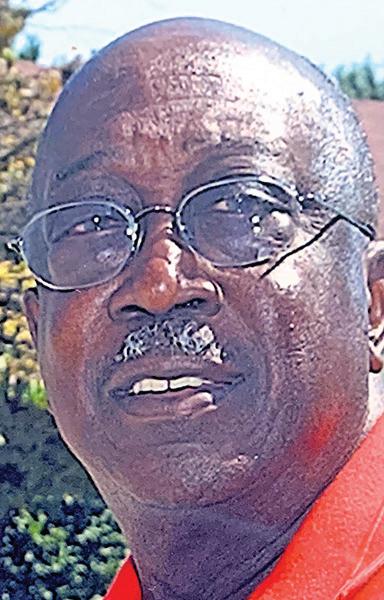
Funeral Services will be held at Prince of Peace Missionary Baptist Church on Sunday, August 30 for Vitilas “Veto” Reid, who peacefully passed away Sunday, August 16 at the age of 91. Visitation is at 2 p.m. and services at 3 p.m. Masks must be worn and social distance maintained. Reid faithfully attended Prince of Peace, 9350 Natural Bridge Rd., for more than 75 years. Reid was a trailblazer in the United States Postal Service, where he served for 52 years. He was the first African-American postmaster in Godfrey, Illinois and in St. Charles.
n In 2004, the Normandy Post Office was renamed and designated as the Vitilas “Veto” Reid Post Office.
“He also played a prominent role in helping to blaze the trail of substantial opportunities for the next generation,” said retired Congressman Bill Clay, his lifelong friend. In 2004, the Normandy Post Office was renamed and designated as the Vitilas “Veto” Reid Post Office. In 2006, his 52 years of service was entered into the Congressional Record.
“Veto Reid is someone whose lifelong friendship and support I will always cherish and remember,” said U.S. Rep. Wm. Lacy Clay, who sponsored the legislation to honor Reid with naming the post office and the congressional recognition. Reid also was the first African
See REID, A6
Beloved singer and performer Lamont Hadley Sr. recently succumbed to the coronavirus.
Diversity, Equity & Inclusion

David Dorn’s daughters oppose RNC appearance
‘She should not politicize our
Trump’s agenda’
By Chris King Of The St. Louis American
David Dorn’s daughters want it known that their late father did not support President Donald Trump and would not want his name or image to be used to further Trump’s political agenda. They are angry that their father’s widow, St. Louis Police Sergeant Ann Dorn, is scheduled to speak on Thursday, August 27 at the Republican National Convention.
“We know his wife is a Trump supporter, but he was not,” said his daughter, Debra White, a quality assur-
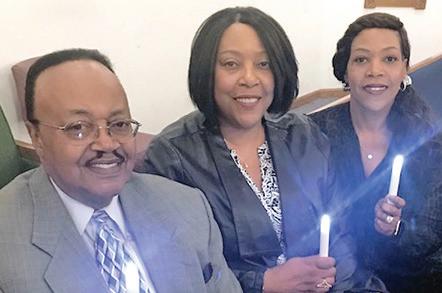
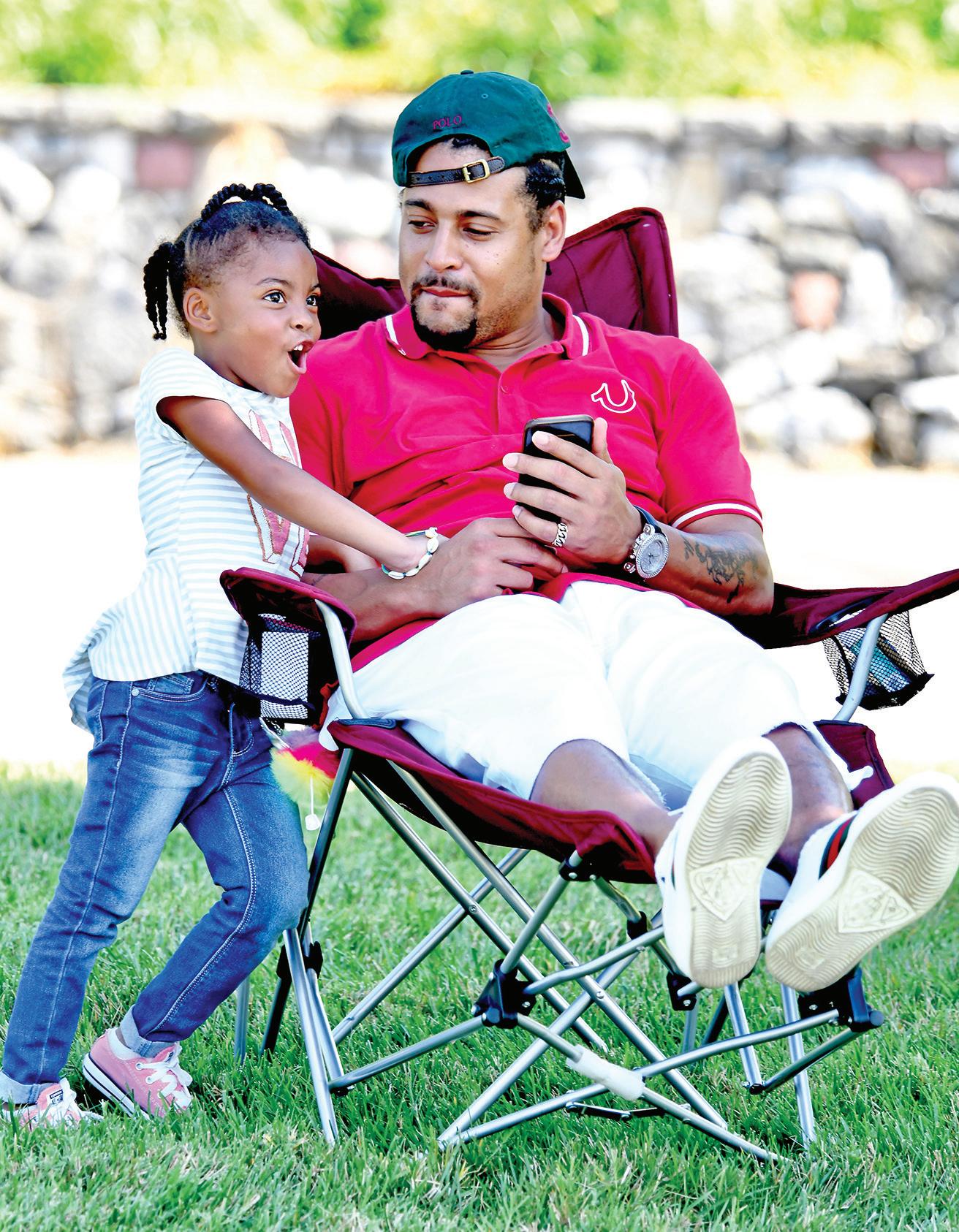
Tuesday, August 19.
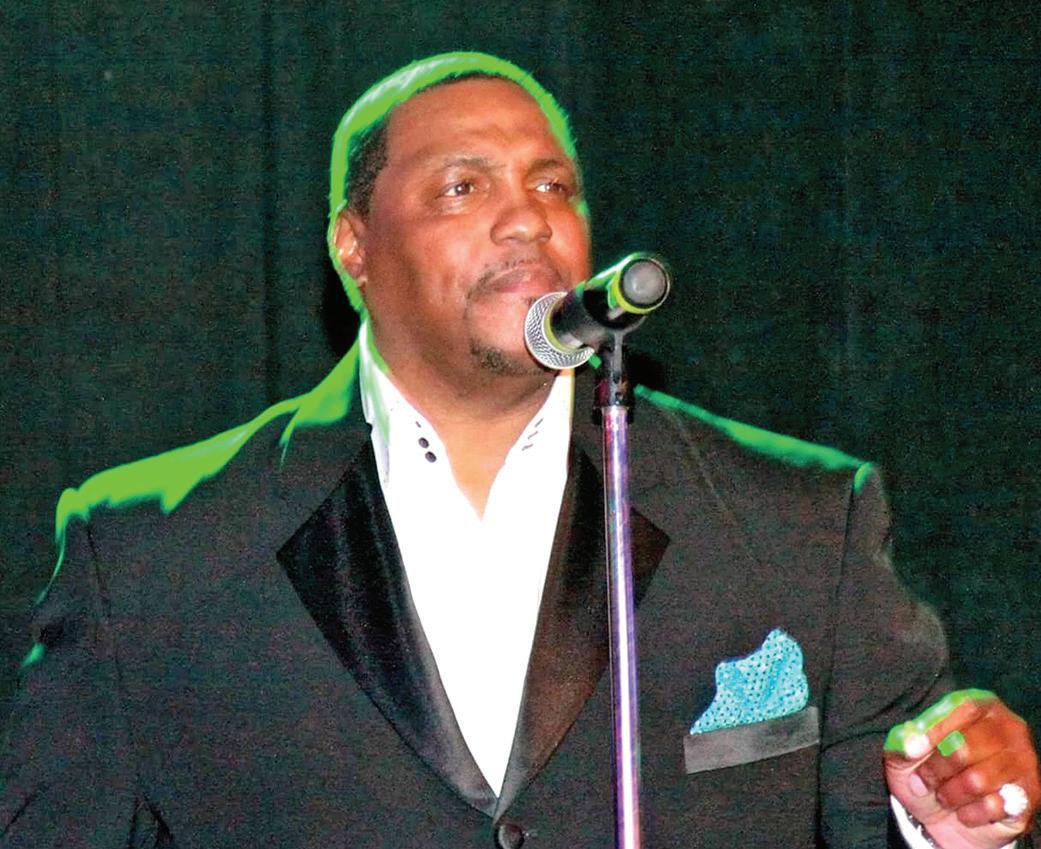
County police commander responds to Commissioner Dr. L.J. Punch’s suggestions
By Rebecca Rivas Of The
St. Louis American
In a recent letter to St. Louis County Police
Chief Mary Barton, St. Louis County Police Commissioner Dr L.J. Punch outlined action steps in six areas of concern: training, diversity and inclusion, transparency, evaluation, use of force and protests. Punched said that the recommendations are based on the Ferguson Commission report, U.S. Department of Justice report, Homegrown STL and the St. Louis Violence Prevention Commission, as well as the Ethical Society of Police.
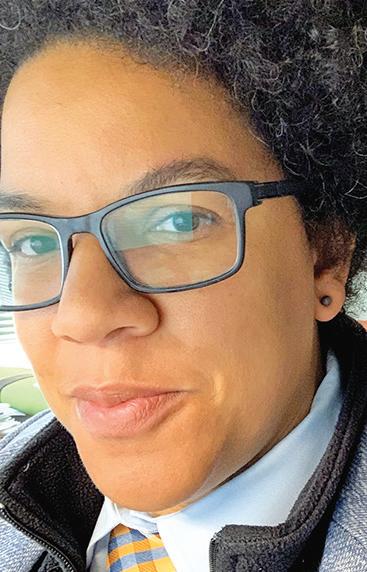
During the Board of Police Commissioners meeting on August 18, Lt. Colby Dolly, commander of the Bureau of Research and Analysis, responded to several of the use-of-force suggestions Punch made. However, because of the poor audio of the Zoom recording, the public could not hear his responses.
The American discussed Punch’s recommendations with Dolly, who oversees policy development, grants, crime analysis, and accreditation.
Punch: Rather than simply reviewing the useof-force policy, we must allow explicit sharing
Losing Lamont Hadley Sr.
COVID-19 takes from STL a beloved singer
By Sylvester Brown Jr. Of The St. Louis American
Black Americans have been hit hard by the coronavirus. Nearly 1 in 3 Blacks know someone firsthand who has died from the virus, compared to 9 percent of whites, according to a Washington Post poll. According to the Kaiser Family Foundation, Blacks are 11% of Missouri’s population yet account for 32% of the state’s coronavirus deaths. Although more than 56,000 blacks have succumbed to the virus, most of the deceased are unknown outside their circles of family and friends. This is not the case for thou-
sands in St. Louis who recently learned that beloved singer and performer Lamont Hadley Sr. had succumbed to the coronavirus.
St. Louis’ live entertainment scene in the late 1980s and ‘90s was robust. Hadley’s rise to fame came at a time when St. Louis and East St. Louis clubs like the Ambassador, the Max, St. Louis Nites and Broadway’s featured live performances. The bookings of local groups and solo artists such as Plush, Transit Authority, Velvet, Marty Abdullah and Julius Williams guaranteed packed houses.
with
Photo by Wiley Price
Macy Weeden 3, enjoyed time with her dad Matt Weeden in the Muny parking lot in Forest Park on
David Dorn, Debra White and Lisa Dorn
Photo by Wiley Price
Photo courtesy of Lamont Hadley Sr. Facebook
Vitilas “Veto” Reid

R.I.P. to Chi Chi DeVayne of RuPaul’s Drag Race
TMZ reports that of “RuPaul’s Drag Race” is dead at age 34. The fan favorite whose real name was Zavion Davenport recently hospitalized and died Aug. 20 of pneumonia, according to DeVayne’s family. DeVayne was also hospitalized in July with kid ney failure related to scleroderma, an autoimmune disease DeVayne was diagnosed with in 2018. While undergoing dialysis, DeVayne posted, “I let it go too long without going to the doctor and these are the consequences.”
RuPaul is said to be heartbroken over Chi Chi’s pass ing, but “grateful that we got to experience her kind and beautiful soul.” RuPaul said, “She will be dearly missed, but never forgotten. May her generous and loving spirit
shine down on us all.”
Third person arrested in alleged murder-for-hire plot
Nellyville producer Waiel “Wally” Yaghnam, 42, is the third person indicted in connection with the alleged murder-for-hire plot that took the life of Andre Montgomery, the grandson of Sweetie Pie’s owner, Robbie . He was killed in St. Louis on March 14, 2016. Authorities say Yaghnam was the insurance agent who worked with Montgomery’s Tim Norman, to fraudulently obtain $450,000 in life insurance on his 21-yearold nephew. Yaghnam is charged with conspiracy to commit wire and mail fraud after he allegedly made false statements on life insurance applications for Montgomery, prosecutors allege. Norman, of Jackson Mississippi and Terica Ellis of Memphis, Tennessee are also charged in the case.


John Gray FaceTimes himself into another cheating scandal
In a recorded video
posted on unWinewithTashaK, South Carolina Pastor John Gray is in another high-profile cheating scandal. This time, as an apparent two-timing FaceTimer, complaining to his side chick, a woman named “Mary,” that his wife Aventer Gray doesn’t cook and feeds their son pizza every day (co-signed by son who apparently was present during the recording).
Texts purportedly between Gray and Mary show him offering to pay her $200 to put her voluptuous cleavage that was nestled in a pink two-piece on display for him. Another video shows Gray offering a Cabo rendezvous for the two of them, promising a feast that beckons one’s most carnivorous tendencies. After news got out, black social media went bananas – or let’s say, “brisket,” and Gray’s lawyers now claim he is being extorted by the woman in question. TashaK posted that the wife was threatening her instead of her hubby, whose last public cheating scandal was in 2019.
Four R. Kelly associates charged with making threats
Singer R. Kelly’s manager, Donnell Russell was recently charged for allegedly making a threatening phone call in December 2018 to a Manhattan theater, halting the screening of “Surviving R. Kelly,” which is about allegations against Kelly about the sexual abuse of minor girls and women.
Russell is charged in two counts with threatening physical harm by interstate communica-
NOW HIRING ESSENTIAL WORKERS
tion, and conspiracy to do the same, according to the U.S. Attorney’s Office, Southern District of New York. “Threats of gun violence aimed at intimidating and silencing victims of sexual abuse are unlawful as well as unacceptable,” acting U.S. Attorney Audrey Strauss stated. “We are committed to aggressively investigating and prosecuting such crimes.” Each charge carries a maximum penalty of five years in prison.
R. Kelly is jailed and charged with sex crimes in Illinois and New York.
Additionally, as CNN recently reported, three other men thought to be R. Kelly associates are charged in separate schemes to to harass, bribe and threaten witnesses in the federal racketeering case against Kelly, authorities allege. The U.S. Attorney’s office in Brooklyn identify the trio as Richard Arline Jr Donnell Russell and Michael Williams
“The defendants are separately charged with engaging in multiple crimes that were intended to undermine and subvert the integrity of the criminal justice system and victimize the women who have come forward with serious allegations of criminal conduct against the defendant R. Kelly,” Acting United States Attorney Seth DuCharme stated.
To CNN, Steve Greenberg, an attorney for R. Kelly, denies his client’s knowledge or involvement in the allegations.
Sources: CNN, Greenville News, HipHopWired, Instagram, The Grio, The Hollywood Reporter, TMZ, Twitter, unWinewithTashaK, Upnewsinfo.com, Washington Post

Have







John Gray
These are the children Missouri wants to try as adults
An at-risk youth mentor testifies to legislators who want to try 12-year-olds as adults
By Stephanie Acon For The St. Louis American
I have been an at-risk youth mentor in the City of St. Louis for going on three years now, and I have seen a lot concerning the troubled teens in our region. Some of the particulars include disturbing environments, lack of safe havens, illiteracy, trauma and abuse, mental health neglect, undiagnosed disabilities, teen homelessness, parental abandonment, teachers failing children, politicians failing children, society failing children – and, saddest of all, kids raising themselves. I’ve seen it all with my own eyes. Specifically targeting courtinvolved youth, I have run a faith-based program in the Juvenile Detention Center in St. Louis. I also go into homes in the worst areas. I go into abandoned buildings, and I do one-on-ones with some of the most troubled kids in the area. In doing this, I have developed a compassion and understanding concerning youth involved in crime.
age. Who are the children in the criminal justice system?
Jeron Lemmitt is the 18-year-old charged in the Galleria Mall shooting. The crime that he committed was wrong. However, did you know that Jeron’s mother was murdered in front of him by her boyfriend, only a few years ago? Jeron witnessed the whole thing. I met Jeron in the Juvenile Detention Center when he was 15 years old. I talked with this young man face to face. I had to ask him several times to speak up, because his voice was very low. He almost mumbled his every word as if he were talking to me but at the same time, lost in thought.

Stephanie Acon
Here are some of their stories. I’m hoping that these testimonials will provide a deeper insight into the lives of these minors. They help explain why I believe it is morally right and fundamentally necessary to treat these children with youthappropriate services, provide age-appropriate interventions, keep these children in youthappropriate facilities and raise the age when a child can enter the adult criminal justice system—instead of lowering the
Days
He explained to me almost immediately, what happened to his mom. During our conversation, I felt compelled to tell this child these words, “Jeron, Jesus loves you” and instantly, tears filled his eyes. We read some literature together, and I asked him who he talks to while in isolation. (Yes, isolation.) He said himself, God and sometimes a chaplain.
I never forgot this child. I asked about him because I wanted to personally mentor him outside of my program; however, he was released from the youth facility before I could get back to him. I wrote his name on a prayer cloth and put it up. A few days before the mall incident, I was walking down the hall of my home when he crossed my mind— heavily. Immediately, I started

searching for the handkerchief where I’d written his name. Unfortunately, I could not find. A few days later, I looked up and saw his picture on the news.
Ramon White is an 18-yearold charged with attempted carjacking and shooting. He is not new to the system. In 2017, when he was 15, he was charged with the killing of another 13-year-old. He was pulled from the Juvenile Detention Center and certified as an adult; however, he beat the case in 2019. I helped to co-mentor this youth along with his primary mentor (“Ms. Shellie”). We visited Ramon in both the JDC and the St. Louis Justice Center—where they had him isolated, with no educational or behavioral programming appropriate for his age, nor could he receive up-close visits. Ramon was very suicidal, mentioning repeatedly that he wanted to take his life. Thankfully, his primary mentor coached him through it. We asked Ramon what it is that he most wanted to do with his life. His answer: “I want to join the Army. I want
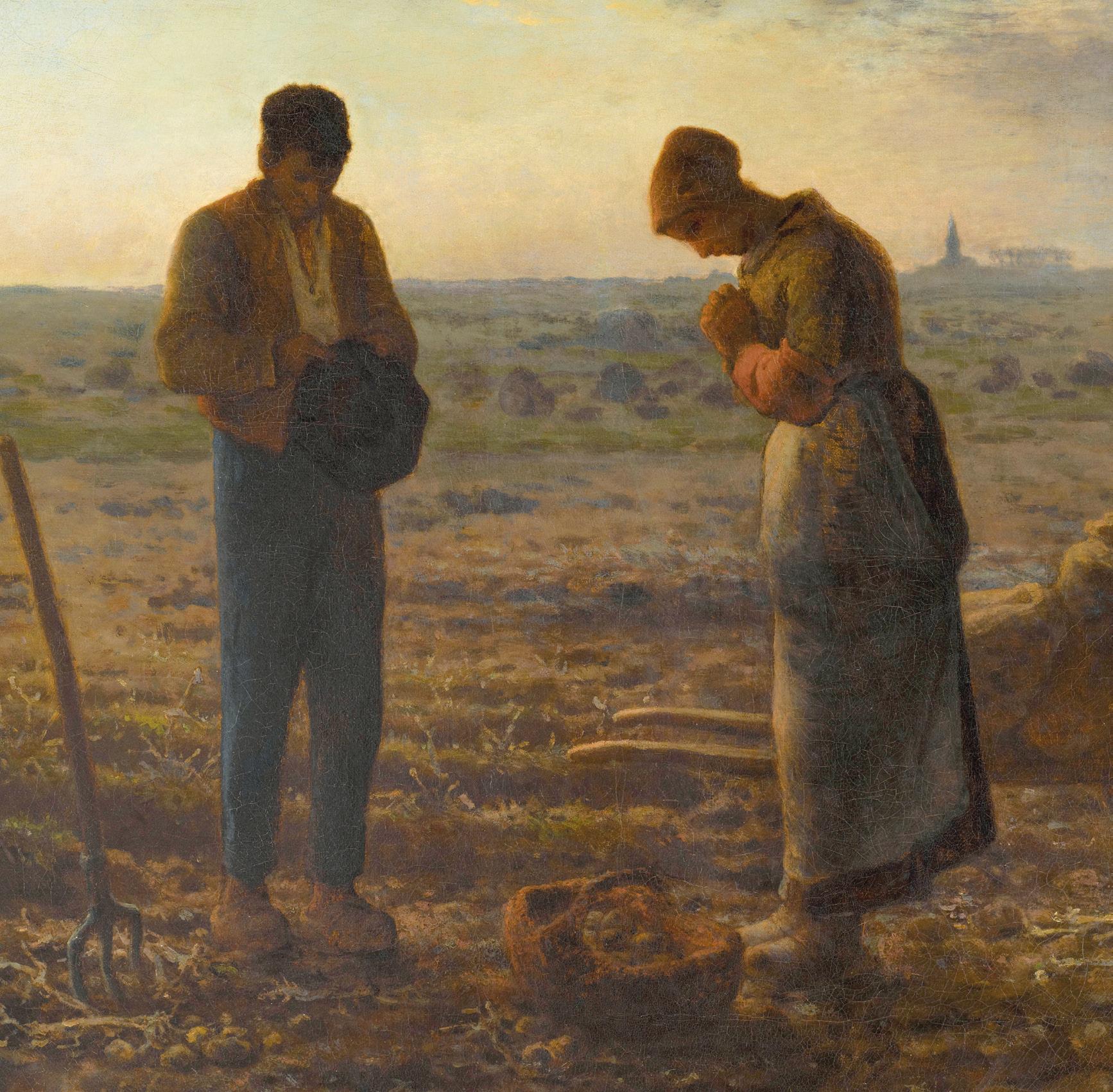
to retire from the military.”
When Ramon’s release began approaching, I personally went into an Army recruitment office and explained that I needed help for this child. I talked with soldiers, as well as sergeants. I informed them that Ramon needed to be off the streets and out of his home if he was going to survive.
The sergeant that I’d spoken with told me that they could get Ramon “out of here” in under two months. He just needed to take a GED test and two other tests. He’d also need his mother’s approval because he was only 16 at the time.
Once Ramon was released, his primary mentor went to his home and saw a high level of adult dysfunction. There was no respectable authority present, and there was a lot of drug usage. The mentor informed Ramon’s mother that we wanted to get Ramon tested and recruited into the Army. Ramon’s mother answered, “No son of mine is going into the military.”
And, just like that, we lost Ramon to the streets. He could not stay off drugs because his household filled the air with
it—and he could not complete any continuing education classes because he could not focus due to distractions of his own home and neighborhood environments. The last time I spoke with Ramon was when I received a tip that he was in the park about to commit suicide. I called his phone and asked him if he wanted to talk. He said, “Yes.” I asked what was bothering him, he said, “I don’t have a place to live.” Not too long after, Ramon was on the news.
Marcus Ursery is a 14-yearold who will be tried as an adult for the murder of another 14-year-old. I also met Marcus in the Juvenile Detention Center, but recently he was moved to an adult facility.
Marcus faces adult charges for a very serious crime. But did you know that Marcus dealt with a lot of homelessness, parental neglect, poor literacy and education?
The court claimed in its language that this child was “mature” and able to stand competent as an adult. Well, the truth is, this child is not mature at all and is very much a child. He has not had the
focus, stability, or structure needed to gain sufficient education or proper mental development due to his circumstances. Physically, he is small, and I wonder how he would be able to survive living around grown men in a prison. My heart aches! Marcus needs stability, guidance, and education. And he needs trauma and mental health support—not prison time in an adult facility facing jail time for three times the years he’s been alive.
Then there’s another 14-year-old whom we call Meko. Meko dealt with parental neglect (absent father and a mother who was rarely home), which led to him into trouble. As a result, he had to spend some time in the Juvenile Detention Center. Sadly, not long after Meko was released, his mother was shot in their home, allegedly by her boyfriend. During the shooting, Meko hid. After the shooting, when he went to look for his mother, he could not find her. He only saw blood on the mattress. After searching around, Meko found his mom—dead behind the house.
These are just some of the more recent stories that you may have seen publicized on the news. However, there are many more cases and stories concerning court-involved youth that I have encountered. In sharing these stories, I want those in charge of policies and legislation to truly understand that these are children – children in need of help, not long-term jail time. They need advocates, mentors, and youth transformation homes—not adult prison sentencing. Please remember that these are children, not yet developed—ask any doctor, ask any scientist, ask any mentor and child advocate.
Edited from testimony made before the House Committee on the Judiciary on Monday, August 10.
Extended through September 7
French artist Jean-François Millet (1814–1875) inspired many other famous artists including van Gogh, Monet, Munch, and Dalí. You won’t want to miss van Gogh’s Starry Night coming to St. Louis from the Musée d’Orsay in Paris, and then view Millet’s Starry Night painting that served as van Gogh’s inspiration.
#MilletandModernArt
Guest Columnist
Editorial /CommEntary
Republicans are selling Black pain and death – don’t buy it

Republicans in our state and nation’s capitals are selling Black pain and death – and, in particular, Black St. Louis’ pain and death. We must not let them profit from our pain and death.
Missouri Gov. Mike Parson and Attorney General Eric Schmitt are trying to capitalize on the demonization of St. Louis Circuit Attorney Kimberly Gardner, whose job, like that of any prosecutor, is rooted in pain and death – in the City of St. Louis, that is mostly Black pain and death. These two Missouri Republicans, neither elected to his current position, are working together in a special legislative session (thus far, without success) to usurp Gardner’s authority. However, the people who, unlike Parson and Schmitt, actually have a say in the matter, according to our democratic process, just elected Gardner for the second time by a wide margin. Violent crime in St. Louis is, indeed, at a crisis level, but city voters forcefully rejected these outsiders’ assessment that the city’s first Black chief prosecutor is the problem.
In our nation’s capital, our disgraceful president, a former casino mogul, is gambling twice that he can make Black St. Louis pain and death pay off for him at the ballot box on November 3. Trump’s Republican National Convention is hosting both the publicity-seeking McCloskeys and the widow of slain retired Black police captain and chief David Dorn. The messages for these Trump boosters also are based in Black pain and death. Gardner is prosecuting the McCloskeys for pointing weapons at peaceful Black Lives Matter protestors who passed by their mansion. David Dorn was slain by looters who took advantage of the chaos following a long night of police brutality protests. The messages of the McCloskeys and St. Louis Police Sergeant Ann Dorn, David’s widow, is that only Trump can save America from the Black Lives Matter mob and its white anarchist allies. Don’t buy it.
Democrats, at their best – and this includes progressive prosecutors like Gardner – stand for and push policies that address and alleviate Black pain. Republicans just sell it for political gain – and pass policies that deepen it. Parson may have failed to undermine Gardner’s elected authority with the unelected (in every sense) power of Schmitt, but the governor and the Republican-dominated Legislature did succeed in rolling back criminal justice reforms – and will
not rest in their destructive efforts unless they are removed from power.
Meanwhile, in St. Louis, where all this Black pain and death are coming from, voters are moving in the direction of righteous anger and positive change. How else to explain Gardner’s trouncing of her opponent? How else to explain the growing support for the Black Lives Matter movement, despite the property destruction (and tragic killing of David Dorn) that sometimes happens in the wake of protests? In St. Louis, more and more people seem to be waking up to the reality of Black pain and death and the urgency to force positive changes in how we approach crime – which is to say, how we approach poverty.
We think back to the Dred and Harriet Scott case, where an all-white St. Louis jury – this fact is too often overlooked – decided to free the Scotts from enslavement. That humane decision of good conscience was overturned in the state capital, a decision that was upheld in our nation’s capital. A brewing Civil War quickly ensued.
The St. Louis vote and voice for Black freedom and well-being must not be overturned in Jefferson City or Washington, D.C. this time. It’s time to write a new chapter where the humanity and good conscience of St. Louis prevails. Reaffirming the promise of a positive change in criminal justice by reelecting Gardner should be only the beginning. On November 3, Trump and Mike Pence will face Joe Biden and Kamala Harris. Parson will face Nicole Galloway. Schmitt will face Rich Finneran. Secretary of State John “Jay” Ashcroft – the state’s chief election authority, who is only helping the Trump administration disenfranchise urban voters – will face Yinka Faleti. There are other consequential elections on the November 3 ballot.
Some of these Democratic challengers are not well known to voters. Others were not the first choice for St. Louis’ increasingly progressive electorate. But these Democrats all represent clear and decisive improvements upon the Republican incumbents, and electing them will forestall more repression and destruction. We must mobilize our vote in large numbers if we want to address and alleviate Black pain and death, and not just allow Republicans to continue to exploit them for votes.
Black politics in a time of revolution
By Joshua Peters For The St. Louis American
Aristotle often linked the politician to a craftsman. The analogy is vague because politics, in the strict sense of legislative science, is a practice of practical knowledge, while a craft like architecture or medicine is a form of productive knowledge.
Aristotle, where are you now? The Congressional Black Caucus unified its forces to get a Democratic-controlled House of Representatives to pass an omnibus police reform bill, even naming it for George Floyd. But knowing it would never see the light of day in the Republican-controlled Senate, nor gain a signature from the most overtly racist president in our lifetime, it failed to assuage many. A new generation of Black leaders has emerged who came of age during the Michael Brown protests. They challenged the old order. Black establishment Congress mem-
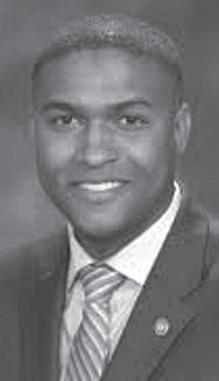
bers are not necessarily out of step with their younger challengers, but rather, have become out of tune. The St. Louis establishment has erred on the side of practicality: to wait for seniority to put increased power in their hands, to compromise, to achieve measured change. No longer will Black politics operate in this way. Locally, as in many parts of the nation, a younger generation of Black leaders is emerging and making waves. We see it in the young fresh faces of many members of the Missouri General Assembly, of new state Senator Steve Roberts, of new St. Louis County Prosecutor Wesley Bell. We see it in the reelection of St. Louis Circuit
By Clem Smith For The St. Louis American
In the middle of a pandemic, the so-called leaders who are supposed to guide us through this deadly virus – one that is disproportionately infecting and killing Black Americans, capitalizing on years of systemic inequalities – are spending their time trying to lock up kids, attacking Black prosecutors, and making it harder, and more dangerous, to vote. You’ve been told this over and over, but it bears repeating. This November 3, the stakes could not be higher.
It’s everyone’s right to safely cast their ballot. It’s unbelievable that this is a position some consider controversial. If they truly believed in that value, as they claim, Secretary of State Jay Ashcroft, Governor Mike Parson, and the super majorities in the Missouri House and Senate would have made voteby-mail easily accessible and it wouldn’t take a flow-chart to figure out how to legally vote. But here we are. The new vote-by-mail laws are ineffective. Currently, the law requires many voters to get their absentee or mail-in ballots notarized. Not only is it already hard enough to find a notary willing to notarize your ballot for free, but some banks and other places that offer notarizations are also requiring you
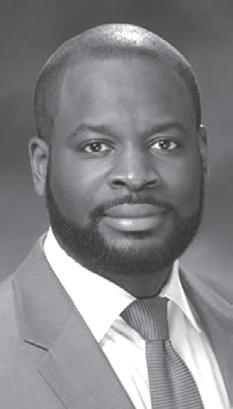
to schedule an appointment, because of the fear of spreading the coronavirus. This is just another hoop to jump through that politicians think will keep you from exercising your constitutional right to vote. But there is another option. Instead of choosing to voteby-mail, request an absentee ballot instead. Voting absentee can be done in-person by dropping your ballot at your election authority’s office or through the mail. It’s the safest and most secure way to vote during the COVID-19 pandemic.
We’ve heard and seen that President Trump is attacking our right to vote by working to slow the United States Postal Service, so it’s best to request your absentee ballot now. When you request your ballot, choose the second option if you are sick or worried you may contract COVID19 (Confinement due to illness) or the last option if you’re at risk for getting COVID19, including by being over 65 or immunocompromised. Critically, these options don’t require a notary like the other options.
Letters to the editor
Witness Missouri history
If Angela Walton Mosley is successful in winning election to be Missouri Senate in the November general election and sworn into her first term as a Missouri state senator and her husband, Jay Mosley, is sworn into his third term in the Missouri House of Representatives, they will be the first husband-wife team ever to be elected to and serve in the Missouri Legislature at the same time.
Angela received the Democratic nomination in the August primary and faces token opposition from a Libertarian in the heavily Democratic 13th State Senate District. Angela is the daughter of former seven-term Missouri State Representative Elbert A Walton Jr. Her stepmother, Juanita Head Walton, and sister, Rochelle Walton Gray, both previously served four terms each in the Missouri House of Representatives as well.
City to witness history
Elbert A Walton Jr. St. Louis Accountability – not intimidation
The people of the City of St. Louis deserve accountability and focus on real issues – not intimidation. The petition drive by St. Louis Lambert International Airport privatization special interests to recall 20th Ward Alderwoman Cara Spencer is an attack on our democracy, and it will not be tolerated. We must reject any and all attempts to threaten or harass elected officials who stand up to special interests, period.
St. Louis Comptroller Darlene Green St. Louis
Open letter to Senators Blunt and Hawley
Attorney Kimberly Gardner. We see it in the upset of Congressman Wm. Lacy Clay by Cori Bush.
While Clay had delivered much to the community, he was dependent on the old sources of political money which tied him, for better or worse, to what was seen as the establishment in a time of revolution.
The status quo of being in a state of stasis is no longer acceptable. Despite the rise of Black elected officials in many of the nation’s largest cities and counties, the inability to qualitatively change the lives of their constituents must be at the forefront of public discourse. To do less would be to continue the great disconnect and betray the future.
As for Aristotle, it’s evident in such a diverse socio-political era that the masterpiece of the craftsman has turned into a shameless creature who is laughing at its creator.
Joshua Peters is a former Missouri state representative.
Her brother-in-law, Alan Gray, will be sworn in to his third term along with Angela and Jay as well. That historic occasion will occur at noon on Wednesday, January 6, 2021. Mark the date in your calendar and be in the Missouri State Capital Building in Jefferson
According to U.S. News and World Report, President Trump threatened legal action after the Nevada legislature advanced a bill that would allow for the state to mail ballots to all voters for the November 3 election, joining other states in expand-
Once you receive your ballot, fill it out as soon as you can. If you want to mail your ballot in, try to make sure it’s in the mail no later than October 20. With the attacks on the USPS, there’s no guarantee it’ll be received in time if you send it later than that.
If you don’t receive your ballot in time or you can’t send it by October 20, fill it out, hold on to it, and walk your ballot into your local election authority before 7 p.m. on November 3. If you are unable to request an absentee ballot, you’re allowed to go to your local election authority and simultaneously request and cast it then and there. Voting absentee in-person helps keep long lines and crowding down on November 3 and is the safest way to vote in person. In-person absentee voting is available at your local election authority from September 22 through November 2. Make sure you wear a mask to help protect yourself and your community. We can’t sit back while politicians rig the system. Your vote is your voice.
All letters are edited for length and style.
ing access to mail-in voting amid the coronavirus pandemic. The bill was passed narrowly in the Nevada Senate. It is intended to allow voters to “have faith and confidence that they can participate in the affected elections and exercise their right to vote without fear for their health, safety and welfare,” according to the bill’s language. Trump took to Twitter to decry the legislature’s action, retweeting an image shared by Republican National Committee Chairwoman Ronna McDaniel of protesters in Nevada.
“Post Office could never handle the Traffic of Mail-In Votes without preparation,” Trump tweeted. “Using Covid to steal the state. See you in Court!”
As your constituent, I am urging you and your fellow Republican senators to protect our right to vote. My wife and I and many other senior citizens have been staying at home during this pandemic except for essentials such as groceries and medical needs. We shouldn’t have to risk our health to vote when there is another option such as voting by mail. Do not suppress our right to vote. Ross Caravelli Florissant




Guest Columnist Clem Smith
Guest Columnist Joshua Peters
A scene from the 2020 Republican National Convention.
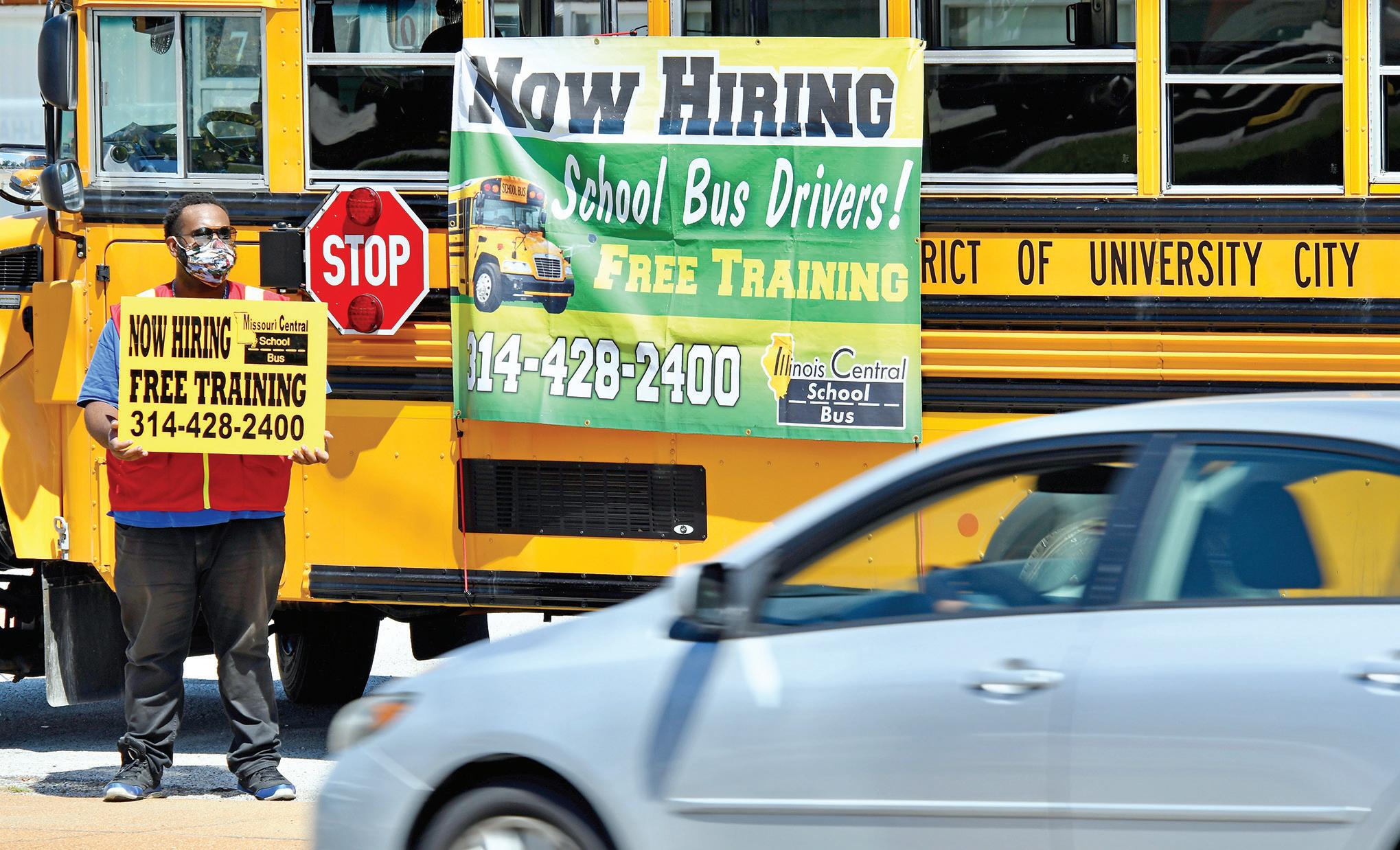
Hiring school bus drivers
Oct. 1 deadline to apply for service academies
U.S. Senator Roy Blunt is accepting applications from Missourians interested in attending service academies. Nominations to the U.S. Air Force Academy, U.S. Merchant Marine Academy, U.S. Military Academy, and U.S. Naval Academy are available for qualified applicants.
Applicants must be between 17 and 23 years of age, U. S. citizens, and legal residents of Missouri. A committee of Missouri residents will review applicants’ files and present their recommendations to Blunt for a formal nomination in January. Nominees will be evaluated using the “equal and competitive” method for
selection and on the basis of personal merit, including evidence of character, leadership, scholarship, and motivation.
Apply on the Academy Application Process page of www. blunt.senate.gov at https://tinyurl.com/Blunt-service before October 1.
The academy nomination process requires that students first open an application directly with the academies of their choice and then begin the nomination process with their congressional offices. For more information please contact Blunt’s office at academy_ nominations@blunt.senate.gov.
August 31 deadline for Ernest J. Gaines Literary Award
Black writers have until Monday, August 31 to apply for the 14th annual Ernest J. Gaines Award for Literary Excellence. Presented by the Baton Rouge Area Foundation, the Gaines Award was created to honor outstanding literary work from rising African-American authors while recognizing Louisiana native Ernest Gaines’ extraordinary contribution to the literary world. This Gaines Award will honor outstanding fiction – novels or
short-story collections – published in 2020. Galleys for 2020 publications are also accepted. The winner is chosen annually by a panel of professional writers and academics. Information on criteria and entrance forms for the award, which includes a $15,000 cash prize, is found at www.ernestjgainesaward.org.


Black lives and the White House
By Pat Allen For The St. Louis American
WASHINGTON, D.C. – Sitting here staring at the image of 16th Street in Washington D.C., I can only view it with pride. The reason is because I am hoping that the events of the last couple of months, along with these words leading right up to the White House, is an indicator of future systemic changes in our government and the occupants of this historic building.
Why would I say this? Because the literal White House was built on the backs of free and enslaved African Americans. The Black Lives Matter street leads up to the front door of the White House.

A little known fact is that when looking for workers to build the White House, our government was looking to acquiring workers from Europe. In our minds we may have formed an image of white men on scaffolding, building what would become home to our president and his family. The builders settled on the usage of African Americans, who was plentiful, due to the importation prior to January 1, 1808, followed by domestic breeding of slaves, as if they were animals. This is a tragic fact, not fake news. African Americans were the bulk of the workers, but not the only workers, who built the White House. People of all races were commissioned to get the job done. They were just as the modern protesters in Washington, D.C. were, a hodgepodge of all people coming together to begin to accomplish a goal.
The goal now is not that of Donald Trump bogus throwback saying, Make America Great Again. The goal of those marching was to make America truly great for the first time in our history by bringing about systemic changes, especially in our criminal justice system, now and in the future, not by reverting to a fantasy of the past.
Why have so many people never heard of this? It has not been known because it has never been taught. American history as taught in most schools is just that, his story, the white man’s story. It is not the true story of this country, America’s history. Historians have long known and acknowledged the role played by Blacks.
The myths and fake news are the denial of the fact that all races have played roles in developing this country, but especially the Black race, who had no decision in how they came here or the work ahead of them. This country was built on the sweat, blood, stripes and tears of our Black mothers and fathers, for little or no money.
It is only fitting that the words on the road leading up to the White House proclaim, Black Lives Matter. Their lives mattered when constructing it, and they do now. I love to think of Donald Trump waking up in a mansion built by African-American men and women, with the verbiage on the street running vertical to it stating, Black Lives Matter. This is the truth not a myth, a fact not an alternative fact.

Pat Allen
Photo by Wiley Price
Shawn Robinson, a 13-year veteran at Missouri Central School Bus Company, stands at the intersections of Olive Boulevard and Purdue Avenue looking to train drivers for free in the University City School District on Friday, August 21.
of the statistics regarding the department’s use of force, reported by race and gender and location and disaggregated.
Dolly: The key word in that first sentence is that it’s “disaggregated.” We do share aggregated data. We publish a report every year that says how many total uses of force we have and what kind of forms it was. So, I’m all for sharing data. We can share the disaggregated data to a point. Think of it like crime data. You see a map of points where a crime occurred. You could do a similar type thing with use of force incidents. You’d just have to limit who was involved — the officer or the citizen — you wouldn’t want to share that information.
The American: So you could report it just like you do for regular crime statistics, but also break it out into race and gender. How difficult would that be?
Dolly: It wouldn’t be real difficult. I think the interpretation of it can be difficult. Let’s say three officers go to a call, and three of them use physical force. That’s one incident. We could count it that way, but what if they used force on two people? Now is it two incidents? It’s a national problem of standardizing how you count these things. On the one hand, if we put this stuff out there and then our accounting system is more broad and we count more, then the uninformed consumer of the data could say, “Oh my gosh, St. Louis County is out of control!” When really, it’s the way we are counting it.
Punch: It has been stated that the #8cantwait guidelines have already been embraced by the St. Louis County Police Department, which are as follows. 1. Ban chokeholds and strangleholds 2. Require de-escalation 3. Require warning before shooting 4. Require
exhausting all alternatives before shooting 5. Duty to intervene 6. Ban shooting at moving vehicles 7. Require use of force continuum 8. Require comprehensive reporting. Under the department’s use-of-force policy, it states, “If feasible, a verbal warning shall be given prior to the use of deadly force.” The word “if” is a loophole and should be removed, as any action without warning can be allowed due to the presence of this two-letter word.
Dolly: I don’t necessarily agree with that assessment of it. The whole issue of giving a warning “if feasible,” part of that came from a Supreme Court case Tennessee vs. Garner in 1985. But the issue then becomes if you were to make officers give a warning every time before they use deadly force, it potentially could become dangerous for citizens or the officers. If someone starts shooting at you, they are not going to have time or the mental capacity to give a warning.
Punch: Department policy: “Where deadly force is not authorized, officers should assess the incident in order to determine which non-deadly technique or less lethal weapon will best de-escalate the incident and bring it under control in a safe manner. Only the appropriate amount of force necessary to bring an incident under control is authorized. In making an arrest, no more force shall be used than is reasonably necessary for the safe custody of the prisoner or for overcoming any resistance that may be offered and for ensuring the delivery of the prisoner into safekeeping. Officers are not authorized to use chokeholds, neck restraints, shoulder pins or similar weaponless control techniques with a potential for serious injury.”
While this does not permit chokeholds, it does qualify situations in which deadly force is not authorized as if it is the primary posture and de-escalation is a compromise rather than a primary posture. It does

not include decisive language to “exhaust” all efforts before lethal force.
Dolly: Actually, I see [Punch’s] point here. I will concede that our current use-offorce policy, the language can be improved. What I envision is that we do need to make it more clear, even in the layout of the policy, that the default starting position is that you don’t use any force. That’s where everything begins: we do not want to use force and we shall de-escalate as much as possible and exhaust everything reasonable before using force.
Punch: Department policy: “Every employee of this Department has the responsibility to immediately contact the Bureau of Professional Standards or the Department Duty officer and report any act which they believe involves the use of excessive force as described in this Order. Any employee who fails to report physical or verbal abuse against

any citizen by another member of this Department is subject to disciplinary action.”
The language “believe” and “excessive force” does not align with best practices in the requirement of reporting ALL use of force and even threat of use of force.
Dolly: We are talking about two different things here. There’s excessive force. That is something that is not condoned by the department. It’s misconduct. That has to be reported. It’s in our policies, but we can make it right up front that you have to report any excessive force or any misconduct.
The other part of it is “all use of force.” I look at that as something slightly different. Now we aren’t talking about misconduct, we’re talking about things that are authorized by the department. If you do anything that is outside normally handcuffing, that all counts as use of force, and that has to be reported. The only thing that we don’t report, that some other agencies do, is that you point your weapon at someone. But we are looking at changing that.
Continued from A1
American to serve as president of the St. Joseph Hospital Advisory Board and as a mem-
Photo by Wiley Price
Punch: Department policy: “The precinct watch commander or appropriate bureau commander must be notified immediately whenever an officer uses or attempts to use force under extraordinary circumstances.”
Again, this is open to interpretation of the word “extraordinary.” It has been stated twice that this policy has been reviewed since the DOJ evaluation; however, it is dated without edits from 2010.
Dolly: We will try to strengthen the language on that. Basically, there’s room for improvement.
The American: Would you then disagree with the tweet that was put out on August 19 at 4:38 p.m. on the St. Louis County Police Association Twitter page? It says, “@lj_punch we encourage you to take the opportunity to utilize our training simulators on use of force and generally educate yourself before peddling extremist viewpoints on policing based solely on opinion. This rhetoric puts officers at risk against violent extremists.”
ber of the St. Charles Rotary Club.
“He tackled problems and prejudices head on, whether it was for himself, family, or friends,” said his daughter Makeda Reid-Vales.
Among many awards, he

American Postal Workers Union President Rebecca Livingston spoke to supporters in front of the Main Post Office in downtown St. Louis on Tuesday, August 25. At left is Lew Moye, president emeritus of the St. Louis Chapter of the Coalition of Black Trade Unionists. Behind them are state Senator Karla May, St. Louis Treasurer Tishaura O. Jones and St. Louis County NAACP President John Bowman. The postal service is under attack by the Trump administration in advance of the November 3 election in an attempt to hinder voting. Trump has said that Republicans lose high-turnout elections.
Dolly: Wow, there is a lot to that. Do I think that Dr. Punch and other board members should go to our training simulators? Sure, as a general principle. I don’t think there’s any harm to it.
The American: What do you think about the “peddling extremist view points?”
Dolly: I don’t think all of them are aligned with best practices. I’m not going to say if they are extremist viewpoints or not. They are viewpoints that are somewhat different from what the police department views the world from, but I think it’s productive in a way to hear these things and address them directly. Sometimes I think things just need to be talked out.
The American: So, you would never say that Punch’s letter is extremist?
Dolly: No, I don’t look at it as extremist. It’s a perspective in the community, and I’m happy to respond to those different perspectives and viewpoints on how people feel in the community.
was honored in 2017 by state Rep. Chrissy Sommer (R-St. Charles) and the Missouri House of Representatives with the Hidden Figures Award. The award alludes to the 2017 Academy Awards Best Picture nominee, “Hidden Figures,” a docudrama about Black female mathematicians who worked at NASA during the Space Race.
“It was the story of my life,” Reid told The American in 2017.
Despite all of his accolades, Reid considered his greatest achievement to be marrying his wife, Bessie Luster, on February 17, 1968. “My wife is the key to my whole life,” Reid said.
Reid graduated with honors from Vashon High School in 1947. He was the vice president of his class and ran for the 1947 Championship Track Team. He was inducted into the Vashon High School Hall of Fame in 1991.
Reid went on to attend Stowe Teachers College and the University of Missouri at St. Louis before starting his U.S. Postal Service career in August 1951. “The post office was one of the prime jobs at the time,” Reid said. Although he moved to St. Charles, Reid remained active in St. Louis. He was the nephew of a co-founder of a North St. Louis icon, the MathewsDickey Boys’ & Girls’ Club, Hubert “Dickey” Ballentine.
“I have no regrets,” Reid told The American in 2017. “My life has been beautiful.” He is survived by his wife Bessie; daughters Quinita and Makeda; grandchildren Danielle, Devon, Taylor, and Steven; great-grandchildren Alona and Matthew; and greatgreat granddaughter Laila.
“Your love for your family was true, genuine and unconditional,” said his daughter Quinita Bruce-Cole. “You did your best for all of us, and I will always remember you.” – Tashan Reed contributed reporting.
Hadley
Singer James White met Hadley in the early ‘80s. A tenor like Hadley, White said his singing group, Plush, had a friendly rivalry with Hadley’s group, Master’s Touch. White likened St. Louis’ ‘80s and ‘90s Black music scene to the infamous Chitlin Circuit, where African-American musicians, comedians, and other entertainers made a living performing in the era of racial segregation.
While attending Vashon High School, Hadley joined the group Fire 5 in 1978. The group sang their own renditions of hits by the Temptations, the O’Jays and other popular male ensembles. By the mid1980s, Hadley’s new group, Rare Form became the opening acts for celebrities like Kenny Rogers and Sheryl Crow.
Hadley hit his stride in 1989, as part of the all-male vocal group Master’s Touch. The group sold out local venues with their smooth vocal stylings, energetic choreography and dapper, matching attire. Master’s Touch opened for legendary R&B singers and groups such as Peabo Bryson, Gerald Levert, and the Delfonics.
Music promoter Red Rooster grew up and attended high school with Hadley. The two were opposite personalities, but Rooster said they remained lifelong friends.
“Lamont had been singing since he was nine or 10 years old,” Rooster said. “We got really close as adults. I’d go
Dorn
Continued from A1
Continued from A1 ance analyst. “He frequently said they were not able to talk about politics, because they were at the opposite ends of the spectrum. I know he would not want his legacy to be for his death to be used to further Trump’s law-and-order agenda.”
There is irony and complexity to David Dorn not wanting to serve a “law-andorder agenda.” He was a retired St. Louis Police captain and Moline Acres Police chief who was killed at age 77 on June 2 when he interrupted the looting of Lee’s Pawn & Jewelry in downtown St. Louis following protests of the Minneapolis Police killing of George Floyd.
“His passion for law enforcement ran deep,” said his daughter Lisa Dorn, who works in e-commerce. “He was blue through and through, but he also was a man, a Black man, and he knew some not so
to his shows and rehearsals. Afterwards, we’d do the St. Louis and East St. Louis club scene. But Lamont was a good boy, a church boy. He didn’t drink or do drugs.”
Bridgette West, Hadley’s long-time girlfriend and mother of his son, Lamont Hadley Jr., 41, recalled how she met the shy, young singer in 1988.
“I was working in the pharmacy at Medicare Glaser Drug store. My brother told me there was this guy he knew who liked me, but I never met him. Lamont would come into the store and always buy the same thing – a grape soda and a (Hostess) Suzy Q,” West said.
“Even though there was a cashier up front, he’d always come all the way back to the pharmacy to check out. Then one day, he asked for my phone number. We’ve been together since then for 32 years.”
In 2002, as part of the group L.L.C., Hadley recorded a CD titled “Guaranteed for Love Making.” In 2006, Hadley formed his own group, Lamont and The Hadley Band, and recorded an album titled “It’s Been A Long Time Coming.”
On Hadley’s Facebook page, hundreds of fans shared their condolences and memories of their favorite Lamont Hadley Sr. performance or song. For West, her soulmate’s rendition of Dee Harvey’s “Leave Well Enough Alone” will always be her all-time favorite. Their son, Lamont Jr., said Sam Cooke’s “Change is Gonna Come” is the song that will be forever attached to memories of his dad.
“He grew up wanting to be like Cooke,” Lamont Jr.
good things come out of police departments. He tried to make a difference as much as he could, but he was part of a system with systematic racism.”
She said her father, who wanted to be a police officer from his earliest childhood, loved to tell stories about the good he was able to do as a police officer. She remembered him talking about interrupting youths trying to steal something while working undercover at Famous-Barr and trying to talk to them about getting their lives together rather than arrest them.
“He always wanted to help people do better,” White said. But his daughters said that their father did not think that Trump represents or advocates the kind of police work their father cherished.
“Though as a police officer he knew Trump supported police officers,” White said, “he also knew that Trump said when you are arresting someone, you should go ahead and bump their heads when you are putting them in the squad


recalled. “He analyzed his music and style. Sam Cooke was his role model. Later, when I watched Sam’s biography, I recognized the similarities in their lives.”
Local music manager and concert promoter James Witherspoon said he had just signed on as Hadley’s manager. He remembers the singer’s ability to delight audiences.
“Lamont was so versatile he could perform for any audience – young or older,” Witherspoon said. “He played to the audience. No one was left out. He covered everything from Sam Cooke, to Stevie Wonder to Ray Charles, he was just that
car. Those are the things he opposed.”
In fact, his daughters said, their father opposed many things that Trump has said and done.
“The things he said about Colin Kaepernick, the kids locked up in cages, the racist remarks – these things really bothered him,” White said.
His perspective as a Black
talented.”
Witherspoon had Hadley open for some of his concerts featuring singer Will Downing, the R&B group Bloodstone, and other national acts. He said they were working on a new CD before Hadley contracted the coronavirus.
“He had sent me a rough cut of one of his songs. We talked often,” Witherspoon said.
“When I heard he was in the hospital, I called, but he sent me a text saying he couldn’t talk because he was on oxygen. That was the last time I heard from him.”
Lamont Jr. was with his dad the night he almost collapsed
man was critical to his rejection of Trump, they said.
“When my father took off his police uniform, he was a Black man,” White said. “As a Black man in America, he had experienced a lot of racism. He expressed that on many occasions.”
Slowing down speeders
MODOT workers installed medians down the center of Natural Bridge Road looking east past Grand Avenue to slow down excessive speeders on Friday, August 21. Natural Bridge has the highest incidents of vehicular and pedestrian accidents of any main road in the state.
Photo by Wiley Price
while performing at a Master’s Touch reunion concert.
“During the last three songs, he got very weak and had trouble breathing,” Lamont Jr. “I had to bring a stool up on stage for him to sit down.”
The next day, Hadley was taken to the hospital, where he was initially diagnosed with pneumonia. A few days later, Lamont Jr., said doctors informed the family that his father had indeed contracted the dreaded virus.
Although Hadley’s condition continually worsened, West said that she and his family were unprepared for his demise. Since Hadley’s mother and sister had also contracted the virus and survived, they expected a similar outcome. Sadly, Hadley slipped into a coma and passed on August 21. He was not an unknown victim to his family or a whole generation of loyal followers. COVID 19 robbed them of Lamont Hadley Sr., a familiar face, much-loved personality and a treasured voice. Services for Lamont Hadley Sr. will be held on Sat., Sept. 5 at 11 a.m. at the Ambassador Center, 9800 Halls Ferry Rd., St. Louis, MO 63136. Sylvester Brown Jr. is The St. Louis American’s inaugural Deaconess Fellow.
“Our father did not agree with many policies and actions of this president that are aimed at disenfranchising many Black and Brown people,” Lisa Dorn said. “Our father was a registered Democrat. He thought Trump is doing many things to ruin our country.”
They have reached out to their father’s widow and asked her not to speak at the convention or, if she does speak, to leave their father out of her remarks.
“She can be a Trump supporter in her own right, but she should not politicize our father’s death for Trump’s agenda,” Lisa Dorn said. “I hope by the time she goes on air on Thursday she realizes there is no place for my father’s death in the Trump administration or the Republican National Convention.”


Urban
League of Metropolitan St. Louis Inc., and Madison County Urban League Serve Over 3,500 Families at Weekly Emergency Relief Drive at the Alton
The Urban League of Metropolitan St. Louis, Inc. and The Madison County Urban League, Inc. teamed up for the 21st weekly COVID-19 emergency relief distribution August 22, 2020 at the Alton Square Mall. President Michael McMillan was joined by Madison County CEO Brenda Walker McCain, The Honorable Judge Duane L. Bailey, Chairman of Madison’s Board of Directors, Alton Mayor Brant Walker, Alton Alderwoman Tammy Smith, Alton Police Chief Jason Simmons and Madison County Urban League volunteers to provide food, fresh produce, gloves, masks, sanitation supplies, and more to over 3,500 residents. More than 200 volunteers, fueled by Panera, helped move families quickly through the lines. “We are very proud to work in partnership with the Urban League of Metropolitan St. Louis, and CEO Michael McMillan, to provide these very critical items to our residents,” Walker McCain said. “The fact that you would come here for a second time and partner with us to meet the needs of our residents shows not only cooperation but that you truly understand that people are hurting on both sides of the river.”Judge Bailey acknowledged the support of the Alton police, Mayor Walker, and city other departments in helping with logistics. “We’re all working


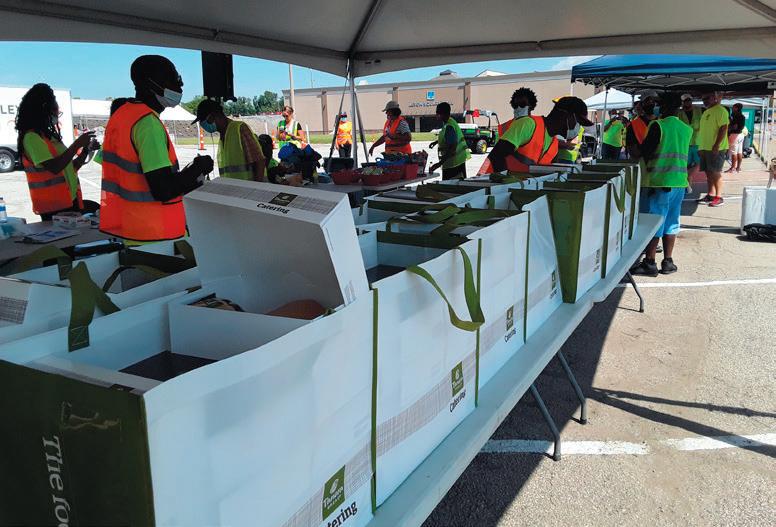

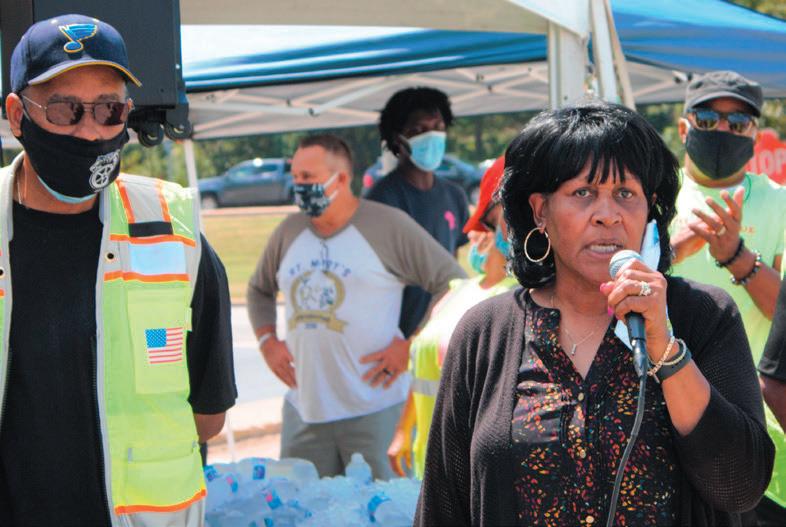

Square Mall
together to be sure we can meet the needs of people who truly need help right now.”
The Urban League of Metropolitan, Inc. has hosted 21 weekly emergency relief distributions providing more than $3.5 million in supplies to more than 55,000 families in metro St. Louis and Illinois. President McMillan said the agency will continue providing critical distributions of food, masks, gloves and other items to those in need through its network of neighborhood churches coordinated through the Urban League’s Department of Public Safety.“We are grateful for the support of more than 50 partners and the hundreds of volunteers that have supported us these past 21 weeks but we know that the need does not stop simply because we are ending our large-scale distributions,” McMillan said. “The Department of Public Safety, through our Serving Our Streets initiative, will continue home deliveries to our seniors, homebound, and others as we continue to help families navigate through this devastating pandemic.”
If you need assistance or want to learn more about our programs and services please contact us at 314-615-3600 or visit us at www.ulstl.com.

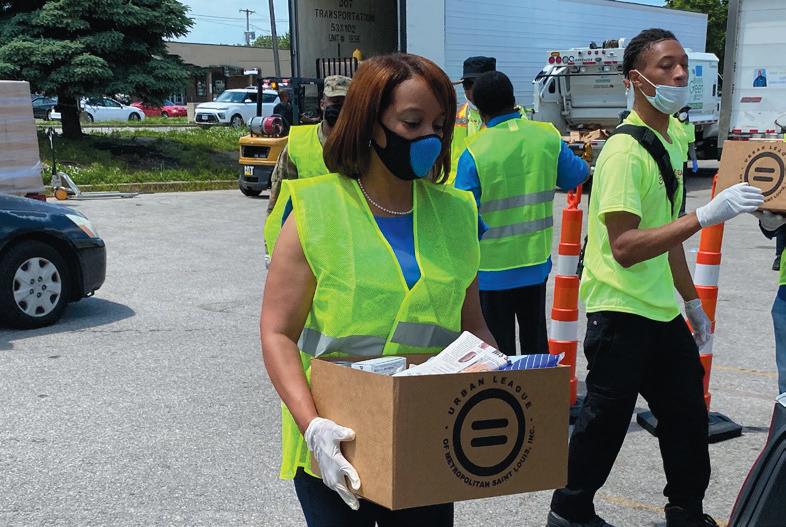
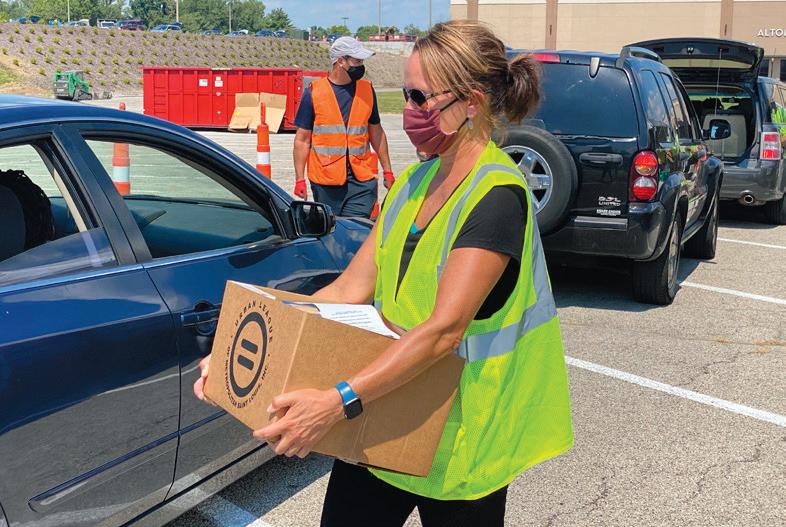
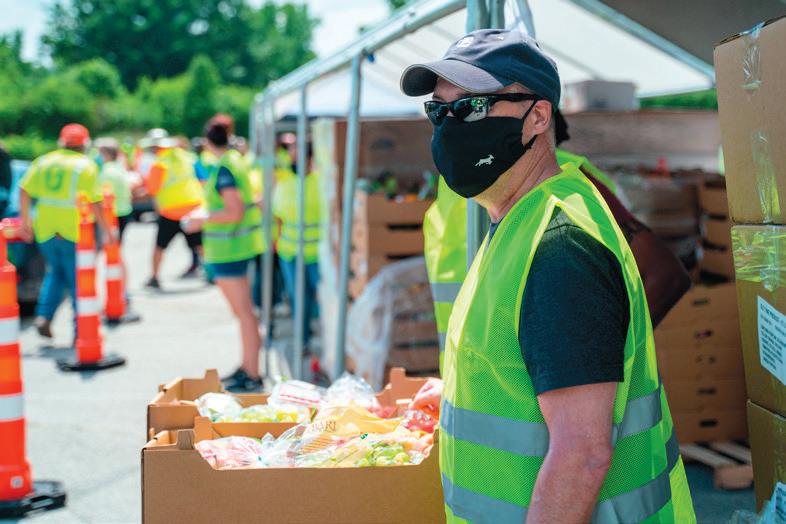

Entrepreneurs supported by credit union
STL Kappa League hosts virtual college signing day
St. Louis Kappa League, a mentoring program for males in grades 6 through 12 and sponsored by the men of Kappa Alpha Psi Fraternity, Inc., recently hosted a virtual National College Signing Day and Awards Ceremony. The event is modeled on the way professional athletes publicly declare their intentions to play for a professional team.
The affair celebrates Kappa League youth as they graduate from high school. Under ordinary circumstances, individual chapters of the fraternity host the annual occasion locally. But this year, due to the COVID-19 pandemic, the celebration was moved online. The event recognizes academic success to date and gives those graduating an opportunity to publicly declare their future educational intentions. Underclassmen are also recognized for yearly scholarly achievements.


School, will attend Harris-Stowe State University. Underclassmen recognized include Coran Moore, Academic Award; Alfred Jenkins Jr., 9th Grade Student of the Year and Academic Award; Mawdo Diallo, Academic Award; Julian Amerson, Academic Award; Ismail Botchway Jr. Kappa League Student of the Year and Academic Award; Gabriel Lee Jr., Kappa Leaguer of the Year and Academic Award; and Charlton Jones, Academic Award.
Those not pictured include Jennings Senior High School graduate West Pomerlee, who will enter the workforce and attend Ranken Technical College; Ryan Gray, 11th Grade Student of the Year and Academic Award; Koreyon Harris, Kappa Leaguer of the Year; and Kendall Ausmer and Kenton Ausmer, Guide Right Director’s Award.
The following students also received Academic Awards: Kyle Gray, Santana Barnes, Jayden Hill, JaJuan Jones, JaSean Jones and Johnathan Jones.
Celebrating the vision and legacy of Black philanthropy
Remembering the late Charmaine S. Chapman and Allison R. Brown
By the Rev. Dr. Starsky Wilson
For The St. Louis American
August is Black Philanthropy Month. The national theme this year is “Foresight 20/20.” It arrests me because of all the things I could have never foreseen on my journey that seem so well-ordered in the rearview mirror.
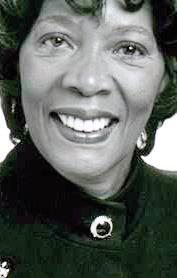

In January of 2000, I came to St. Louis for a four-day conference preparing young adults for careers in non-profit management and youth service. On the first night, I met Charmaine S. Chapman, then-president and chief executive of the United Way of Greater St. Louis Charmaine was the first woman and first African American to lead the local United Way and chaired the host committee for American Humanics (later renamed Nonprofit Leadership Alliance) national management institute. She arrived in St. Louis in 1994. By the time we met, she had grown the annual campaign, diversified the staff and board, and launched the largest United Way African-American leadership giving effort in the country. That week, though, she was focused on inspiring young people to commit their careers to service of others. So focused, in fact, that she stayed onsite at the hotel with us. In that chance first meeting, she asked me to track her down before the end of the week to talk. I did.
Kendall Grimmett, of Metro High School, declared he will attend Howard University and Christian Blue, of O’Fallon Township High
Sept. 24 deadline for NorthsideSouthside transit study
n The City of St. Louis is seeking to explore possibilities for closing the existing funding gap to construct and operate a Northside-Southside light rail expansion.
The City of St. Louis has issued a Request for Qualifications (RFQ) for an analysis that will explore alternatives for the expansion of public transit within the Northside-Southside corridor. The city and Bi-State Development worked jointly to develop the scope of the work and will jointly manage the project. Per the RFQ, the city is seeking to explore possibilities for closing the existing funding gap to construct and operate a NorthsideSouthside light rail expansion. The city also looks to explore less capital-intensive options for high-capacity transit within the Northside-Southside corridor. The city said the RFQ “shall be informed by the imperative to reduce racial and economic disparities within the City of St. Louis and wider region.” The analysis will be funded by up to $1.5 million from the Economic Development Sales Tax authorized by voters in 2017. Sixty percent of that sales tax has been reserved for future transit expan-
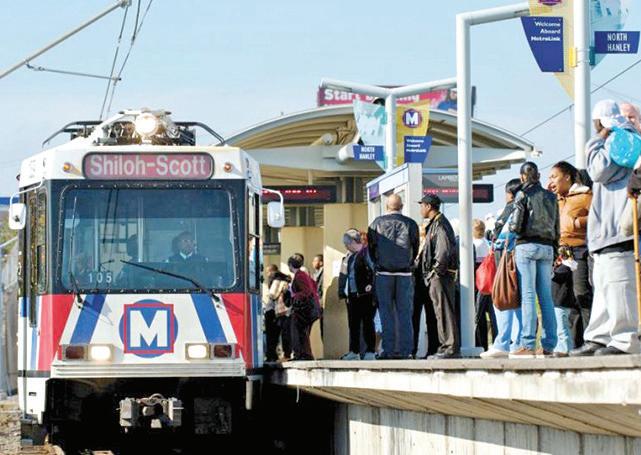
Allison R. Brown n Black philanthropy, through visionaries like Charmaine and Allison, opens doors for young leaders, helps us to imagine and makes it possible for our children to thrive on their own terms. Rest in power.
After the closing session, with a keynote delivered by a local Black businessman she recruited, she took me by the hand walked me to the back of the room and talked to me about a career in philanthropy while the hotel staff broke down the tables around us. Weeks later, I moved to St. Louis to work for United Way. One of my first assignments was with that Black giving initiative. In 2001, her body yielded to cancer. Her spirit lives through the giving effort, now named in her honor.
By May of 2015, professional transitions, bi-vocational proclivities and a community uprising had brought much change to my life. They afforded me chances to fundraise for a Black theatre, lead a small Urban League and predominantly Black church, then be called as the first Black man to helm an independent philanthropy in St. Louis. For all the pain of the uprising begun in 2014, it also initiated new relationships for me … with organizations like ABFE (the Association of Black Foundation Executives) and the Executives Alliance for Boys and Men of Color and people, like Allison R. Brown.
Allison was a mother, attorney, HBCU grad and program officer for Racial Justice at Open Society Foundations. She was a Midwesterner transplanted to the East Coast for edu-
See CHAPMAN, A10
Nadia Turner, 9, and Maya Turner, 7, were awarded $500 from Scott Credit for their non-profit business Chocolate Girls LLC, which they established in December. Their signature cookies are oatmeal, raisin and chocolate chip. Michael Turner and Shelley Williams are the proud parents of these two young ladies.
Charmaine S. Chapman
Photo courtesy of Bi-State Development
Kendall Grimmett will attend Howard University
Christian Blue will attend HarrisStowe State University
School’s back in session, SheShield has protection
By Chelsea J. For The St. Louis American
Why does it seem like all good things must come to an end? Summer has been a whirlwind and hopefully it’s been as safe and fun-filled as possible during this health crisis. COVID-19 has unfortunately taken the world by storm, forcing us all to become accustomed to this new normal—face masks to be worn almost everywhere you go, an excessive amount of disinfecting and sanitizing in order to combat any unhealthy, germ-infested organisms, and, arguably the worst part of it all, having to physically distance from the ones we love. We simply yearn for normalcy in the most humane sense.
on the horizon. However, it is still unclear how classes will resume safely and what new rules and precautions will be in place.
Whether you are a student or a teacher, being aware of your surroundings and making sure you are well equipped with some form of self-defense is crucial during these uncertain times.
n I couldn’t help but wonder, what if he had tried to harm me? I would have been completely helpless.
Self-defense mechanisms are especially essential for those who are on their way to college. Whether you’re commuting back and forth from home to campus or if you’re a resident in the dorms, www. sheshield.net has the perfect tool for you to keep handy and feel safe at all times.

use the bathroom. That’s something I usually do. Maybe she hasn’t been sleeping very well.
I always tend to sleep on my back with the covers tossed over my face. That night’s sleeping position was no different.
Before I knew it, I began to doze off again, but this time, I was awakened by pressure at the foot of my bed, as if someone had calmly sat down.
Still on my back, with the covers over my face, I thought, now annoyed, if Liz wants to talk, she should just try to wake me up, and say what’s on her mind. Why would she just sit on my bed?
Then it hit me; it’s 4 a.m. on a Sunday morning…why would she sit on my bed?
hands were buried in his lap, as if he was holding or hiding something. His long hair hung lifelessly, draped all around his head, completely obscuring his face.
That being said, we have enough to worry about when it comes to staying healthy, maintaining our sanity and keeping ourselves and those around us safe. Still, as autumn is rapidly approaching, that of course means another school year is
Those of us who have been in frightening situations can speak from experience—it’s much better to be safe than sorry. To tell you the truth, during my freshman year living on campus, I learned for myself that this is not just some cheeky cliché.
My roommate Liz and I
lived in the dorms where the bedrooms and bathrooms were conjoined. So, four people had access to one bathroom. My roommate and I lived on one side and the bathroom separated us from two girls, living on the other side in their dorm.
But here is the kicker: the campus decided that it was a good idea for the bathrooms to have locks on the inside, only. Yep. You read that correctly.
That meant, anyone could come through the bathroom and into the bedroom, from either dorm.
One early morning, before the crack of dawn, our room was pitch black, as I lay asleep in bed. I was awakened by footsteps and some fumbling around in the bathroom.
Even in my hazy, sleepy stupor, I remember thinking to myself, that’s not like Liz to wake up at this hour having to
Suddenly, wide awake, a turned over and yanked the covers from my face to see Liz—who else?!—lying in her bed, sound asleep.
My heart dropped in a millisecond as my brain began to scarily and quickly process what was happening. If Liz is there asleep, then, who is on my bed?
I shot up to see the silhouette of a man, sitting on my bed, slumped over. His
Long story short, my roommate and I, terrified, left our dorm to report the mysterious man to the front desk and public safety. Turns out, he was a friend of our suitemates’, who had partied a little too hard the night before. He was under the influence of drugs and alcohol and accidentally got in bed with me, simply not knowing where he was, thinking he had made it back to his friend’s room. I couldn’t help but wonder, what if he had tried to harm me? I would have been completely helpless. I had nothing by my bedside—no taser, no baton, not even so much as a whistle! I decided from that moment on, I would never render myself helpless in any given situation. Do yourself a favor and make a purchase from www. SheShield.net today. It could potentially make all the difference in the world when you least expect it.
Sewell elected board chair of African-American Credit Union Coalition
The African-American Credit Union Coalition (AACUC) has elected Larry D. Sewell, vice president of Corporate Partnerships and Advocacy for Together Credit Union, as chairman of the Board of Directors. Previously, Sewell served as the vice chairman for two consecutive terms. He succeeds Adrian Johnson, Senior Vice President/CFO, MECU Credit Union, Baltimore, Maryland.
Established in 1999, AACUC advocates on behalf of communities often underserved by majority financial
institutions, while promoting internship and mentorship. The organization’s mission is to promote diversity, equity, and inclusion through advocacy and professional development. Membership includes credit union professionals, volunteers, credit unions, leagues, regulators, vendors and trade associations working in the credit union industry.
Sewell was first appointed to AACUC’s Board of Directors in 2016 and then elected for a three-year term in 2017. After, in 2018, Sewell became vice chairman, serving two
consecutive terms. During his tenure, he helped carry out the vision of the coalition by serving as the
• chairperson of the Advocacy Committee, which advocates at the local, state and federal levels by raising awareness of issues that affect Credit Unions, and engaging with appropriate boards, trade associations, commis-

sions, and targeted legislative and regulatory organizations to affect change;
• co-chair of the Membership Committee, which recruits and maintains dedicated individuals to carry out the mission of the AACUC;
• member of the Mentoring Committee, which enhances efforts within the movement to provide mentoring services to credit unions worldwide; and

Chapman
Continued from A9
cation at Howard University and Harvard Law School who graduated from high school the same year I did. We came to be connected because of her deep interest in the Ferguson Uprising and commitment to move philanthropic support into the first sustained mass mobilization of the Movement for Black Lives we are still experiencing.
At a convening for W.K. Kellogg Foundation’s multiyear racial justice effort, tagged America Healing, we had our longest conversation about Black freedom dreams. Looking out onto the hills of Asheville, North Carolina, we talked about how much folks like Patrisse Cullors and Tef
Transit
Continued from A9 sion since it was approved. The Economic Development
• member of the Nominating Committee, which nominates candidates to serve on the Board.
Sewell joined Together Credit Union, formerly Anheuser-Busch Employees’ Credit Union, in 1995 as the vice president of Training and Development, where he led the credit union’s strategic initiatives for more than 20 years, before stepping into his new role as the Vice President of Corporate Partnerships & Advocacy. As a financial services industry expert and thought leader, he volunteers in the community and mentors new Credit Union employees
Poe inspired us. We wrestled with the constraints and privileges of institutional philanthropy. We committed to stay connected and find ways to support one another.
Later that year, she became executive director of the Communities for Just Schools Fund and kept dreaming of freedom. There, she supported and challenged school districts and community organizers to imagine schools without police and the marks of prisons, where our children could breathe, learn and grow. I was glad to have two opportunities to sit with her team and learn about their work.
This Saturday, August 15, my friend and co-conspirator, joined my boss Charmaine in the community of the Ancestors (accompanied by cancer as well). This summer, Deaconess partners, American
Sales Tax Board approved the funding to be included in the city’s FY21 budget that was also authorized by the Board of Estimate and Apportionment and the Board of Aldermen.

through the OWLs (Older Wiser Leaders) Employee Resource Group, and serves on the Credit Union’s Diversity and Inclusion Council. Sewell also gives back to his community as the Chair of the Planning Commission for the City of O’Fallon, Illinois, a position he has held since 2009. Sewell is a retired commissioned officer for the U.S. Air Force, and holds a Bachelor of Science in Business from Samford University, Birmingham, Alabama, a Master’s Degree in Business from the University of Arkansas at Fayetteville, and a Master’s Degree in Information Resources Management from Webster University.
Friends Service Committee and Metropolitan Congregations United who never met Allison, began to push her dream for St. Louis’ kids.
Black philanthropy, through visionaries like Charmaine and Allison, opens doors for young leaders, helps us to imagine and makes it possible for our children to thrive on their own terms. Rest in power, Charmaine and Allison. We will lift your names high. Rev. Dr. Starsky D. Wilson is president and CEO of Deaconess Foundation and board chair for the National Committee for Responsive Philanthropy. Follow him at @revdrstarsky and @deaconessfound. To celebrate Black Philanthropy Month search #BPM2020 or visit http:// www.blackphilanthropymonth. com/get-involved.
A previous study concluded that capital costs would likely range between $942 to $947 million to construct the light rail line with an additional $24 million required for annual operations and maintenance. It also concluded that the current revenue stream from the 2017 Economic Development Sales Tax, combined with the maximum 50% federal cost share for capital costs, would be inadequate to build, operate, and maintain a new light rail line. It was also previously found that the project as currently conceived might fall below the eligibility threshold for federal funding based on scoring criteria the Federal Transportation Administration applies to every project. Without a federal funding contribution, a light-rail expansion would not be financially feasible, the city said. Missouri state government provides some of the lowest levels of funding to local transit agencies of any state in the nation. The deadline to submit is September 24. The RFQ can be found at https://tinyurl.com/ STL-RFQ.
Larry D. Sewell
Gov. Parson working to undo St. Louis’ criminal justice reforms
St. Louis’ criminal justice reforms are under direct attack from Missouri Gov. Mike Parson, with the help of some powerful local, state and federal accomplices.
In the past two years, St. Louis has succeeded in accomplishing some hard-fought reforms. In 2018, state legislators came together to raise the age where a child is automatically certified in court as an adult to 18 by January 2021. Through St. Louis Circuit Attorney Kimberly Gardner’s diversion programs and advocacy organizations’ bail-relief initiatives, the jail population has declined so much that St. Louis city aldermen recently voted to close the Medium Security Institution (known as the Workhouse) by the end of the year. This spring, the city started implementing the violenceinterruption program Cure Violence and has been working to gain the community’s trust even through the pandemic.
law), and increasing the penalties for endangering a child and selling weapons to children under 18. (Somehow a child is defined as under 18 for part of his plan.)

In one fell swoop, Parson is working to undo it all — via special session no less. And he has help from St. Louis Mayor Lyda Krewson, U.S. Attorney Jeff Jensen and Missouri Attorney General Eric Schmitt
On July 27, Parson convened a special session to push through the six-part Senate Bill 1, which included lowering the age to 12 where children can be convicted as adults and sent to adult prison for unlawful use of a weapon and armed criminal action. The bill undermined “the spirit of the landmark bipartisan Raise the Age reform,” which is set to be fully implemented in just three short months, wrote Rev. Dr. Starsky D. Wilson, president and CEO of Deaconess Foundation, and Kristian Blackmon, a local organizer with the D.C.-based Campaign for Youth Justice, in an August 12 column for The American.
“There is widespread consensus that the adult system is more harmful for children and unequipped to meet their needs,” Wilson and Blackmon wrote. “The juvenile system is better designed to provide children, even those with serious offenses, with education, therapy and intensive restorative programming that is mostly absent from the adult system.” Parson had to make this move look less horrific by bundling it with other things, including a pretrial witness protection fund that Democrats argue has no funding, allowing certain witness statements to be admissible under law (which already exists through case
And finally, Parson wants to eliminate the residency requirement for the St. Louis Metropolitan Police Department and allow an officer to live within an hour from the city. Parson’s proposal also prohibits requiring any public safety employee for the City of St. Louis to be a city resident. But it’s not all on Parson. Krewson, Public Safety Director Jimmie Edwards and Police Chief John Hayden have done anything and everything to throw out the residency requirement, even bypass city voters (it’s on the November 3 ballot) and go along with sending 12-yearolds to adult prison.
The bill was set to sail through the Missouri Senate and the House, but then Parson got greedy. On August 10, Parson announced he was expanding his special session on violent crime to include a new provision “to assist with the growing backlog of murder cases in St. Louis.”
He proposed giving Schmitt concurrent jurisdiction in the City of St. Louis – but nowhere else in the state – to “take on some of the murder cases that have not yet been prosecuted.” Not only did it draw the ire from Gardner’s supporters, but it was met with vehement opposition from the Missouri Association of Prosecuting Attorneys.
“Any attempt to vest the attorney general with jurisdiction to prosecute homicides without the request of the elected prosecuting attorney fundamentally changes our system of local, independent prosecution that has served the citizens of Missouri well since 1875,” the association’s statement read.
Even Republican House leaders balked.
“Given the fact the governor expanded the call as one of our committees was considering the bill he originally proposed, we think it’s important to take a step back and give additional thought and attention to each part of the plan,” a joint statement from Republican House leadership said.
SB1 piece by piece
Now Senate Bill 1 is dead — but the fight is far from over.
The House has broken up SB1 into pieces. Starting on August 17, House committees started passing individual bills relating to Parson’s plan. They


passed House Bill 12, which raises the age to charge a child as an adult to 16 instead of 14 (which is where it had landed in Senate Bill 1 after starting at 12). They also passed House Bill 46 for the residency requirement of police and public safety employees, even though one Democratic committee member from Kirkwood — state Rep. Deb Lavender — argued that there were good reasons why the residency requirement was originally put in place.
“There have been times that people were concerned that whites living outside of Black neighborhoods would be an armed force overseeing residents of the city,” Lavender said.
What didn’t pass through committee was Parson’s push for concurrent jurisdiction for Schmitt. That was not for lack of trying from state Rep. Nick Schroer (R-O’Fallon), who also sponsored HB12. In addition, Schroer tried to pass a bill to establish procedures for recalling the St. Louis’ circuit attorney (but no other prosecutor in the state).
Not one of these white male Republicans — Parson, Schmitt or Schroer — live in the City of St. Louis or can vote for the city’s prosecutor.
“What’s funny is, you have a governor who is trying to attack Kim, who has just won her second election overwhelmingly,” said state Rep. Rasheen Aldridge (D-St. Louis). “But he hasn’t even been elected into office. He was appointed into his position — as well as Eric Schmitt. And they are trying to attack someone who was elected twice, showing that she has the trust of the people.”
The effort to undermine Gardner died in the House. “It could come up in the Senate,” Aldridge said, “but I don’t see it happening.”
Two years ago, the Raise the Age legislation went through

the proper process, Aldridge said, with lively debates and Missouri residents traveling two hours to testify. Parson’s move to undo that through a special session undermines both the voters and the legislators who researched and worked hard together to get it done.
“He isn’t even trying to see if that legislation has been effective because it hasn’t had an opportunity to go fully into effect,” Aldridge said. “It’s frustrating and it’s disheartening that politics are trumping good, smart legislation that could actually help our state. But you have an appointed governor that only wants to play games and try to get re-elected and thinks being tougher on crime is going to fix things. And it’s not.”
That, too, died in the House.
Cure Violence in peril
Gardner won the August 4
primary with more than 60% of the vote. The day after her re-election, Parson announced that the City of St. Louis is getting an infusion of federal law enforcement — 50 federal investigators from the Department of Homeland Security and $1 million from the Bureau of Justice — to “help combat violent crime,” as well as two special United States attorneys from the Missouri Attorney General’s Office to support violent crime prosecution. Krewson, Edwards and Hayden were present to support the announcement, but Gardner was not. For many advocates, this showed that any promises these leaders have made to address the root causes of crime are empty ones.
“City leaders have just given us an example of their lack of commitment to Cure Violence’s public health approach to violence,” wrote leaders of
Eric Schmitt, then state treasurer, and Gov. Mike Parson spoke together at a press event in October 2018 before Parson appointed Schmitt attorney general. Neither man was elected to his current position, yet they are teaming up to undermine the authority of St. Louis Circuit Attorney Kimberly Gardner, who was just reelected with 60% of the vote.
the Coalition Against Police Crimes and Repression (CAPCR) in an August 11 column.
“We do not need more law enforcers rounding people up, jailing them, and throwing away the key. We advocate a re-envisioning of public safety that does not rely on arrest, prosecution and incarceration. We actively support a grassroots strategy that takes into account the wishes and desires of the local residents and empowers them to effectively address crime and violence.” And the more people arrested, the more jail space will be needed — effectively undoing the closure of the Workhouse. CAPCR stated, “It is extremely disheartening to see city officials once again advocating this misguided, discredited vision.”
ADVANCE YOUR CAREER

Photo from Gov. Parson’s Twitter

“TakingCareofYou”

Saliva test allows three U. of I campuses to open in-person
Speed, lower costs ‘allow large scale surveillance testing’
By Sandra Jordan
Of The St. Louis American
A COVID-19 saliva test developed by the University of Illinois Urbana-Champaign may be the type of rapid testing needed for mass testing, rapid results and rapid contract tracing to get ahead of the spread of the coronavirus in the state and perhaps throughout the nation. The test is being used at the U. of I. lab under the U.S. Food and Drug Administration’s Emergency Use Authorization.
“Illinois’ saliva test is less expensive, faster
and requires significantly less raw materials than traditional testing. Even among the very few saliva tests available globally, it’s one of the least expensive and potentially one of the potentially most effective now on the market,” Illinois Governor J.B. Pritzker said.
“If ongoing research continues to yield positive results, this has potentially game-changing implications for our statewide testing complex, as well as for testing on a national level. Particularly for our high-risk communities and settings, this
type of scalable product would allow us to mass deploy testing and better track and contain the spread of COVID-19.”
Pritzker and university leaders made the announcement about the SHIELD saliva test at the governor’s press briefing on August 19.
“The pioneering saliva-based testing developed by our leading researchers in Urbana produces rapid results at costs that allow large scale surveillance testing,” President of the University of Illinois System
See SALIVA, A13
Why won’t people follow public health guidance on COVID-19?
By Rance Thomas For The St. Louis American
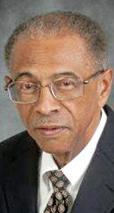
n Some have stated that their freedom or constitutional rights are being taken away. They do not realize that many of our rights have already been taken away for the common good.
Since we are facing a rise in the COVID19 virus in the St. Louis and Metro East areas, we need to follow health experts’ recommendations. These include wearing face masks, maintaining social distance (remaining 6 feet apart), and washing our hands frequently. However, some individuals are still not following these guidelines. This is even true when they are required to wear masks in order to enter certain stores, such as Schnucks and Walmart. Some wear the masks until they get inside the stores, then they lower them from over their nose and sometimes over both their nose and mouth. Further, some ignore the social distance guidelines as well. It is very difficult to understand why they ignore these requirements. However, I am certain that some do not realize that they are not only endangering others but themselves as well. That is, masks not only protect others, but also protect the wearers as well. As a result, it is very difficult to understand their behavior. As a sociologist, in analyzing human social behavior it is understandable that some are rebellious and feel that they cannot be told what to do. Others tend to mistakenly believe that they are immune from the virus. Others do not take the virus seriously. Some have stated that their freedom or constitutional rights are being taken away. They do not realize that many of our rights have already been taken away for the common good. For example, we cannot drive when we have consumed a certain amount of alcohol, and we are also required by law to wear seat belts. There are many more rights that have been taken away for the public good, including not smoking or carry weapons into certain buildings. Further, we cannot falsely yell “fire” in a theater, and we must have a driver’s license to legally
Masks required in all K-12 schools in county
County businesses now ‘must’ deny entry to those without masks
By Sandra Jordan Of The St. Louis American
St. Louis County has amended its face covering order to require masks to be worn in public or private educational institutions in grades Kindergarten through 12th grade and strengthened language for wearing face masks in businesses. The changes went into effect Monday, August 24. For K-12 students, students can remove their masks during recess or in physical education class, as long as students are at least 6 feet apart; when participating in band, choir, or music class, as long as students are at least 6 feet apart; while consuming food or drink, as long as students are at least 6 feet apart; and
n The order specifically states that businesses “must” deny entry to customers who refuse to wear a face covering.
while participating in a school sponsored sport, in accordance to the Department of Public Health’s Youth Sport Guidelines (which have not changed). The order lowers the age that children must wear masks in public accommoda-
See MASKS, A13

“We really need universal mask wearing; it’s the most important thing that we can do, moving forward,” said St. Louis County Executive Dr. Sam Page.
The testing protocol developed by the University of Illinois at Urbana-Champaign directly detects the coronavirus that causes COVID-19 in saliva samples.
Photo by Bill Greenblatt/UPI
Rance Thomas
Photo by Fred Zwicky / University of Illinois

“TakingCareofYou”
Metro East counties get more COVID-19 restrictions
Pritzker: ‘A scalpel-like approach to providing mitigations within regions’
By Sandra Jordan Of The St.
American
Louis
In Metro East and southern Illinois counties, additional restrictions went into effect on August 18 due to rising COVID-19 cases. The mitigations were out in place by the governor’s Executive Order in collaboration with the Illinois Department of Public Health to combat a COVID-19 resurgence and to prevent uncontrollable spread.
Numbers of positive coronavirus cases are equaling or surpassing an 8% threshold in Region 4 in Illinois, which includes Bond, Clinton, Madison, Monroe, Randolph, St. Clair and Washington counties.
Illinois Gov. J.B. Pritzker told reporters at his August 19
‘This
briefing that after the state opened up more, the number of coronavirus cases sprang up in some areas, and now they are trying “a more scalpel-like approach to make sure they are providing mitigations within regions.”
“We were very specific about Region 4, where there are specific kinds of problems,” Pritzker said. “They are across the river from St. Louis – everybody that lives on our side of the border and on that side of the border, they go across the bridge a lot, and we had to work in coordination with St. Louis to make sure what we were doing was effective.”
The changes affect bars, restaurants, meetings, social events and other gatherings. That means an 11 p.m. clos-
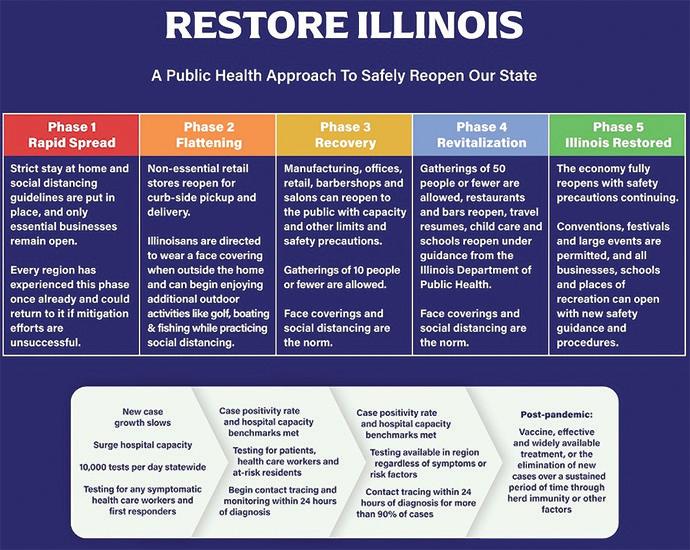
ing
removed, and ordering, seating and congregating at bars are not allowed. Customers waiting to be seated must wait off the premises and cannot congregate in groups larger than their dining party. There is no standing, congregating or dancing on those premises.
Additionally, each party must have a reservation, even if it is made on-site, so that the restaurant or bar has contact information to reach every party for potential contact tracing.
Region 4 mitigation for meetings, social events, and group gatherings includes gaming, casinos and all workplaces. Meetings and social events are limited to the less of 25 people or 25% of overall room capacity.
Attendance lists must be kept for contact tracing and party buses are not permitted. Gaming venues and casinos are limited to 25% capacity and they must close and stop operating gaming terminals at 11 p.m.
For the workplace, businesses and establishments must institute remote work for high risk individuals and shall evaluate whether additional workers can work from home. The executive order encourages remote work for as many as possible. This new order supplements the Community Revitalization Order, which remains in effect, including requirements for social distancing and wearing face coverings.
settlement will save countless lives’
MO Corrections agrees to give Hepatitis-C treatment to prisoners after class-action suit
By Sandra Jordan Of The St. Louis American
A settlement in a federal class action lawsuit announced by The American Civil Liberties Union of Missouri on Friday, August 21 ensures that people who are incarcerated in Missouri prisons will receive Hepatitis-C treatment and education. The MacArthur Justice Center, Wilkinson Walsh LLP and ACLU of Missouri reached the agreement with the Missouri Department of Corrections (MDOC) and Corizon Health, its medical provider. Hepatitis C is a liver infection caused by the hepatitis C virus (HCV) that is spread through contact with blood from an infected person. HCV can lead to life-threatening conditions, including cirrhosis and liver cancer, which are said to be widespread in Missouri prisons. Although the exact number of incarcerated people with HCV is unknown because of a lack of routine testing, it is estimated that 10 to 15% of those under the supervision, care, and
Saliva
Continued from A12
Timothy L. Killeen said. “That combination is key to curbing the virus, allowing isolation
Masks
Continued from A12
tions, from ages 9 and older down to ages 5 and older, reflecting the new requirement in schools. In St. Louis County,
COVID
custody of MDOC and Corizon are infected with HCV. In the last decade, a new class of drugs known as direct-acting antiviral (DAA) medications was approved to treat HCV. However, these drugs are expensive and were routinely denied to incarcerated people in Missouri, leading to lifelong injuries and deaths.
“This settlement will save countless lives,” said Amy Breihan, co-director of the MacArthur Justice Center’s Missouri office. “It means Missouri will go from treating less than 1% of its infected prison population, to eventually treating every incarcerated person with chronic Hepatitis C. The impact on the health of our incarcerated clients and the public overall will be immense.”
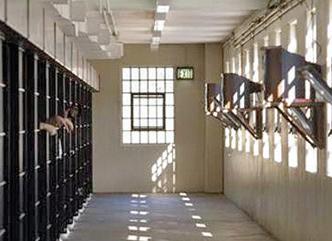
“This settlement is a step toward correcting the state’s failure to provide necessary medical care to persons in the state’s care and will help protect the public from the spread of this terrible illness by curing individuals before they return to the community,” said Tony Rothert, legal director of the ACLU of Missouri.
the MacArthur Justice Center in December of 2016. In July 2017, the case was certified as a class action consisting of thousands of incarcerated Missourians. In August 2019, the court held a four-day hearing on a motion for preliminary injunction.
The settlement agreement stipulates that over the next eight years, MDOC and Corizon will spend approximately $50 million to treat incarcerated people in Missouri with chronic HCV, beginning with the sickest individuals; MDOC and Corizon will monitor individuals at high risk for serious health conditions as a result of current or past HCV infection; MDOC and Corizon will provide educational materials regarding the risks of HCV, the benefits of testing, and their policies relating to treatment; Corizon medical staff will receive HCV-related training; and MDOC and Corizon will provide quarterly reports to plaintiffs’ counsel regarding the progress of treatment.
early enough to limit the spread of the infection, and it also identifies and isolates people with asymptomatic cases who would otherwise spread the virus unknowingly.”
Killeen said the work of its researchers has also been
if a 5-year-old is attending kindergarten, the child must wear a face covering. The amended mask order affects businesses as well. The order specifically states that businesses “must” deny entry to customers who refuse to wear a face covering. The
behind epidemiological modeling the governor used to enact lifesaving stay-at-home orders. He said the saliva test is the cornerstone of what they call the “Shield” program that is allowing us to open its three universities for in-person
order modifies the language from “authorizing” to “must deny” entry, and it empowers the businesses to enforce the requirement.
When talking about flattening the curb of new coronavirus cases with reporters earlier this week, County Executive Dr.
“Missouri prison officials and their chosen provider have known there is a safe cure for thousands of individuals in their custody with Hepatitis C and could have prevented unnecessary pain and death by allowing treatment,” said Tony Rothert, legal director of the ACLU of Missouri.
instruction.
Three universities, UrbanaChampaign, Chicago and Springfield, comprise the U. of I. System. With the new saliva test, the system expects to be able to test up to 20,000 people per day with the fall semester
Sam Page said, “We really need universal mask wearing; it’s the most important thing that we can do, moving forward.”
The St. Louis County Department of Public Health has received many complaints that some businesses are
“This settlement is a step toward correcting the state’s failure to provide necessary medical care to persons in the state’s care and will help protect the public from the spread of this terrible illness by curing individuals before they return to the community.”
The federal class-action lawsuit was originally filed by the ACLU of Missouri and
beginning on August 24.
“We’re already working to deploy this to more public universities across the state over the next weeks and months and exploring rolling this out to do testing potentially for k-12 schools and even more testing
not requiring face coverings.
The county’s Face Covering Guidelines provide alternatives to businesses who provide goods or services to those unable to wear face coverings due to a medical condition or those who refuse to wear a face covering for other reasons. A
“We got to this point by demonstrating in the courtroom that the science defendants relied on to justify their lack of treatment was indefensible,” said Betsy Henthorne, of Wilkinson Walsh. “From the week-long hearing on our motion for a preliminary injunction, through our depositions of senior MDOC and Corizon officials, we established a factual record of indifference that was as heartbreaking as it was compelling. We are grateful that those whose lives and health had been disregarded by MDOC and Corizon will get the treatment they deserve.”
The proposed class action settlement must be approved by the federal District Court following a fairness hearing, which the parties anticipate will be held sometime this fall.
at our long-term care facilities as well,” Pritzker said. In addition to public and private institutions across the state, Killeen said they are also working on marketing the saliva-based rapid testing technology nationwide.
business can provide curbside/ delivery to the customer and a business may allow entry if the person is willing to wear a face shield instead of a face covering. The amended order is posted online at stlcorona.com.
This is especially true in America, because we feel we have more freedom than individuals in many other countries. Further, many of
Continued from A12 drive a vehicle. With respect to gathering in large crowds, despite public health warnings, this can be explained by human beings being social and needing contact with others. Those who socialize in large groups in opposition to public health recommendations or mandates find it very difficult to remain isolated for long periods of time. They tend to feel a strong desire to associate with others. We see some examples of this in bars, night clubs, parks, and beaches.
these other countries demand stricter obedience than we do, and individuals tend to obey authorities. Although, we are the third-largest country in the world, we have by far the largest number of COVID-19 cases and the largest number of deaths from this virus. In spite of the loneliness and isolation, we need a national policy demanding that individuals obey these
public health guidelines for the common good. These policies must not only be mandated, but they need to be enforced as well. If we do not do this, we will have a very difficult time gaining and maintaining control of this virus.
Dr. Anthony Fauci, director of the National Institute Allergy and Infectious Diseases, and Dr. Robert Redfield, director of the
Centers for Disease Control and Prevention, said the situation will only get worse if we do not demand stricter adherence to these guidelines. They tell us the virus infection rate will climb significantly during the fall and winter months when individuals will be forced to stay indoors due to the weather. The transmission of the virus is much easier indoors, where we breathe the same air.
Let us all think about the common good and the safety of ourselves and others.
Rance Thomas was a faculty member in Sociology/ Criminal Justice and served as lead faculty/coordinator of Sociology at Lewis and Clark Community College for 30 years. He became the first person in the college’s history to be granted the Professor Emeritus Award when he retired in 2002.
How defending the rights of racists protected the freedom of all
By Congresswoman Eleanor Holmes Norton For The ACLU
billy clubs and arrests met their match as public opinion grew to favor the civil rights activists, who used the First Amendment.

As a young lawyer at the American Civil Liberties Union, I had the opportunity to show the impartiality of the First Amendment by representing plaintiffs whose outspoken views on racism made them my polar opposites.
In Carroll v. Town of Princess Anne, I was defending the First Amendment as much as the individual parties I represented. In our country, where the right to speak means the most to people like me, an African-American woman, who are not automatically part of the larger majority, the First Amendment serves an outsized purpose. Before I joined the ACLU, I was a citizen who made full use of my free speech rights. It did not take much for a girl growing up in the nation’s segregated capital to become an activist. That activism, which sent me to Mississippi with the Student Nonviolent Coordinating Committee (SNCC) in 1963, was made possible by the First Amendment. Growing up in the District of Columbia was ample preparation for the Civil Rights Movement, not only because of racial segregation in the nation’s capital, but also considering that D.C. was directly controlled by the federal government until the 1973 Home Rule Act and had no mayor or city council, and no Member of Congress. Deprived of the basics of democracy, compelled to abide by racial segregation, and denied representation in Congress, my hometown prepared me to look to the First Amendment for change. Police were more used to unruly crowds than demonstrators conducting sit-ins or peacefully picketing and occupying white-only spaces. Although nonviolent, many of our actions were illegal. Yet police had no training for handling such tactics. Eventually, though,
In turn, Congress passed the Civil Rights Act of 1964, which barred discrimination in public and private accommodations; it also provided a remedy for discrimination in employment and mandated an agency to enforce the new rights, the Equal Employment Opportunity Commission. (Perhaps needless to say, I could not have imagined that I would one day be appointed by President Carter to head the EEOC.)
The revolution in basic rights that the Civil Rights Movement achieved depended on First Amendment protected speech and action by people of every race and background who pushed the amendment to its limits. We had no power except for the power guaranteed us by the right to speak and to protest.
Except for our audacity, SNCC’s insistence on directly confronting segregation was not that different from the marches and demonstrations led by Martin Luther King Jr. and the Southern Christian Leadership Conference. But as activists, we did not litigate for our rights. Our weapon was the First Amendment. We demanded our rights in the streets, at lunch counters, and at other public places in nonviolent confrontations wherever power could be challenged. Power presented itself as outright racial segregation in the South, and as unavoidable racial discrimination in the North. Our most effective ammunition were demonstrations and other forms of activism. We were beholden to the First Amendment to make our case. The fruits of the movement’s First Amendment action also led to two more landmark civil rights laws. The 1965 Voting Rights Act assured the right to vote in Southern states, where the vote had been all but denied for a century, and the 1968 Fair Housing Act barred discrimination in housing, one of the most tenacious forms of racial bias.
However, the 1960s was not only the decade of the Civil Rights Movement. These were also historic years for the Warren Court, when the court broke with prior decades and




cooperating attorney, William Zimmerman, I presented the constitutional arguments in both courts.
Our client, members of the National States’ Rights Party (NSRP), called themselves a white supremacist organization. According to the Supreme Court, the group held “an aggressively and militantly racist” rally in a small Maryland town with a crowd of 150 people, some of whom were Black. After the rally, with 60 police held close on standby, party members announced they would return for another rally the next night. Maryland county lawyers rushed to obtain a court order that barred the NSRP from holding a rally for 10 days, which was later extended to a 10-month injunction prohibiting the rally.
The NSRP surely did not envision that one of their lawyers would be a young Black woman. Still, some of them came to the 4th Circuit and approached me with praise following oral argument. Although the 4th Circuit overturned the 10-month injunction against NSRP’s rally, the court allowed the 10-day injunction to stand. We appealed to the Supreme Court.
speaking at all was unthinkable. The Supreme Court affirmed the continued importance of the First Amendment by refusing to find the case moot, although the 10-day injunction approved by the 4th Circuit had long expired. The Maryland court’s decision granting the 10-day injunction had allowed the NSRP to hold rallies so long as they no longer exercised their First Amendment rights to use racially divisive language. The court observed that the NSRP continued to hold rallies after the injunction had expired, and the injunction continued to limit the right of NSRP members to express their views. Most importantly, the issuance of an injunction without the opportunity to be heard, the court said, was unconstitutional prior restraint on speech. For such an injunction to survive “within the area of basic freedoms guaranteed by the First Amendment,” restraining orders must be short in duration, and it must be possible for those wishing to speak to challenge them. The Maryland court had therefore created a standard for those wishing to speak that was virtually impossible to be overcome.
issued some of its great civil liberties decisions. Besides the most groundbreaking, ending racial segregation in public schools (the District was among the plaintiffs), the Warren Court issued opinions ensuring equal representation
It was my good fortune to work for the national ACLU, fresh out of law school, where I helped bring a case that became one of the Warren court’s landmark civil liberties decisions. That case was Carroll v. Town of Princess Anne, a
n The National States’ Rights Party surely did not envision that one of their lawyers would be a young Black woman.
in state legislatures, expanding constitutional rights for defendants, and opening the path for legalization of abortion, among many other historic decisions.
monumental First Amendment decision that appeared in both the 4th U.S. Circuit Court of Appeals and in the U.S. Supreme Court. Along with the
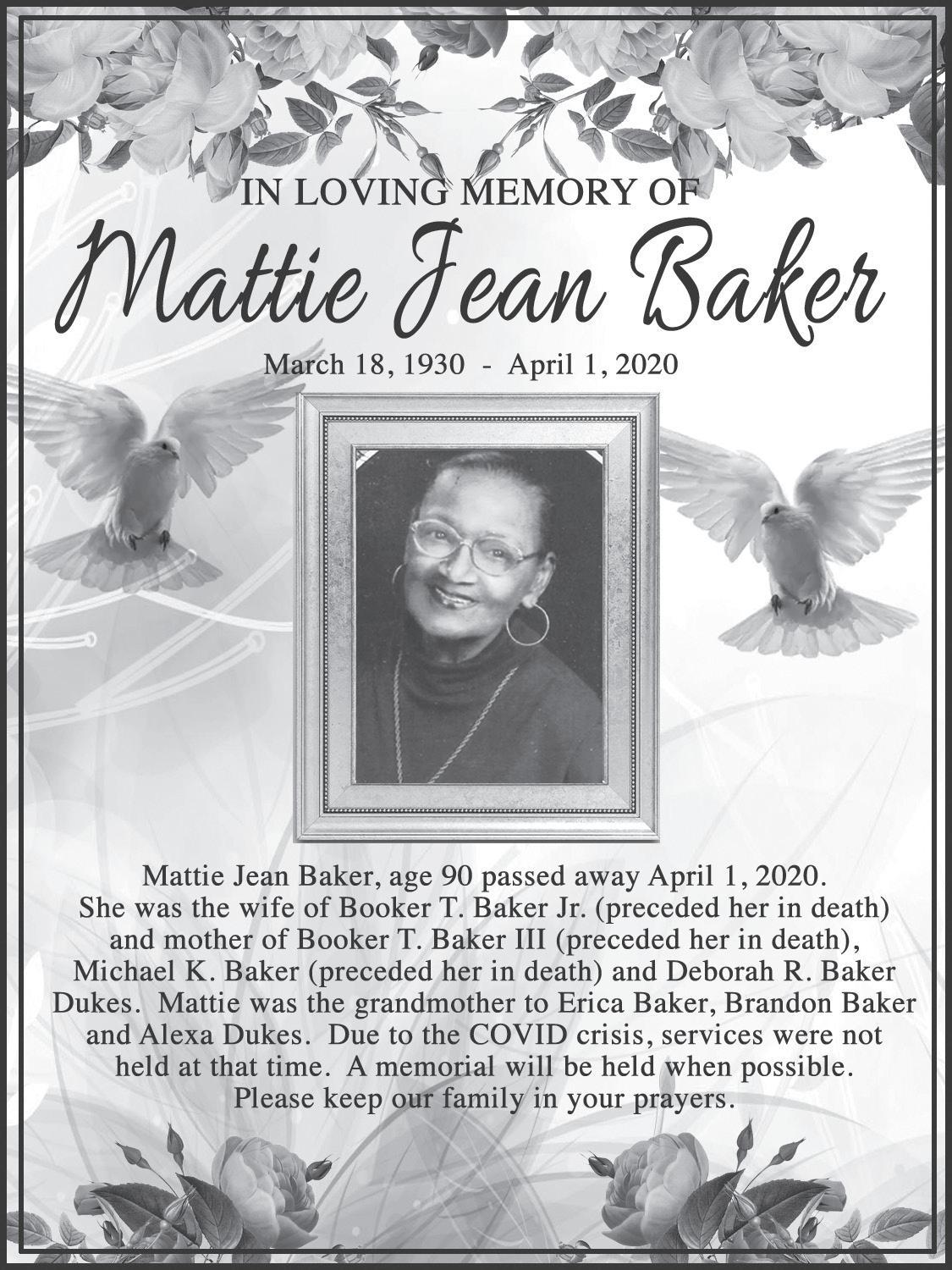
At 31, I barely met the three years of required practice for membership in the Supreme Court bar. Although I was not unpracticed in public speaking, I tried to overcome my legal inexperience with ample preparation. Yet preparation was not all I had to think about. Counsel before the Supreme Court generally were not young, female, or Black, much less with an afro (well before Black women wearing their hair natural was routine). I decided to be myself, not a female version of a Supreme Court counsel in a black suit. I wore a blue dress with a high collar but short sleeves, whose fashionably short length, just above the knees, was in keeping with the style of the day.
What confidence I summoned before the court came in no small part from my intellectual and visceral antagonism toward attempts to keep people from speaking, known in the law as prior restraint. Gains in the Civil Rights Movement would have been impossible if activists had been shut down before they could speak. Meeting resistance from those opposed to our words or protections was not unusual. But being illegally barred from
Notwithstanding the procedural flaw in issuing the injunction, the Supreme Court was clear on the principle of the Carroll case: “Prior restraint upon speech suppresses the precise freedom which the First Amendment sought to protect against abridgement.” The court did not allow the procedural issue in the case to obscure the overriding necessity to avoid “the dangers of a censorship system.”
The effects of Carroll continue to this day. In the years since, the case has deterred federal and state governments from even attempting to limit speech before it occurs. Carroll has set the bar so high that the government has never won a prior restraint case in the Supreme Court since. I can only hope that what I do in Congress will have as lasting an effect as Carroll v. Town of Princess Anne has had on the First Amendment.
Congresswoman Eleanor Holmes Norton is a civil rights and feminist leader, a former professor of law at Georgetown University, and represents the District of Columbia in the U.S. House of Representatives.

Portrait of the author as a young woman.
Black women are leading the nation through crisis
By Marc H. Morial National Urban League

The selection of U.S. Senator Kamala Harris to be the Democratic vice presidential nominee represents many “firsts”: the first Black woman, the first person of South Asian descent, and the first HBCU grad to be nominated on a major party ticket. More importantly, though, her candidacy is emblematic of this unprecedented moment of racial reckoning in America and the outsized role that Black women are playing in leading the nation through this period of crisis.
It’s no surprise that Black women have emerged among the nation’s strongest and most competent leaders. The formidable challenges that women, particularly women of color, must overcome to achieve positions of prominence are like the fire that tempers steel.
The National Urban League has had a strong relationship with Senator Harris for many years. We honored her as one of the first recipients of our Woman of Power awards in 2004, just after she was elected district attorney of San Francisco. In 2017, when she assumed office as California’s third female U.S. senator and the first of Jamaican or Indian ancestry, we honored her with
the Hiram Revels Award for Achievement, named for the first African American to serve in the U.S. Congress. While we’ve worked closely with her since her election to the Senate, her fierce advocacy for underserved communities since the onset of the pandemic has been invaluable. She, along with U.S. Sen. Cory Booker of New Jersey, was a prime sponsor of the George Floyd Justice in Policing Act in the Senate. We recently joined her and other members of Congress to announce legislation that would allow those at risk of eviction to access legal representation, and help protect their credit. As a member of the Senate Judiciary Committee, she famously held Supreme Court nominee Brett Kavanaugh and Attorney General nominee William Barr to account during their confir-
n Her groundbreaking selection to the position of vice presidential nominee has drawn comparison to the legendary Shirley Chisholm.
mation hearings. Her groundbreaking selection to the position of vice presidential nominee has drawn comparison to the legendary Shirley Chisholm, whom she often cites as a source of
inspiration. In 1968, Chisholm became the first Black woman to serve as a member of Congress and in 1972 became the first Black woman to seek the nomination of a major party for president.
When she launched her presidential campaign, Harris chose a red and yellow design for her logo that resembles Chisholm’s campaign buttons.
Chisholm faced abhorrent racial harassment on her campaign, and nearly half a century later, the racist attacks not only have not subsided – they’re amplified through social media. But it’s not just crude slurs hurled on Twitter by anonymous trolls. Within hours of the announcement that she had been selected as Joe Biden’s running mate, a major magazine amplified a racist “birther” conspiracy theory about her.
Chisholm was realistic about the obstacles her candidacy faced. “I just want to show it can be done,” she often said.
Harris was a child when Chisholm ran for president just to show it could be done, and now she stands a realistic chance of being the first woman to hold the secondhighest office in the land.
As Joe Biden said the day after announcing his choice, “This morning, all across the nation, little girls woke up, especially little Black and Brown girls, who so often feel overlooked and undervalued in their communities, but today, today just maybe, they’re seeing themselves for the first time in a new way, as the stuff of presidents and vice presidents.”
Marc H. Morial is president and CEO of the National Urban League.
May 13, 1942 – August 19, 2020
Mary Helen Johnson services are Friday
Mary Helen Johnson was born on May 13, 1942 in Clintonville, Mississippi to the late Robert Johnson, Jr. and Eugene (Robinson) Johnson. She was the fourth of the couple’s seven children. Mary attended school in St. Louis, Missouri, including St. Louis Cathedral Grade School, St. Alphonsus Rock High School and Saint Louis University.
On November 25, 1967, she married Ralph Johnson (obviously no relation), whom she met while working as a postal clerk for the United States Postal Service (USPS).
During Mary’s time with the USPS, she rose through the ranks and eventually became a supervisor in the Human Resources department before retiring in 2000.
Mary enjoyed supporting her children’s and grandchildren’s activities, watching tennis, grabbing deals at Marshalls, and Johnny Mathis concerts.
Mary lived life boldly, generously and unafraid. On August 19, 2020, she transitioned peacefully after a brief battle with kidney failure, respiratory and heart complications.
Mary is survived by her devoted husband, Ralph; two children – Reginald (Anyiesa) and Raegan; two grandchildren – Reana and Ryan; five siblings – Dorothy Jones, Barbara Ann Sinkfield, Hattie Marie Haywood (Edward), Laurencia Stikes (Charles), and Gail



Young (Larry) and a host of other relatives. She was preceded in death by her only brother, Leroy Johnson. Mary’s strength, sharp commentary and compassionate heart will truly be missed.
Visitation for Mary Helen Johnson will take place Friday, August 28 from 9 to 11 a.m. at The Ronald L. Jones Funeral Chapel – 2161 East Fair Avenue, Saint Louis, Missouri 63107. Due to COVID 19, masks are required by all in attendance. In lieu of flowers, the family is asking for donations to the National Kidney Foundation in her loving memory at www. kidney.org/donation.


Columnist Marc Morial
Mary Helen Johnson









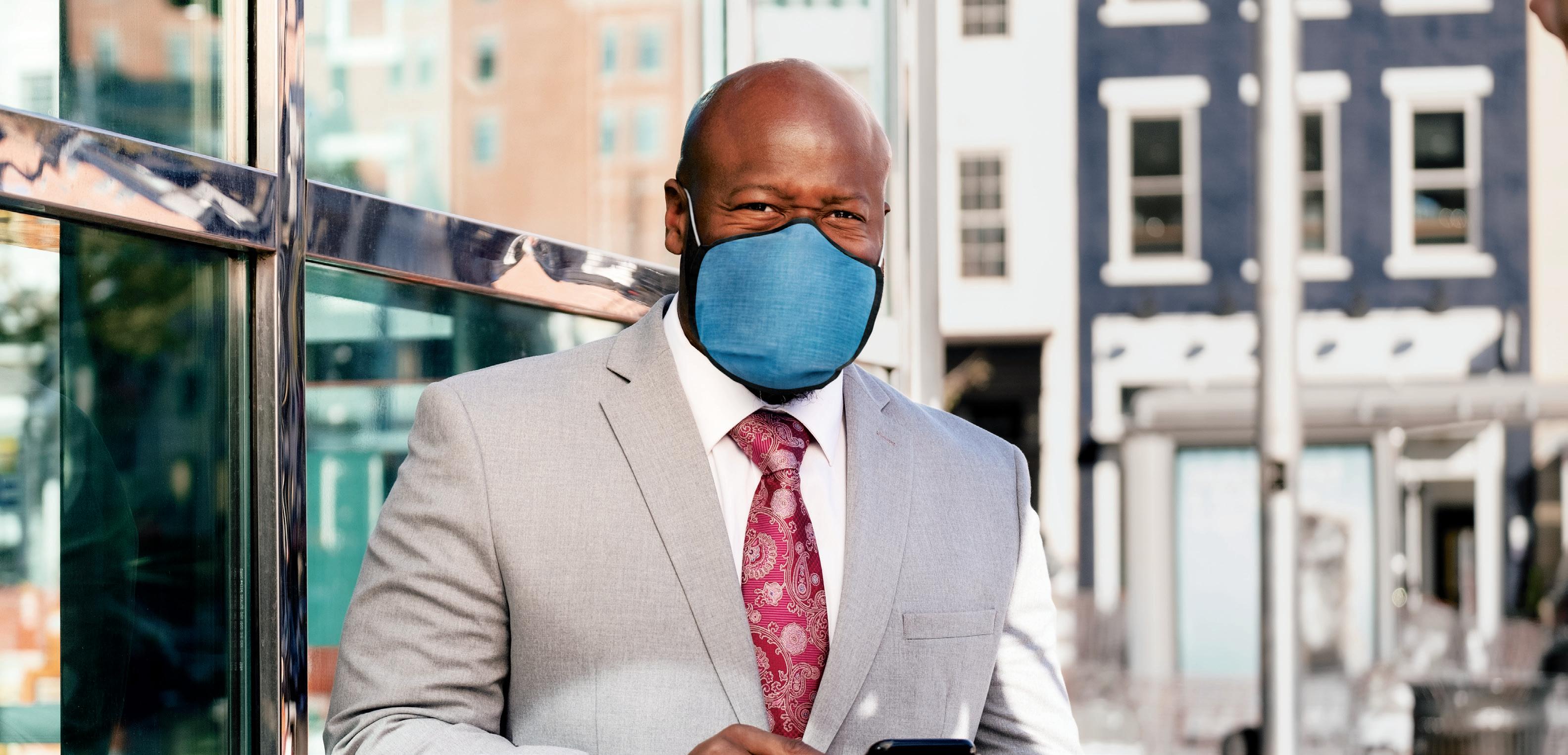



Census







Analyst, Census Taker
Student, Census Taker
Musician, Census Taker
Writer, Census Taker
Retiree, Census Taker Baker, Census Taker
Living It
‘COVID makes everybody in the arts work harder’
The Black Rep is determined to survive the pandemic
By Sylvester Brown Jr.
Of The St. Louis American
As with other businesses and organizations, COVID-19 is wreaking havoc on fine and performing arts organizations, like St. Louis’ Black Repertory Theater.
“Struggle,” for black theatre companies, is nothing new, said Ron Himes, founder and producing director of the Black Rep. For instance, among the black theatre organizations forged during the Civil Rights/Black Arts Movements of the 1960s and 1970s, he said a staggering 87% had closed their doors by the mid-’90s.
“Survival,” Himes said, is part of the history of black arts.
“It is the nature of who we are as individuals and as a field,” he said. “We will find a way. There will be a number of casualties from COVID-19, but I’m counting on us not being among that list of casualties.”
When asked if he could think of a local actor who represents the passion, resiliency, and fearlessness of the Black Arts Movement in the midst of this global pandemic, Himes responded without hesitation.
“Tyler White,” he said. “She’s 24 and has been with the Black Rep since she was eight years old. She’s grown up with us. Being an artist is at the core of her being. If I said, ‘Tyler, I want you to jump off that table and do two somersaults before you hit the floor,’ she’s going to try it.”

This summer, the young actress started her first year as director of the Black Rep’s Summer Arts Camp (SAP). White said she was overwhelmed with the responsibility of overseeing and keeping 14 kids (ages 6 to 16) safe all day, every day, for six weeks.
“I had to figure out safety procedures, making sure the kids wore their masks the entire day and having them do hand-sanitizing all day,”

Photo courtesy of the Black Rep Tyler White played the chorus dancer Bettina in “Spell #7,” a choreopoem by Ntozake Shange. In mid-March, the Black Rep canceled the remaining performances of “Spell #7” due to the pandemic.
White said. “I was having little mental breakdowns because I was responsible for all those kids. I had all that weight on my shoulders. It was a lot.”
The stress and hard work by White and other Black Rep staffers paid off. No child, teacher or parent tested positive for the virus during the
weather world

Alvin Kamau of Hazelwood gained national attention for a forecast that gives professional meteorologists a run for their
Alvin Kamau of Hazelwood gets more than 13K views for YouTube report
summer program. The real payoff, White said, was the fact that the youth had a chance to relax, release and express their natural creative desires.
“The kids have been locked up since March.

‘This is a show about gun violence’

Story Stitchers Artists Collective use podcast to find solutions
By Rebecca Rivas Of The St. Louis American
Youth voices are often left out of important conversations about public safety and the public health crisis. But the Saint Louis Story Stitchers Artists Collective — a mix of professional artists and minority youth — having been busy creating podcasts this year to encourage social change with a focus on gun violence prevention.
Since 2013, the group’s main outlet has been live performances. But in October, the collective applied for funding to create a youth-led podcast program called StitchCast Studio — not knowing that digital expression would be the collective’s only creative outlet for most of the following year.
“We didn’t know it was going to happen in COVID,” Susan Colangelo, president and executive director of the collective. “It’s been a good way for the youth to be active and safe.” Colangelo learned they received the City of St. Louis Public Safety Youth at Risk Crime Prevention grant in January, and they had just started getting the podcast studio up and running right before the pandemic hit. The podcast program really started kicking up right around the time that the protests began in May, she said. Youth artists use dialogue, original poetry, and music to highlight their personal experiences with topics including gun violence, life transitions, and mental health. Several of the youth
Learning about our culture is my passion for my future
By Precious Barry For The St. Louis American
I
and
people to
individual

ing and knowing that, during difficult times, things are going to knock you down, but you have to find the strength some way or somehow to get back up. In the future, one of my goals is getting schools deeper into African-American Studies worldwide. We know it is not easy to get these types of topics in schools, but the best we can do is boost up the percentage of what is being taught. I see myself in an HBCU one day studying African-American Studies with a doctorate and becoming a civil rights activist. I plan on this major, because it is especially important for me to become more knowledgeable. I am also working on right now getting Zoom meetings for youth and talking about what is going on in our society and what can we do to help prevent any type of violence. We are the change, we are the future, we are the empowerment the world needs.
with permission of the author’s mother.
By Kelsi Anderson
KSDK
Precious Barry

have lost family and friends to gun violence, experienced homelessness and are involved in the Black Lives Matter movement.
“We want people to feel safe coming into this neighborhood, whether they’re students or your family or your grandmother,” said one participant in the StitchCast Studio trailer.
“This is a show about gun violence, what’s happening in our inner-city streets and finding solutions to issues that are coming at our youth hard.”
The collective is looking for participants ages 16 to 24, particularly youth from St. Louis city by December 31. Youth may earn a $100 stipend for participating in four workshops in small groups, concluding
in a podcast recording about issues of concern to them. Sessions are done in Zoom. Youth alumni of the program can also then do more twoweek podcasts, earning $50 stipends for each. The collective will run four podcast workshops a month
n
through December. Aside from the city’s grant, the project also has support over three years from Spirit of St. Louis Women’s Fund.
Youth are at the center of the collective’s work and have expressed the need for mentorship and community to support them.
“Gun violence is a pressing public health crisis that consumes the attention of the engaged youth,” according to the collective’s website. “Youth have the opportunity to work through their pain and loss and be a force multiplier, impacting families, schools and neighborhoods.”
There were many issues weighing down the youth before the pandemic, and now that has been compounded, Colangelo said.
“We want their voices to be heard,” she said. “It also gives them some kind connection with other youth.”
Interested youth should go to storystitchers.org or apply at https://storystitchers.wufoo. com/forms/w1iaeygj0pdfxs6/.



weather report.
“I really don’t understand weather myself,” said his mother. “He told me, ‘Mom, record me, record me.’ I said, ‘You want me to record you? OK, let me do it.’ And he just surprised me, and I thought, ‘OK, let me put it on Facebook.’”
In the video, Alvin talks for more than two minutes and never misses a beat, giving professional meteorologists everywhere a run for their money.
Alvin’s video also was
So, it was nice to have them in a safe environment where they could express themselves and just have fun and enjoy time away from their homes,” White said. “Honestly, it was the purest feeling ever to see them come in every morning so excited and so eager to work.”
Getting through the summer program is just a sliver of the challenges performing art companies must face. According to a new study by the Brookings Institution, the new coronavirus is having a disproportionate impact on fine and performing arts organizations. The report, “Lost Art: Measuring Covid-19’s devastating impact on America’s creative economy,” estimates “losses of 2.7 million jobs and more than $150 billion in sales of goods and services for creative industries nationwide, which range from film and fashion to fine and performing arts.”
Stimulus benefits mostly bypassed struggling actors who were getting paid little to nothing while practicing their craft. Himes said that actors’ and directors’ unions are appeal-

picked up by Vitendo4Africa, a Hazelwood-based nonprofit that helps empower African immigrants. Alvin was born in the U.S. and his mother is from Kenya.
His video was seen 13,000 times and got several comments from meteorologists praising Alvin›s skills. 5 On Your Side aired his forecast on Today In St. Louis and then aired an interview with Alvin.
“Thank you @ WthrmnSlaughter and @ksdknews for giving Alvin this rare opportunity,” Vitendo4Africa said on Twitter Wednesday. “You not only lifted up his confidence and self-esteem, but you also touched the hearts
ing to Congress for more help from the next round of stimulus money. It’s only fair, Himes said, considering the impact the arts have on regional economies.
“There is a saying that every dollar generated by an arts institution is multiplied 8 or 9 times when it goes back out into all of the places that we support,” Himes said. “Art and cultural institutions have a tre-
n “There will be a number of casualties from COVID-19, but I’m counting on us not being among that list of casualties.” – Ron Himes, founder and producing director of the Black Rep
mendous impact everywhere.”
In mid-March, the Black Rep canceled the remaining performances of “Spell #7,” a choreopoem by Ntozake Shange. Plans to resume live performances in January are in question because of the
of many African immigrant in STL. You are inspiring young kids and youth to pursue their passion.”
During his interview, Alvin gave the weekend forecast, and it was spot on, Slaughter said. Alvin has his own YouTube channel now where his forecasts are being posted. Kamau said she’s incredibly proud of her son and thankful for the support he’s gotten from 5 On Your Side and other professionals in the field. Watch Alvin’s weather reports at https://tinyurl.com/ AlvinKamau. Republished with permission of St. Louis American content partner 5 On Your Side.
uncertainties of the pandemic. For an organization that raises money largely through live performances, the Black Rep, as it starts its 44th Season, is in a vulnerable position. Still, White said, arts organizations are up to the challenge.
“COVID makes everybody in the arts work harder,” she said. “It’s hard because people are retracting and not wanting to go out. So, you have to figure out ways to still keep your audiences engaged, keep them wanting more and wanting to come back when COVID is over.”
White played the chorus dancer Bettina in “Spell #7.” Small and svelte, she speaks with quiet confidence about improving her craft, being a better actress and maybe moving to Chicago or New York. She spoke most passionately though, about her desire to return to live performances after the coronavirus epidemic.
“I’m in dire need to be back on a stage again. We have virtual readings and recordings but it’s not the same,” White said. “Live theater is what I long for. The give and take between actors and audiences is awesome. I miss that.”
Sylvester Brown Jr. is The St. Louis American’s inaugural Deaconess Fellow.

Rep

Be a Tourist in Your Own Town
How to take a staycation in St. Louis

By Jennifer Poindexter
Of Explore St. Louis
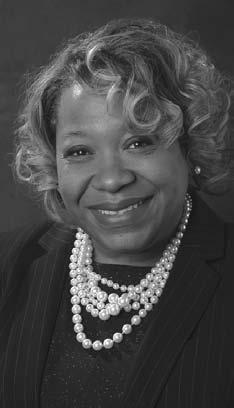
Carlene Davis, Sherrill Jackson, Toni Renee Jordan are 2020 Women of Achievement

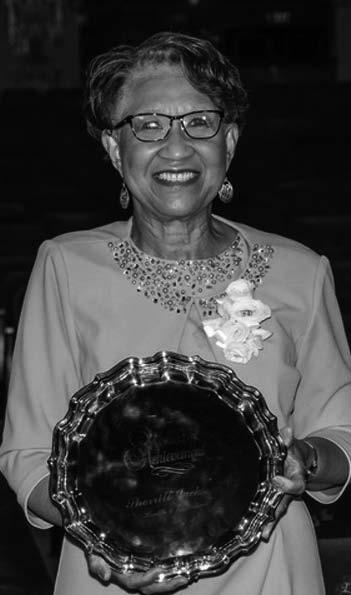

American staff
The 2020 Women of Achievement include three African-American women: Carlene Davis (Lifetime Service), Sherrill Jackson (Health & Education) and Toni Renee Jordan (Change Agent).
Katzman (Women’s Empowerment) and Joan Lipkin (Arts & Social Justice).
Many of us have had to either delay or completely forgo our summer vacations. Instead of suffering from cabin fever, as St. Louisans, we are fortunate to have many things to re-explore responsibly from our restaurants to our hotels to attractions and more. I have so many favorites in St. Louis, but here’s a sample itinerary for my perfect staycation: Of course, all good vacations … or in this case staycations … start at a great hotel. The Chase Park Plaza has just what you need! Located in the heart of the Central West End, this hotel has it all and is steps away from St. Louis’ premier attractions. Enjoy dinner at a delicious onsite restaurant. Then take a refreshing dip in the outdoor swimming pool before heading to your guest room for a restful night’s sleep. If you’re looking for luxury and relaxation, the Chase has it all.
events leading up to the passage of the 19th Amendment in 1920. Advanced reservations are required but admission is free.
The next day, enjoy the sunshine and walk over to historic Forest Park where there’s no shortage of activities fit for the entire family. Paddle boating, hiking, and more await across the Park’s 1,300 acres. Forest Park also has a variety of fivestar attractions including The Saint Louis Zoo, Saint Louis Art Museum, and the Missouri History Museum. The current exhibit at the Missouri History Museum, Beyond the Ballot: St. Louis and Suffrage, is not to be missed! Through an engaging mix of artifacts, images, media, and interactives, Beyond the Ballot features Annie Turnbo Malone and explore women’s unique roles in St. Louis history. One major element of the exhibit will trace the long history of the fight for woman’s suffrage in St. Louis and the
You won’t find a better sunset than the one on Art Hill and it is not to be missed. After the exhibit, grab a picnic to go from Steve’s Hot Dogs –named the best hot dogs in St. Louis – and check it out for yourself. Do save room for dessert though and end your day on a high with Clementine’s Naughty & Nice Creamery. There you’ll find sweet, savory, and even boozy ice cream combinations.
There’s so much to do and re-explore all across the city. What are you waiting for?
Check out Explore St. Louis’ Passport to STL Page for ideas on creating your own staycation. And when you take your staycation, please remember, keep 6 feet apart, wear masks and wash hands. Happy staycation! Jennifer Poindexter is director of Convention Services for Explore St. Louis.





The St. Louis Women of Achievement Award, which was founded in 1955, is the oldest, ongoing program in the area whose sole mission is to honor and recognize the volunteer service and volunteer leadership of women.
Carlene Davis retired in 1989 after 37 years of teaching in the St. Louis Public Schools. She then began volunteering at the Mathews-Dickey Boys Club through its after-school tutoring program. For 28 years, she has tutored at Simmons, Lexington and Cote Brilliante elementary schools and Washington Montessori School. She also has been an AARP volunteer since 1989, serving as state training coordinator, community advocate, member of the speakers’ bureau, with terms on the Leadership Council and the Executive Council.
Sherrill Jackson is a retired pediatric nurse practitioner who spent her career providing medical care to underserved children at local community health centers. A 28-year breast cancer survivor, she is co-founder and board president of The Breakfast Club, Inc. and has worked tirelessly in the fight
against breast cancer. Breakfast Club programs focus on education, awareness, resources and support concerning breast health, breast cancer prevention and screening. She also serves on numerous boards addressing breast cancer disparities.
Toni Jordan has used her own story to inspire individuals and change communities. After attending Let’s Start, a support process for formerly incarcerated women in 2006, Toni started volunteering at Queen of Peace Center (QOPC), a substance abuse treatment center for women. She went on to create and lead a QOPC Consumer Advisory Board, which lead to substantial change in the center’s programs, procedures and policies. She has been on the advisory board for State of Missouri Transformation Grant and helped create a new network of service programs in the City of St. Louis for those experiencing homelessness, trauma, mental illness and substance abuse.
The other 2020 Women of Achievement are Susan Balk (Impactful Leadership), Debbie Caplin (Pet Therapy Advocacy), Susan Gobbo (Multicultural Enrichment), Jennifer Hillman (Creative Philanthropy), Susan Hockensmith (Compassionate Welfare), Susan
Women of Achievement are selected from nominations from the St. Louis metropolitan area, including Metro East Illinois, who have demonstrated outstanding commitment to the betterment of the St. Louis region through voluntary contributions, volunteer leadership and a significant breadth of a volunteer career.
The chair of the 2020 Women of Achievement Awards Celebration is Joni Karandjeff (Class of 2008) and the vice chair is Elizabeth Mannen (Class of 2017).
The 10 honorees were originally scheduled to be recognized at the 2020 Women of Achievement Luncheon at the Ritz-Carlton on May 12, and later on September 15, but the luncheon was canceled due to the coronavirus pandemic. Now, the honorees are being recognized in an hour-long awards celebration broadcast on Nine PBS on September 14 at 7 p.m. A recording of the program will also go online on Women of Achievement’s website (woastl.org) after the broadcast.
For more information about the broadcast on Nine PBS, visit http://www.woastl.org or call 314-896-4962.

Paddle boating, hiking, and more await across Forest Park’s 1,300 acres.
Guest Columnist Jennifer Poindexter
Carlene Davis
Sherrill Jackson
Toni Renee Jordan
B4
Sports
sports eye
Jack Flaherty condemns police shooting in Wisconsin, prays for Jacob Blake
Jack Flaherty, the St. Louis Cardinals pitching ace, has caught continuous hell from many so-called members of Cardinal Nation for his unabashed support of Black Lives Matter and finding a way to end systemic racism in America.
The crazy talk includes fans saying the Cardinals are doomed to have an unsuccessful season because they dared to wear Black Lives Matter shirts on Opening Day in late July. Others are saying they hope Flaherty fails on the mound or that they refuse to watch the team – now and forever.
I can just imagine the hate that Flaherty must have to put up with on Twitter and social media.
At 9:38 a.m. Monday, Flaherty responded on Twitter to Kenosha, Wisconsin, police shooting unarmed Jacob Blake seven times – an act that was captured on video: “go ahead. try and explain how 7 rounds in his back makes sense,” he wrote.
right now.”
All St. Louis and Missouri should be so proud of this young man. It’s a pity that we know this is far from the truth. There is praise for the Portland Place McCloskeys and scorn for Flanagan. It’s ugly, but I’m not surprised.
‘We’re terrified’
After his 30-point, 10-rebound effort helped the Los Angeles Lakers easily defeat the Portland Trailblazers on Monday night to take a 3-1 lead in the best of seven NBA playoff series, LeBron James had a much more important thing to discuss with the media.
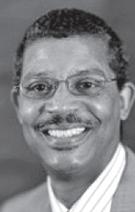
On Monday night, Flaherty took the mound against the Kansas City Royals and allowed just one hit over five inning and no runs. The Cardinals won 10-3. Following the game, while wearing a Kobe Bryant L.A. Lakers jersey, Flaherty spoke of his excellent outing and then the Blake shooting.
“I woke up and saw that this morning, and that was tough,” he said.
“That was tough to watch. And it didn’t really make sense. It still doesn’t make sense.”
Blake’s family said he is in serious condition, but is paralyzed. Flanagan said he is praying for his recovery.
“I mean, you get seven rounds fired into your back like that, [it] just doesn’t really make sense. You just kind of wonder what’s going through everybody’s head there in that kind of situation,” he said.
“It just continues. I mean, just because sports is coming back doesn’t mean these conversations stop and that there’s no call for action. It means we actually need more call for action. We need more people to continue this conversation, continue to bring light to events like this. What would have happened if somebody hadn’t filmed it? Just thoughts and prayers with him and his family
“I know people get tired of hearing me say it, but we are scared as Black people in America. Black men, black women, black kids, we are terrified,” James said in response to Kenosha, Wisconsin police shooting unarmed Jacob Blake in the back seven times.
“If you’re sitting here and telling me that there was no way to subdue that gentleman or detain him before the firing of guns, then you’re sitting here and lying to not only me, but you’re lying to every African American, every Black person in the community,” James said.
“Because we see it over and over and over.”
Kenosha is less than 40 miles south of Milwaukee, and Bucks star George Hill said the latest shooting by police of an unarmed Black man makes the bubble in Orlando and playoff games meaningless.
“We shouldn’t have even came to this damn place, to be honest. I think coming just here [to finish the season in Orlando] took all the focal points off what the issues are. But we’re here, so it is what it is,” Hill said.
“We can’t do anything from right here, but I think definitely, when it’s all settled, some things have to be done.”
It’s not just Black athletes who immediately spoke out after the Blake shooting. Aaron Rodgers, Green Bay Packers quarterback, said in a video the latest incident “hits home.”
“There’s a systemic (racism) problem.”
Utah Jazz star Donovan Mitchell, who scored 51 points in a playoff win over Denver last weekend, shared his fury

on Twitter by writing, “F THE GAMES AN PLAYOFFS. THIS IS SICK AND IS A REAL PROBLEM. WE DEMAND JUSTICE...THIS IS WHY WE DON’T FEEL SAFE.!!!!”
Tyrann Mathieu, safety for the Super Bowl champion Kansas City Chiefs, wrote on Twitter, “Damn they shot that man 7 times.... why can’t 3 officers subdue one male? I truly need answers y’all comment on everything else......”
Democratic presidential candidate Joe Biden released a statement on Monday saying, ““This morning, the nation wakes up yet again with grief and outrage that yet another Black American is a victim of excessive force,” he said. “Those shots pierce the soul of our nation.”
Blame the Big Ten Black man
Big Ten Commissioner Kevin Warren has at least 14 bosses. He reports to the various presidents and chancellors of the 14 Big Ten universities, and it was them, not Warren,
who cast the votes that mandated no fall sports at the respective schools.
Why is Warren being vilified by many parents, coaches and players for a decision that was not his?
Parents have protested outside of Big Ten headquarters. Ohio State quarterback Justin Fields’ poorly written online petition demanding that players be allowed to make their own choice whether to play or not had collected more than 300,000 signatures as of Tuesday.
Warren is catching all the heat. But the men and women that voted to postpone the fall sports seasons have not divulged how they individually voted.
This is another example of “Blame the Black Man.”
Warren is an easy target because of the color of his skin. It would be wise for Fields and other Black players to realize the position that Warren is in is not of his own doing.
He is no different from Roger Goodell, commissioner of the National Football
InsIde sports
With Earl Austin Jr.
I have been thoroughly entertained by the National Basketball Association action in the “Bubble” in Orlando, Florida during the past month. The seeding games were fun to watch, and now business is really starting to pick up in the first round of the playoffs. For a basketball junkie like myself, the playoff format has been perfect with there being four games every day going off in rapid fire action. The games begin in the early afternoon and go on into the late evening. It is like watch-
“Just because sports is coming back doesn’t mean these conversations stop and that there’s no call for action,” Jack Flaherty said of the pushback against police violence. “It means we actually need more call for action.”
be no fall sports as COVID numbers continued to grow in every Big Ten state. He was ignored – until this actually happened.
He also has formed a Return to Competition Task Force that includes presidents, chancellors, sports medicine and college medical personnel, athletic directors, head coaches, faculty athletic representatives and senior women administrators to plan for the return of fall sports. Warren is a scapegoat. Maybe the better term is a Black sheep.
It’s sad, but it’s a reality in 2020.
The Reid Roundup
Hey, Dallas Cowboys. Pass on safety Earl Thomas. There is something up that’s not good with this guy.
Erik Moses has been named president of Nashville Superspeedway, making him the first Black person to hold that position at a NASCAR track. Closed since 2011, the track is scheduled to hold a NASCAR Cup Series event in June 2021.
League.
Goodell runs the NFL office, but the 32 NFL franchise owners who are his bosses run the league. For example, if a team owner announces that he will release any player that kneels during the anthem, Goodell cannot do a darn thing about it. He might disagree with the decision and try to convince the respective owner to not take that path. But he’s powerless to forbid that owner’s decision.
The same is true for Warren.
“The vote by the Big Ten Council of Presidents and Chancellors (COP/C) was overwhelmingly in support of postponing fall sports and will not be revisited,” Warren wrote as pressure mounted on him.
“The decision was thorough and deliberative, and based on sound feedback, guidance and advice from medical experts.”
Warren also continually warned all involved throughout the summer that there was a real chance there would
Basketball junkie heaven
NBA in the bubble is really starting to pick up in the playoffs
ing the NCAA Tournament at home all day or sitting in a gym and watching a high-level summer grassroots tournament. I cannot get enough of it. What I’ve really learned is that the league is in very good hands in the future as we have seen some extraordinary performances from some of the younger stars. These young men are in their early 20s and they are already putting on some historic playoff performances. It has been breathtaking to watch. We can start with our city’s very own Jayson Tatum,
who led the Boston Celtics to a fourgame sweep of the Philadelphia 76ers in the first round of the Eastern Conference playoffs. Tatum averaged 27 points and 9.8 rebounds while shooting 49 percent from the field and 45 percent from 3-point range. At the age of 22, he became the youngest Celtic player ever to post back to back 30-point games in a playoff series. Jayson has been tremendous.
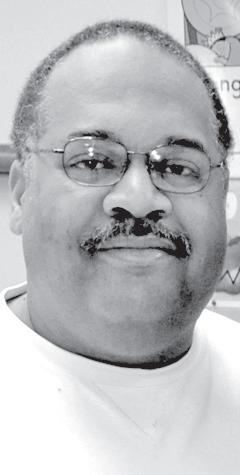
Second-year pro Luka Doncic of the Dallas Mavericks has been on fire in his team’s first-round matchup against the heavily favored Los Angeles Clippers. A 21-year old superstar from Slovenia, Doncic has already posted a pair of 40-point performances against the Clippers. Last Sunday, Doncic had a 43-point, 17-rebound, 13-assists masterpiece in Game 4 which culminated in his
3-pointer at the buzzer to give the Mavs a 133-132 overtime victory.
Later that night on the same court, it was time for Donovan Mitchell of the Utah Jazz and Jamal Murray of the Denver Nuggets to take center stage. Both 23 years old, these two young phenoms made history in the Jazz’ Game 4 victory over the Nuggets. Mitchell finished with 51 points while Murray was right behind with 50, making it the first time in NBA playoff history that two players scored 50 points in the same game.
Tiger Woods told ESPN that he misses fans at PGA Tournaments. “Obviously, the energy is not anywhere near the same. There isn’t the same amount of anxiety and pressure and people yelling at you and trying to grab your shirt, a hat off you.”
The St. Louis Blues were dispatched by the Vancouver Canucks in their opening round playoff series in six games. I read several comments from Blues fans saying officials didn’t allow the Blues to play their “heavy” style of hockey. In another sport with other players, these fans would be replaced the word “heavy” with “thuggish.”
With several NBA head coaching jobs open and the Big Ten putting basketball on hold until at least January, Juwan Howard says he is staying at Michigan.
Here’s something so crazy it makes sense: There are rumors that the Brooklyn Nets are trying to lure San Antonio head coach Gregg Popovich to that franchise.
Alabama coach Nick Saban says he wants football this fall “for the players” and not for the money. Yeah, right. Alvin A. Reid won Missouri Press Association’s 2017 “Best Sports Columnist – Weeklies.” His Twitter handle is #aareid1
Since the NBA’s restart in late July, the Bubble has served as a great stage for these young stars to showcase their talents to a captive audience. You can also add Devon Booker of the Phoenix Suns, rookie Ja Morant of the Memphis Grizzlies, fellow rookie Zion Williamson of the New Orleans Pelicans and former Columbia Father Tolton star Michael Porter Jr to that mix. As I stated before, the future of the NBA is in good hands.
Earl Austin Jr.
With Alvin A. Reid
Alvin A. Reid
Photo courtesy St. Louis Cardinals Twitter
Bishop McGovern succeeds Bishop Edward K. Braxton in Belleville
One of the nation’s 10 Black bishops turned 75, the age of retirement, last year
American staff
Pope Francis recently accepted the resignation of Bishop Edward K. Braxton after 15 years of service as the Bishop of the Catholic Diocese of Belleville, Illinois. Braxton, who had headed the Belleville Diocese since 2005, turned 75 last June, the age at which bishops are required to turn in their resignation to the pope.
Braxton, who had been one of the nation’s 10 Black Catholic bishops, welcomed his successor in the name of the faithful of the diocese and in his own name, “assuring him of our fervent prayer.”
“I pray the Holy Spirit will empower him with the grace and gifts he will need” to spread the Gospel in the small mostly rural diocese with limited pastoral resources diocese, Braxton said in a video announcement necessitated by public health guidances relative to the COVID-19 pandemic.
The Belleville Diocese covers 11,678 square miles and has a Catholic population of about 91,000 out of a total population of about 842,000.
Braxton was born in Chicago and he was ordained a priest for the Chicago Archdiocese. He is a former auxiliary bishop of St. Louis and former bishop of the Diocese of Lake Charles, Louisiana.

“He has been a strong advocate for greater church openness to African Americans, including ways of better expressing the faith to a Black culture,” the Catholic News Service reported.
“In 2015, he wrote a pastoral letter on the racial divide in the United States. In 2017, in a presentation at The Catholic University of America in Washington he said every person ‘must do something,’ whether big or small, to address racism in this country.
“In 2019, a year that saw many multiple shootings, Braxton decried the ‘crisis of gun violence’ in the United States and asked Catholics in his diocese to come together and think of ideas to stop these tragedies from recurring.”
The pope named Father Michael G. McGovern, a priest of the Archdiocese of Chicago, as the new Bishop of the Catholic Diocese of Belleville, Illinois. Bishop McGovern was installed on July 22. McGovern brings to his new post many “natural talents and his pastoral experiences,” Braxton said.
“Since receiving news of this appointment, I have been praying each day for Bishop Edward Braxton and I thank him for his 15 years of dedicated service to the Diocese of Belleville.” McGovern said. “I



have been praying as well each day for the clergy, religious and lay faithful of the diocese.”
Bishop McGovern, a native of Evergreen Park, Illinois attended Christ the King Grammar School and St. Ignatius College Prep, both in Chicago. He graduated from Loyola University Chicago in 1986, and from St. Mary of the Lake Seminary in Mundelein, Ill., earning an S.T.B in 1993 and a M.Div. in 1994. He was ordained to the

priesthood on May 21, 1994 at Holy Name Cathedral in Chicago. Bishop-elect McGovern has had several parish assignments including as Resident at Immaculate Conception Parish, Highland Park, and at St. Clement Parish and Holy Name Cathedral, both in Chicago.
“I thank Bishop Edward Braxton for his warm welcome as his successor and for the conversations we have had,” McGovern said.
The Message
Have you kept your promises?
God’s covenant is an agreement, a promise between us and Him. If you have lived any at all, you’ve had people make promises to you that they had no intentions of keeping, failed miserably while trying to keep or didn’t care whether they kept or not. You may even be a promise breaker rather than a promise keeper.
I’ve got to assume God, if anybody, keeps His Word. Therefore, it stands to reason that this covenant, this promise God made to Abraham, the one which Jesus came to fulfill, is one we should take to our graves as fact.
If I understand the importance of keeping one’s promises, then I should be extremely careful about making promises. It appears that the basis for spiritual belief is based on a simple promise.
To Abraham: “As for me, this is my covenant with you... you will be the father of many nations. I will make nations of you and kings will come from you. I will establish my covenant as an everlasting covenant between me and you and your descendants after you for generations to come, to be your God and the God of the descendants after you. I will be their God.” Genesis 17:2-8. From Jesus to the disciples, “This cup is the new covenant in my blood... for whenever you eat this bread and drink this cup, you proclaim the Lord’s death until He comes.” 1 Corinthians 11:25-26. Wow!

Remember this is God talking about His promise to us. Have you made any promises to Him lately, to yourself about Him, to anybody you love or, to someone who loves you? Have you kept those promises? Are you a covenant keeper or a covenant breaker? Can you count on yourself to speak the truth? Do you believe you when you talk?
This covenant thing is such a powerful concept because of the nature of its beginning. A promise is Godly. It has to be. The first promise was made to Adam and Eve. It all gets caught up in words and the power of words and the understanding of words – God’s words, our words, words. They have incredible power, if only we understand them in the context of covenant. They are our vehicles for communicating with the original covenant maker.
I am, thus, accountable to a higher power for everything that I say. And guess what? So are you! Knowing this, my obligation is to emulate the following. “So shall my word be that goes forth out of my mouth.” Isaiah 55:11. This covenant is a wonderful thing because God surely keeps His Word. If I am made in His image then honesty should be the stuff my promises are made of.

Bishop Edward K. Braxton
S
. LouiS american Career Center

INTAKE SPECIALIST
HS Diploma and two (2) years of experience, preferably related to administration of the Housing Choice Voucher or the affordable housing programs. Process assigned applicants for the Housing Choice Voucher program in a manner that provides accurate information, and responsive customer service. Duties include scheduling appointments, interviewing applicants, organizing large volumes of data, tracking different types of information, performing calculations and maintaining data on the computer system. Good communication skills and ability to deal with the public. Starting Salary $36,855 Annually. Apply or send resume to: St. Louis Housing Authority, HR Division, 3520 Page Blvd., St. Louis, MO 63106 by 5:00 p.m. September 8, 2020 via our website www.slha.org or email athomas@slha.org. A Drug Free Work Place/ EOE.
BID SOLICITATION
L. Keeley Construction Co. is seeking qualified, disadvantaged businesses (DBEs) proposals for the Metropolitan St. Louis Sewer District Caulks Creek Forcemain (River Valley Rd to L-52) Project under Letting No. 11790-015.1. Work to be completed: Construction of approximately 8,130 LF of 36” diameter sanitary force main, and 1,020 LF of pipe sewer varying in size from 10” to 36” in diameter, appurtenances, and restoration to be constructed in an area located north of Waterworks Road and west of Creve Coeur Mill Road, in the City of Maryland Heights, MO. L. Keeley will host a virtual pre-bid meeting on September 2nd. Please contact Elise Brown at elise.brown@lkeeley.com to register and receive meeting call in information. Proposals are due via email by Close of Business on Wednesday, September 16th, 2020 to Curt Mauldin via email at cmauldin@lkeeley.com. All negotiations must be completed prior to September 16th.
CLIENT ANALYST
HS Diploma. Responsible for processing assigned caseload for the Housing Choice Voucher Program (Section 8). Conducts interviews, orientation sessions for applicants seeking assistance through Section 8. Process changes in client status to vacate, evictions, inspection action notifications, voucher issuance, program terminations, contracts, lease agreements, inspection requests, income changes, interim reviews, housing assistance payment adjustments and/or withholdings. Good communication skills and ability to deal with the public. Must type 30 wpm. Starting Salary $36,855 Annually. Apply or send resume to: St. Louis Housing Authority, HR Division, 3520 Page Blvd., St. Louis, MO 63106 by 5:00 p.m. September 8, 2020 via our website www.slha.org or email athomas@slha.org. A Drug Free Work Place/EOE.
CROWN CENTER SENIOR APARTMENT
HBD Construction is soliciting MBE/WBE bids for this project.
This is a new 5 story building consisting of a 4-story wood frame over a non-combustible podium, 52 units, 61,389 SF Senior Living building. Plans are available on line at Dodge or at this link
https://www.dropbox.com/sh/ t2hnhy3pqv5qct8/ AABvGoldWzLigAscB7 6xCEVa?dl=0
Bids are due September 9th at 5pm in HBD’s office
ST.
LOUIS
COMMUNITY COLLEGE
The St. Louis Community College is requesting submittals of experience and qualifications from landscape architectural firms, Consulting Agreement Contract No. A21 0321 for Design Services for Landscape Design of Plaza at St. Louis Community College Forest Park. Submittals of the Consultant’s qualifications will be received by St. Louis Community College, in the Engineering and Design Department until 2:00 p.m., September 21, 2020, at the office of the Manager of Engineering and Design, 5464 Highland Park Drive, St. Louis, MO 63110-1314 or by email at kkempf@stlcc.edu. The scope of services and consulting agreement procedures may be obtained from the Manager’s office, at the above address or by calling (314) 644-9770.
An Equal Opportunity and Affirmative Action Employer
CITY OF ST. LOUIS BOARD OF PUBLIC SERVICE
REQUEST FOR QUALIFICATIONS for CONSTRUCTION SUPERVISION AND MATERIAL TESTING FOR THE RECONSTRUCTION OF TAXIWAY DELTA FROM TAXIWAY CHARLIE TO RUNWAY 6-24 AND THE RECONSTRUCTION OF RUNWAY 12R-30L FROM TAXIWAY ROMEO TO TAXIWAY GOLF, ST. LOUIS LAMBERT INTERNATIONAL AIRPORT. Statements of Qualifications due by 5:00 PM CT, September 30, 2020 at Board of Public Service, 1200 Market, Room 301 City Hall, St. Louis, MO 63103. RFQ may be obtained from BPS website www.stl-bps.org, in the On Line Plan Room, or call Board of Public Service at 314-622-3535. 35.86% DBE participation goal.
POLICE OFFICERS
The City of Richmond Heights is accepting applications for Police Officers. To apply go to https://richmondheights. applicantpro.com/ jobs/1495281.html Applications will be accepted from August 24, 2020 through September 11, 2020.
POLICE OFFICER (TRAINEE)
This is the entry-level Police Officer position with the City of St. Louis Department of Public Safety Police Division. Incumbents patrol to protect life and property and enforce laws and ordinances with tactful and courteous treatment of the public. Police Officer (Trainees) receive $1,539 bi-weekly. Upon completion of the training period at the Police Academy, Police Officer (Trainees) become Police Probationary Officers and are placed in an eleven month working test period with a salary of $47,815. Upon completion of the working test period, Police Probationary Officers become Police Officers with a salary of $49,140. City residency requirement may be waived for this position. To apply, visit the City web site at www.stlouis-mo.gov or call the City of St. Louis Department of Personnel at 622-4308.
CHIEF PROGRAM OFFICER
This position will partner with the Leadership Team to establish the goals, impact measures and strategic direction of Covenant House Missouri’s (CHMO) programs. The Chief Program Officer is responsible for all program planning, organizing, operating, and staffing— making sure that they are centered on the best interests of the youth.
The Chief Program Officer also has the responsibility for developing, implementing, and managing the program aspects of the annual budget in conjunction with the Directors.
To apply, visit our website at www.covenanthousemo.org
BIDS & NOTICES
CITY OF ST. LOUIS ST. LOUIS LAMBERT INTERNATIONAL AIRPORT
Solicitation For Bids (SFB) for SOLID WASTE & RECYCLING SERVICES
Bids Wanted
Bid documents may be obtained at St. Louis Lambert International Airport, Airport Properties Division, Monday through Friday between 8:30 a.m. and 5:00 p.m., or by calling (314) 890-1802. This SFB may also be obtained by visiting our website at www.flystl.com/business/ contract-opportunites.
Robert Salarano Airport Properties Division Manager
BID PROPOSAL
K&S Associates, Inc. is soliciting MBE/WBE for the following project for September –St. Louis County Library –Administrative Library Building can be viewed at www.ksgcstl.com-submit bids to estimating@ksgcstl.com or Fax 314-647-5302
PROGRAM MANAGERSTRATEGIC INITIATIVES
The Program Manager is accountable for overall project planning, management, and providing support to Committees, Workgroups and Partner Organizations for innovative, collaborative initiatives. For more information please go to: https://www.bhnstl.org/careeropportunities
Please send resume and cover letter with salary expectations to bhn@bhnstl.org
The Industrial Development Authority of the County of St. Louis, Missouri (the “IDA”) solicits proposals from qualified firms to serve as a financial advisor for the IDA’s operations. A copy of the complete RFQ is available at https://stlpartnership.com/rfp-rfq/. DBE, MBE, and WBE consultants are encouraged to bid, and a five percent bid preference may be available to certified MBE firms. To be considered, proposals must be received no later than 3PM CST on Thursday, September 3, 2020.
St. Louis Economic Development Partnership Equal Opportunity Employer
URBAN LEAGUE OF METRO. STL INVITATION FOR BID FOR INSULATION CONTRACTORS (ULMSLWP) is soliciting sealed bids for the completion of Air Infiltration and Insulation Work (approximately 10-15 homes per month) to be completed in the city of St. Louis, MO. Contracts to provide weatherization work for residential properties from October 1, 2020 to June 30, 2021 with a first year renewal option of up to two additional years.
For Bid Specifications Contact: Urban League of Metropolitan St. Louis, Inc. (314) 615-3608 lmiller@urbanleague-stl.org
Pre-Bid Virtual Conferences: September 11, 2020 at 4:00 PM Call 314 615-3628 for Log In Access Bid Due Date: September 18, 2020 at Noon Bid Opening: September 18, 2020 at 2:00 PM
Funding on behalf of Missouri DNR, DSS, Ameren and Spire Gas
ADVERTISEMENT FOR PROPOSALS
The City of St. Peters is seeking proposals for the “20-168 - Missouri 370 - Salt River Rd Ramps 1 & 2/3 Design Project” until 2:00 p.m. local time, Friday, September 18, 2020. This will be a Non-Public opening.
The proposal can be received by sending a request to Bids@stpetersmo.net and specifying in the subject line “20-168 - Missouri 370 - Salt River Rd Ramps 1 & 2/3 Design Project”, or by obtaining at City of St. Peters, One St. Peters Centre Boulevard, St. Peters, Missouri 63376 beginning Thursday, August 27, 2020.
If your firm would like to be considered for providing these consulting services, please prepare a Technical Proposal. This proposal should include any information which might help us in the selection process, such as the persons or team you would assign to each project, the backgrounds of those individuals, and other projects your company has recently completed or are now active. The proposal shall be submitted in quadruplicate, in a sealed container, and clearly marked with the Consultant’s name and “20-168 - Missouri 370 - Salt River Rd Ramps 1 & 2/3 Design Project.”
The proposal must be received by the City of St. Peters Purchasing Department by 2:00 p.m., local time, Friday, September 18, 2020.
All questions regarding the project and proposal submittal are to be submitted via e-mail to Bids@stpetersmo.net and specify in the subject line “20-168 - Missouri 370 - Salt River Rd Ramps 1 & 2/3 Design Project”, or by mail to City of St. Peters, One St. Peters Centre Boulevard, St. Peters, Missouri 63376 before noon local time, Friday, September 11, 2020.
The City of St. Peters will evaluate firms based on a) experience and competence, b) the capacity of the firm to perform the work in the timeframe needed, c) past performance, and d) proximity to and familiarity with the project area. (23 CFR 172 Administration of Engineering & Design Related Service Contracts and RSMo 8.285 through 8.291).
Once a proposal is selected, a contract will be negotiated, with the firm, based on a mutually agreed upon scope of services. This project has received Missouri Department of Transportation Cost Share funding for all phases, and federal STP-S funding for construction phase only. A DBE goal of 14% has been determined by Missouri Department of Transportation for the Preliminary Engineering portion of the project.
DBE firms must be listed in the MRCC DBE Directory located on MoDOT’s website at www.modot.gov, in order to be counted as participation towards an established DBE Goal. We encourage DBE firms to submit proposals as prime consultants for any project they feel can be managed by their firm. It is required that your firm’s Statement of Qualification (RSMo 8.285 through 8.291) and an Affidavit of Compliance with the federal work authorization program along with a copy of your firm’s E-Verify Memorandum of Understanding (15 CSR 60-15.020) be submitted with your firm’s technical proposal and with your firm’s Letter of Interest. It is also required that your firm be prequalified with MoDOT and listed in MoDOT’s Approved Consultant Prequalification List.
The City reserves the right to waive any informality and to accept the proposal most advantageous to the City.
OFFICE SUPPLIES
RFP 2020
The Saint Louis Zoo seeks bids from qualified contractors to bid on Office Supplies RFP 2020. Bid documents are available as of 8/26/2020 on the Saint Louis Zoo website: stlzoo.org/vendor
PUBLIC HEARING NOTICE
The Board of Alderpersons of the City of Pagedale will hold a Public Hearing on Thursday, September 10, 2020 at 6:30 pm via ZOOM to hear citizen’s comments regarding Petitions to rezone “A” Residential property located at 1311 Colby; “D” Industrial property located at 7013 Page and “Vacant/Agriculture” properties located at 1307 Colby and 1313 Colby to “C” Commercial consistent with the City of Pagedale City Codes and/or Ordinances.


NOTICE OF VIRTUAL (ONLINE) PUBLIC HEARING
ON LOCATION AND DESIGN OF THE RECONSTRUCTION OF THE COMPTON AVENUE BRIDGE OVER MILL CREEK VALLEY RAILYARD
Notice is hereby given to all interested persons that a virtual (online) public hearing will be held on Thursday, September 10, 2020, from 4:00 p.m. to 7:00 p.m., Central Daylight Time. Interested persons may access the virtual meeting at www.ComptonBridge.com. During the virtual meeting, participants will be given an opportunity to submit written comments concerning their views on the location and design of the Replacement of the Compton Avenue Bridge over the Mill Creek Valley Railyard with reference to the economic and social effects of such location and design, its impact of the environment, and its consistency with the goals and objectives of the community. City representatives will be available to address questions/ comments during this meeting as they are submitted. The website will remain online for one week following the scheduled meeting for viewing. The presently contemplated improvements are as follows:
The existing Compton Avenue Bridge, located between Chouteau Avenue and Spruce Avenue, will be demolished in its entirety and replaced. The new bridge will carry four lanes of vehicular traffic, protected bicycle lanes, and a pedestrian sidewalk.
Maps, plats, environmental documentation, and other detail information prepared by the City of St. Louis and their consultant will be available for public inspection and copying at the office of the City of St. Louis, Board of Public Service, Room 301 City Hall. Submitted questions and comments will be answered during the Written statements and exhibits as well as oral statements will be received at the hearing. Written statements and exhibits will be made a part of the public hearing transcript if received within ten days after the date of the hearing.
Tentative schedules for right of way acquisition and construction will be discussed at the hearing.
For those unable to access the virtual meeting, they are encouraged to contact Kevin Trapp at the City of St. Louis, Board of Public Service, at trappk@stlouis-mo.gov or (314) 589-6606, and accommodations will be made to share the information and gather feedback.
CITY OF ST. LOUIS
BY Kevin Trapp, P.E. Asst. Chief of Design Board of Public Service
REQUEST FOR QUALIFICATIONS
The Brentwood School District is soliciting qualified bids to contract for an owner’s representative/ construction manager position. For further details please refer to the RFQ on our website at: http:// www.brentwoodmoschools.org, Hoover over the About Us tab, then Public Notices
METROPOLITAN ST. LOUIS SEWER DISTRICT
Notice is hereby given that the Metropolitan St. Louis Sewer District Requests for Quotes, Bids and Proposals are posted online for public download. Please navigate to www.msdprojectclear.org > Doing Business With Us > View Non-Capital Bids (commodities and services) or >Visit Planroom (capital construction bids)
Metropolitan St. Louis Sewer District is an Equal Opportunity Employer.


BIDS SSD 126-20
Notice to contractors, Special School District is accepting bids for North and South Tech Salt Storage Project For details, please visit the website at www.ssdmo.org/rfps.html

Cori Bush returns to alma mater
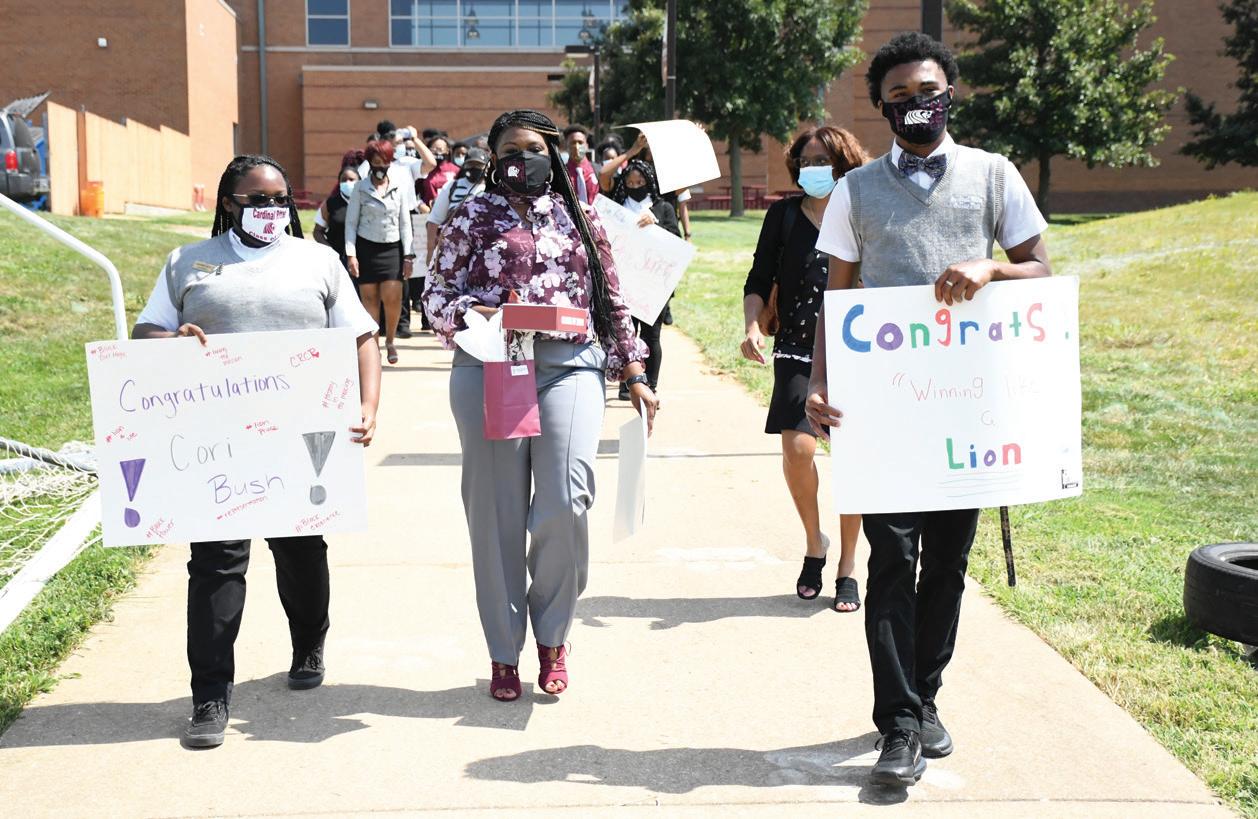

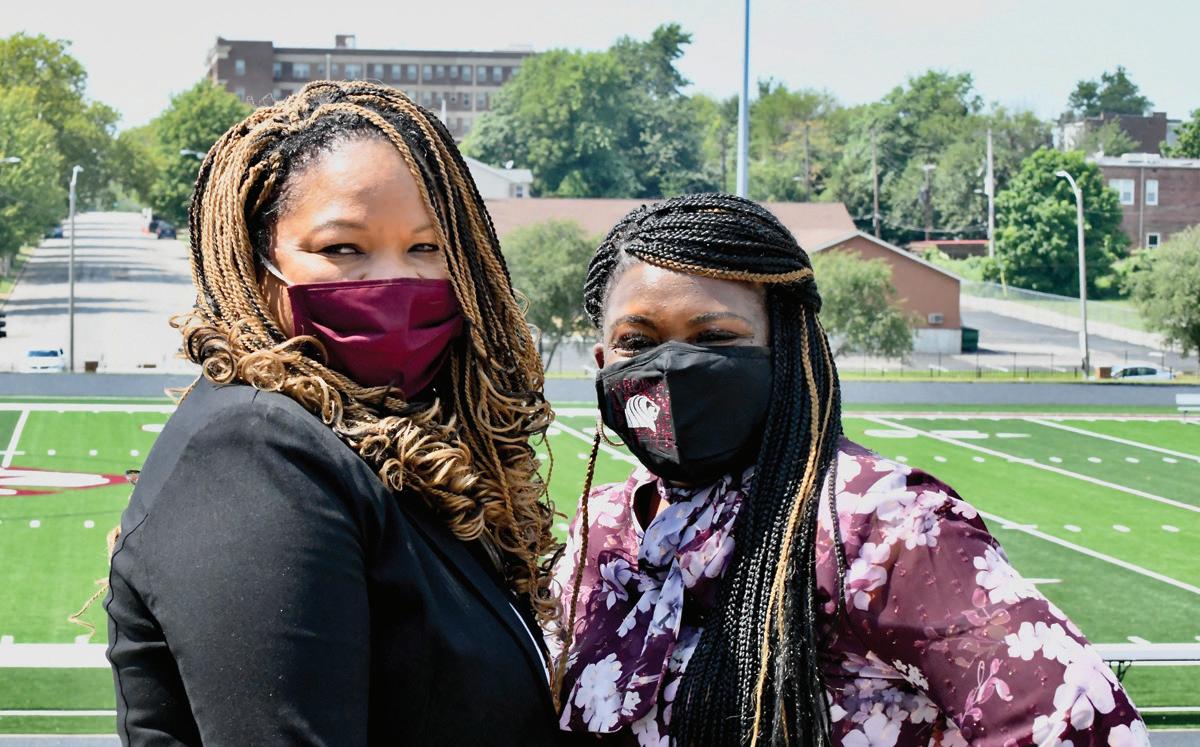
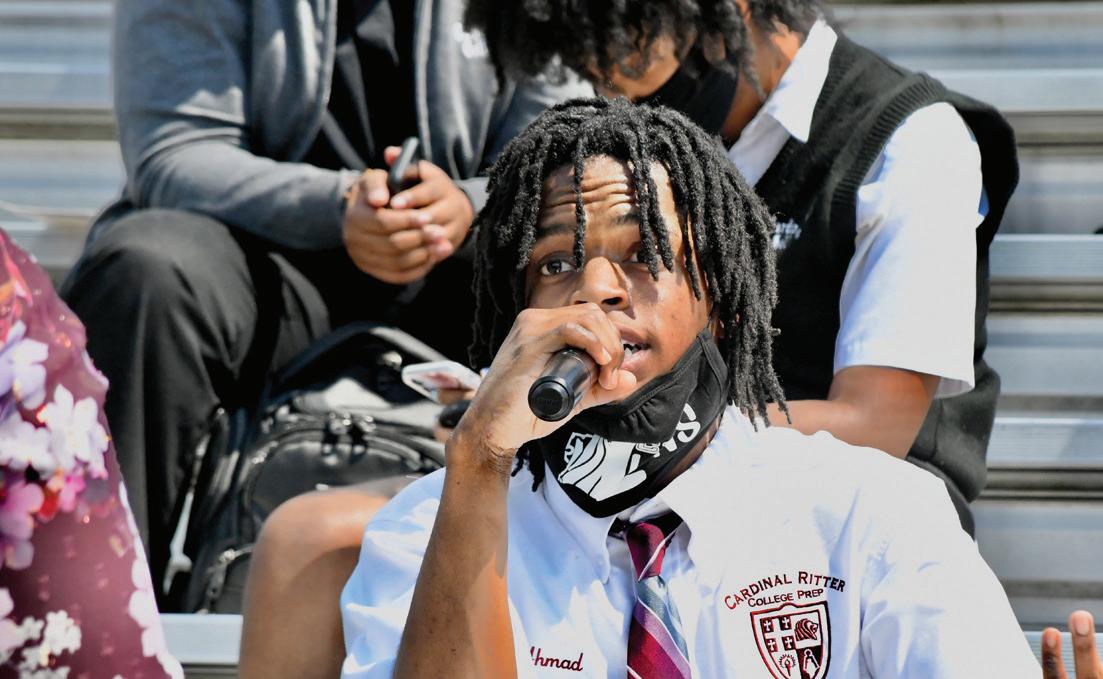
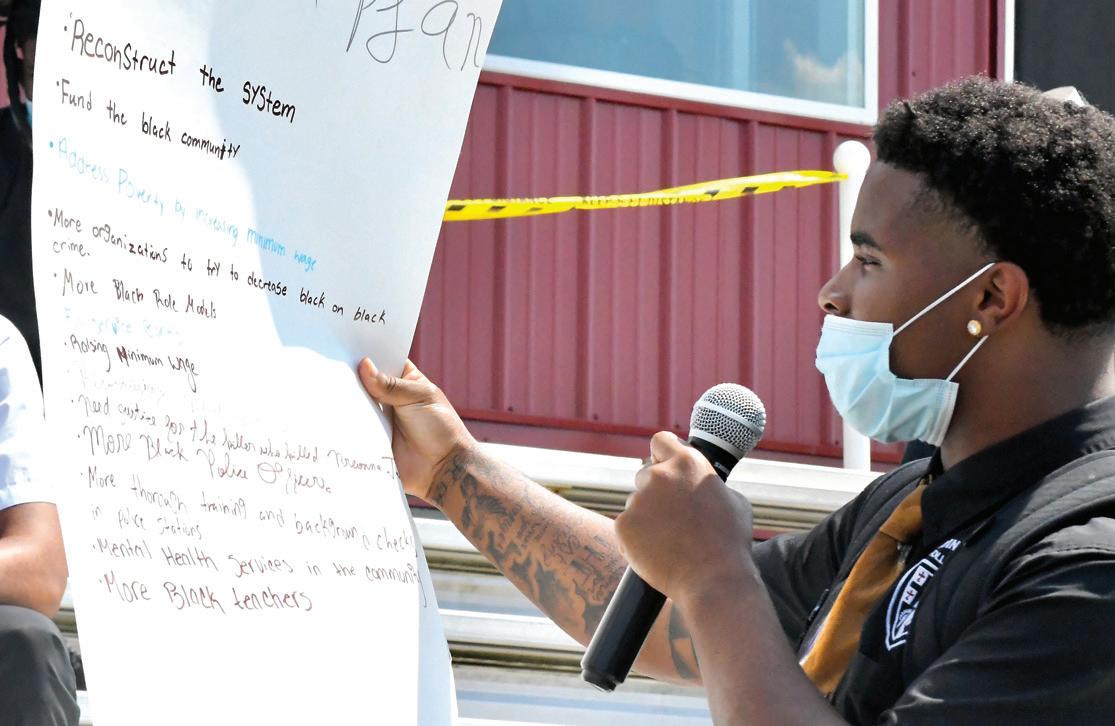
Cori
of 1994, returned to her alma
Cardinal
to address the Class of 2020 as seniors returned to school on Monday, August 24.
“Our entire first day back is focused on social justice for all of our kids,” said Tamiko Armstead, school president. “We’ve been starting school this way since August 2014 and Michael Brown.” It is a fitting tradition for Bush to embrace. Now the Democratic nominee for Congress in Missouri’s 1st Congressional District and poised to make history as Missouri’s first Black congresswoman, Bush first came into public view as a protest organizer.
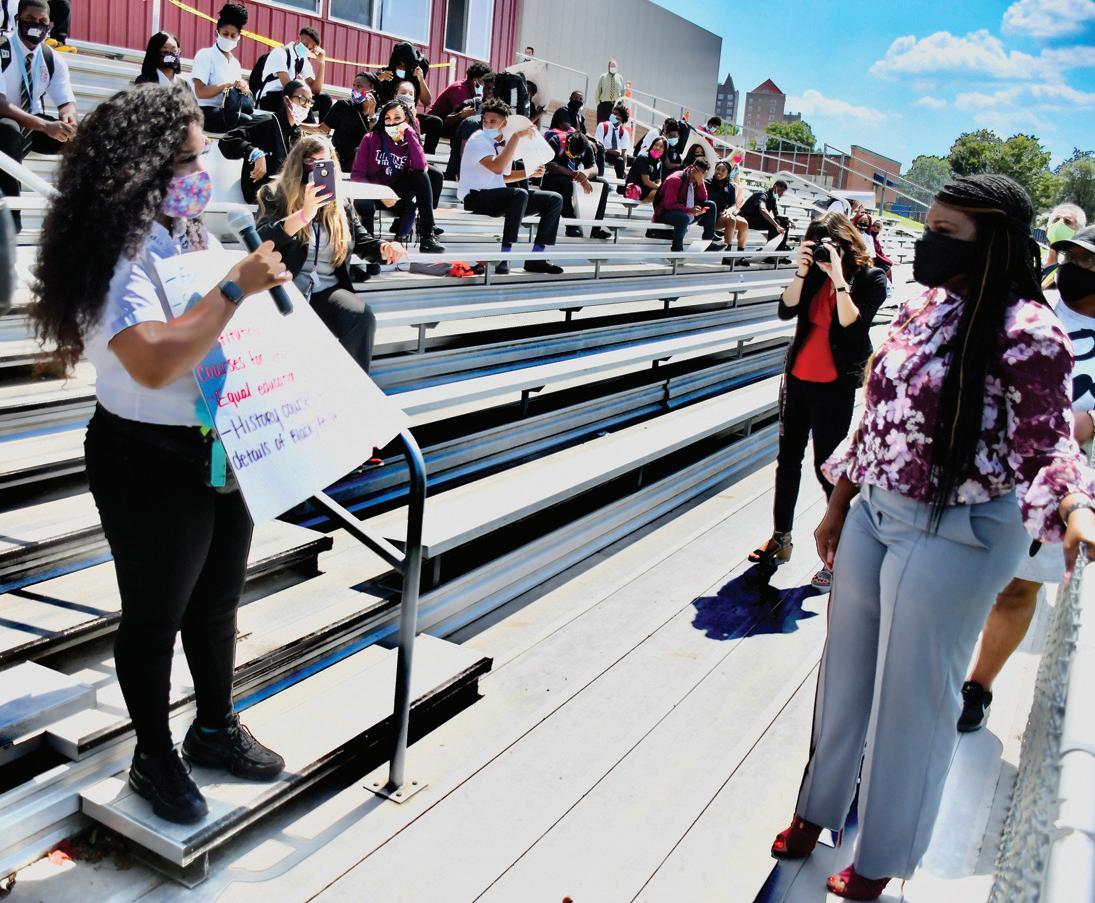
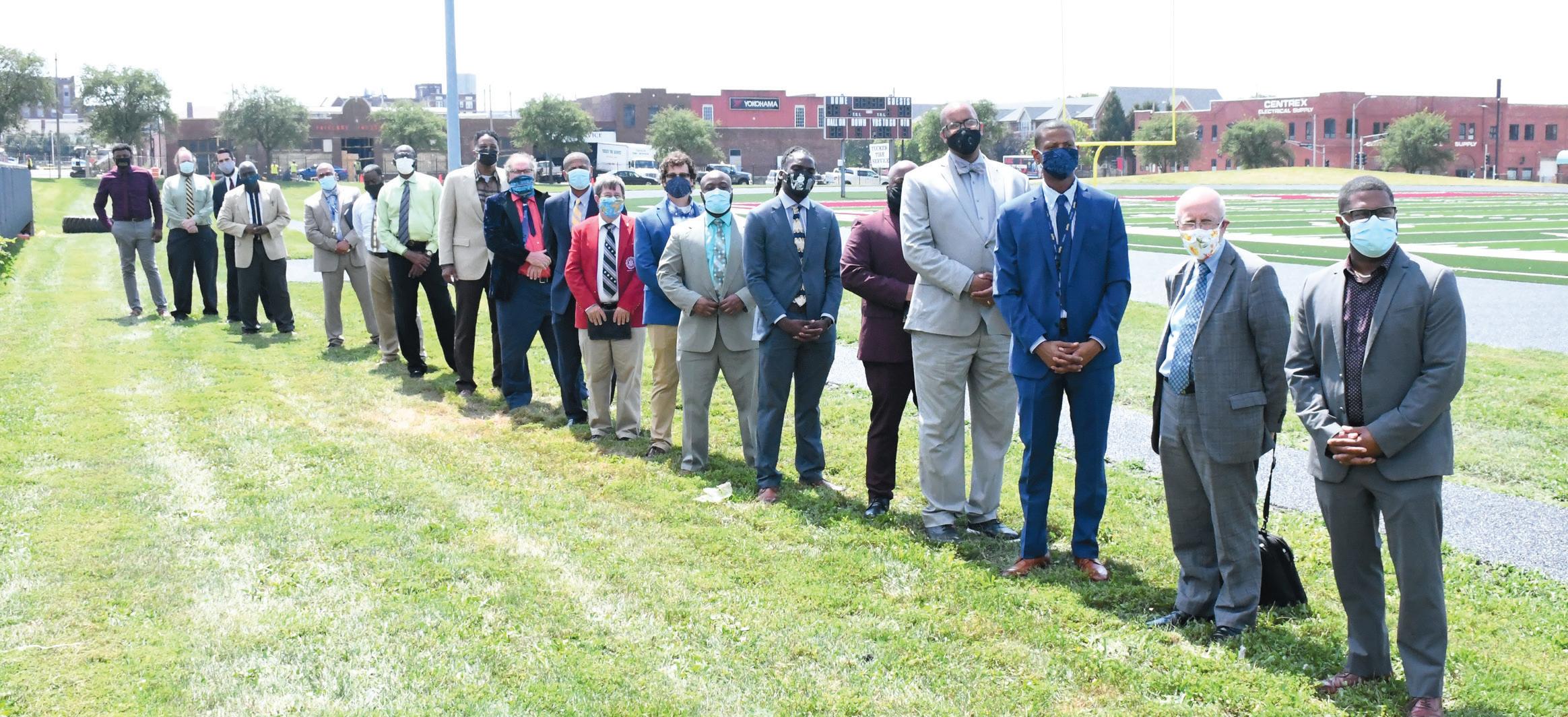
Bush, Class
mater,
Ritter College Prep,
Photos by Wiley Price
Cardinal Ritter seniors Gabrielle James and Maliachi Davis walk with alumna Cori Bush (center), the Democratic nominee for Missouri’s 1st Congressional District, during her visit Monday, August 24 on the first day of school.
April Brown, the business manager for Cardinal Ritter and a 1987 alumna, poses with Cori Bush, Democratic nominee for Missouri’s 1st Congressional District, during a visit to her alma mater.
Cardinal Ritter President Tamiko Armstead making a point during the visit of alum Cori Bush Mon. Aug. 24, 2020 on the first day of school.
Cardinal Ritter had all their male faculty and staff stand in support of the young men that attend the school during Cari Bush’ visit.
Cardinal Ritter senior Bill Jackson asked a question to alum Cori Bush about minimum wage during her visit Mon. Aug. 24, 2020 on the first day of school.
Mo. 1st Dist. congressional candidate for U.S. congress Cori Bush (right) made a visit to her high school alma mater Cardinal Ritter College Prep High School. Senior Nyjahl Vaughn asked Bush about funding community programs while taking questions from the students.
Cardinal Ritter senior Ahmad Minnis asked a question of concerning criminal justice to alum Cori Bush

The NAACPer
• August 2020 Edition •
In search of a more equitable St. Louis
Structural and legal racism in this country has its roots in the 1857 U.S. Supreme Court Dred Scott vs. Sandford decision that argued the Constitution intentionally excluded Blacks from citizenship. The structural and legal discrimination that fostered that decision decimated generations of Black communities and its infrastructure.
The proposed public-private partnership agreement for the St. Louis airport is one way, after decades of decay, to assure infrastructure improvements for streets, bridges, water and much more in communities that need it most, while increasing revenue without increasing taxes.
It is ironic that the most vocal opposition to a possible public private partnership also profess to have as a primary objective of fostering “Equity.” Equity is a term that we all seem to understand at some level, but we all don’t share the same definition. Having a clear definition of equity is paramount to any actions around equity-related work.
Merriam-Webster’s “simple definition” of equity is “fairness or justice in the way people are treated.”
A lot of people like to think that achieving diversity and inclusion is equity…but that’s not necessarily the case… it’s definitely a step in the right direction. What is equity if its not diversity, inclusion, or equality? Equity is deeper and more complex, It is about each of us getting what we need to survive or succeed—access to opportunity, networks, resources, and supports—based on where we are and where we want to go.
In order to achieve “Equity” (a more equitable St. Louis) we have to “rise” to the occasion by establishing
A path forward
In the United States, governments are increasingly turning to public-private partnerships (P3s) to implement expensive public infrastructure projects. A 2016 Syracuse University study concluded that US-based projects have a significantly higher likelihood of meeting cost and schedule objectives with public-private partnerships compared to traditional public sector projects owned, managed, and financed by the government.
There are many success stories like the George Deukmejian Courthouse in Long Beach, California that accelerated replacement of a badly outdated and poorly functioning building. California awarded the project to a private consortium that completed the building on time and within budget, when it opened in May 2014. As of January 2016, the Federal Highway Administration identified 35 states, the District of Columbia, and Puerto Rico that are using various public-private partnerships for transportation infrastructure projects.
A similar public-private partnership for the airport could allow the city to address infrastructure improvement and maintenance of our neighborhoods; along with our roads, bridges, etc.

a solid foundation to build on. A foundation that will provide for us all to live in clean livable safe neighborhoods; spur neighborhood development; provide job training for our unemployed and under-employed residents; repair our aging infrastructure (streets, bridges, parks and our
airport); while increasing our revenue streams without increasing taxes.
Diversity is being invited to the house, Inclusion is being able to decorate it!
- Barb McElroy

The Charter of the City of St. Louis
The constitution of the City of St. Louis is its Charter; it was adopted by the vote of the citizens on June 30, 1914 and can only be changed by a vote of the people. And according to the Charter the people retain the right to legislate through the initiative procedure.
The Charter also gives the people the power, at their option, to propose ordinances, including ordinances proposing amendments to the charter, and to adopt the same at the polls, with the same effect as if adopted by the board of aldermen and approved by the mayor, such power being known as the initiative. The original city charter has changed over the past decades, but its function has stayed the same. It establishes how our City government operates; it controls everything including the number of wards in the city to the day of the week for municipal elections. Our Charter provisions can only be changed by a vote of the people, city ordinances can be changed by a vote of the Board of Alderman.
A good example of the citizens passing initiatives to improve the City is Prop NS, a citizen-led initiative that was approved on the April 2017 ballot. It asked city residents to increase property taxes to pay for a new project to restore vacant houses owned by its Land Reutilization Authority, or LRA.
Sometimes it takes a statewide vote of the people to make change such as in 2012 it took a vote of the

people to returned control of the St. Louis Metropolitan Police Department to city government by passing Proposition A; and most recently the people voted to approve Medicaid Expansion.
In 2013 the people passed Proposition P, a sales tax
increase to improve parks, trails and the Gateway Arch grounds. A few other examples would be a vote of the people locally in 2017 to pass Propositions for police and fire; the MetroLink expansion tax, and Proposition C, which amended the city’s charter to give city residents preference over non-city residents in securing civil service jobs.
Airport Investment Partnership Program, formerly Airport Privatization Pilot Program
Application process. A public airport sponsor and the private operator selected to purchase or lease an airport may request participation in the program by filing an application for exemption under Title 49 United States Code § 47134(a).
A public sponsor may submit a preliminary application for FAA to accept for review. It must contain summary narratives identifying the objectives of the privatization initiative, a description of the process and a realistic timetable for completing the program, current airport financial statements, and a distribution ready copy of the request for proposal/qualifications. The FAA has 30 days to review the preliminary application.
The airport sponsor may select a private operator, negotiate an agreement, and submit a final application to the FAA. There is no timeline for the FAA to complete its review of the final application.
After the FAA reviews and accepts the final application and lease agreement, it publishes a notice in the Federal Register for public review and comment period. During this period, the Department of Transportation, FAA, and Transportation Security Administration (TSA) may conduct a public meeting in the community to solicit public comment.
The FAA completes its review, prepares its Findings and Record of Decision (ROD), addresses the public comments in the ROD, and publishes the agency decision.

If the FAA approves the privatization application in the ROD, it monitors the legal settlement and transfer of the
airport from public owner and sponsor to the new private operator and sponsor.
The NAACPer August 27 - September 2, 2020
Be it enacted by the voters of the City of St. Louis that the City Charter is hereby amended by added one new Article, which shall read as follows: Article XXVII – St. Louis Lambert International Airport Long Term Lease.
(1) Notwithstanding any provision of the Charter to the contrary, the City of St. Louis is authorized to participate in the Airport Investment Partnership Program pursuant to 49 U.S.C. 47134, provided that the net present value of the full lease payment, including the amount required to pay or defease all Airport debt, shall not be less than one billion, seven hundred million dollars ($1.7 billion), with a minimum of one billion dollars ($1.0 billion) at the time of closing to be deposited in the trust accounts created in this Amendment.
(2) The City of St. Louis (the “City”) shall not have the authority to sell the St. Louis Lambert International Airport (the “Airport”) to any entity.
You have just read the first two sentences of a Proposition to explore entering into a Public Private Partnership of St. Louis Lambert International Airport. Any information to the contrary is false.
The Proposition further states: any such lease shall not exceed a term of forty-nine (49) years; and any existing Airport debt, including any and all revenue bonds, be fully and finally paid or defeased by the Lessee. The ultimate term of any lease will be determined through negotiations; and while we are not aware of an express
A lifeline for Lambert and the City of St. Louis Protecting Airport Employees”
The Proposition provides that The Lessee of the Airport under the provisions of this Amendment (the “Employer”) will have to abide by the document that encompasses both a Labor Peace Agreement (“LPA”) as well as the adoption of any and all collective bargaining agreements in place at the time of being awarded the lease and agree to negotiate successor collective bargaining agreements with appropriate bargaining units at those agreement’s expiration.
Any resulting collective bargaining agreement, if any, shall also be binding upon any and all successors, purchasers, assignees, subcontractors, or transferees of the Employer whether such succession, purchase, assignment, subcontract, or transfer is affected voluntarily or by operation of law: and in the event of the Employer’s merger, consolidations, assignment or transfer of current employees to another company or public or private entity, these terms shall be binding and continue in full force and effect upon the entity with which employees are merged, consolidated, or transferred (in whole or in part).
In all events, all current employees will maintain their original hiring date in their position at the time prior to the Employer’s involvement and contract regarding the Airport, will not be considered as new hires, and thesuccessor, purchaser, assignee, transferee, or merged, consolidated, or subcontract companyor entity, public or private, entity will carry out the terms of any collective bargaining agreement then in effect, including voluntary recognition of the unions, a Fair Share agreement to replace the current union security clause, to the extent enforce-

legal requirement prohibiting a lease over 49 years by the City. There is some case law on longer leases being viewed as sales in certain circumstances, but nothing concrete. We put the 49 year limit in as a safety measure.
The Proposition further provides “The lease shall require that Lessee, and the Lessee alone, use commercially reasonable efforts to have the Airport facilities upgraded to and remain in the top ten percent (10%) of all large or medium hub airports in the United States as determined by a national or international evaluator such as JDPower, Skytrax or similar entity.”
The proposition provides that “Safety and security at the Airport will be maintained at the highest possible levels” and an “annual audit and all related reports shall be made available to the public, with no redactions, within ten (10) days after the audit is presented or delivered to the Committee.”

Reinforcing the Public Safety Net and transforming policing
The Proposition creates a Police, Fire, and Safe Neighborhood Trust Fund, at leastthirty percent (30%) of the Lease Proceeds, but not less than three hundred million dollars ($300.0 million), which shall be used solely for the purposes of public safety in neighborhoods, including for increasing compensation levels for community policing officers and reducing violent offenses through interventional behavioral health programs.
When you dial 911 for a medical emergency the first persons on the scene will more likely than not be a firefighter or paramedics with the St. Louis Fire Department…your life and the lives of your family members depend on it. But paramedics are quitting at a rate faster than replacements can be hired; the bloodshed and body count is taking its toll. Last year almost half of the paramedic positions in the city were vacant; we need reinforcements now.
In recent years there has been a shift in attitude; citizen participation in block watch programs, leadership by police in crime prevention programs, community participation in the decision-making process, and closer relationships between citizens and police reflect a growing sense of the need to do something about preventing crime instead of waiting for it to occur.
By far the most popular movement in policing today, COP attempts to change the very culture of the modern urban police department through a structural as well as functional reorganization of that department. The goal is to tighten the bonds between police officer and citizen thereby involving community residents in solving their particular neighborhood problems.

The Community Oriented Policing Section (COPS) builds community partnerships to reduce crime and increase safety. The COPS proactively fights crime
through various programs aimed at prevention, early identification, and improving quality of life.
According to the 2018 St. Louis Adult Behavioral Health Community Needs Assessment. “Throughout the past 10 years, the St. Louis City population has experienced improvements in economic and communitywellbeing (such as median household income, unemployment, violent crime and most BH emergency room visits). However, other key factors, such as housing instability and homelessness, poverty rates and BH hospital utilization have persisted or grown. Regardless of these improvements, most St. Louis City BH risk indicators and outcomes are far worse than neighboring St. Louis County and the State of Missouri. Thus, St. Louis City adults face greater challenges and greater BH needs than their counterparts. Moreover, certain areas of the City, primarily in eastern areas of far North and far South City experience the greatest impact.
Curing Violence is all about de-escalation and finding funding beyond 2020 maybe impractical taking into consideration that the current funding of $5 million came from the city’s $23 million surplus; a surplus that has all but vanished. Violence is a serious public health problem. From infants to the elderly, it affects people in all stages of life. Many more survive violence and suffer physical, mental, and or emotional health problems throughout the rest of their lives. Our Proposition is committed to stopping violence before it begins.
Neighborhood and community development are the key to creating a thriving city for all
Neighborhood Development and Building Trust Fund, at least twenty percent (20%) of the Lease Proceeds, but not less than two hundred million dollars ($200.0 million), which shall be used solely for the purposes of new development, including improvements to or repurposing of buildings, in neighborhoods with both an unemployment rate and poverty rate above the City average unemployment and poverty rates.
All our residents should live in safe, vibrant communities where they can lead successful, healthy lives. Unfortunately, many areas have not always received the attention and resources needed to overcome high rates of poverty, longtime disinvestment, and other challenges.
Our Proposition provides the ability to create tools for neighborhoods such as: Community Catalyst Grants that consist of an awards program with up to $2 million in operating support for community- based groups and up to $3 million in capital funds for revitalization efforts. And a possible Neighborhood Impact Investment Fund a new innovative public-private partnership that provides powerful tools to deliver capital to support community development and broader neighborhood revitalization.

Invest in All Neighborhoods, but the approach and expected return on that investment will vary based on current conditions. Strategies and approaches that succeed in one neighborhood may not work in another and thus the approach will vary across neighborhoods and over time.
Build Assets and Address Blight by providing significant capital toward improving quality of life through remediating blighted conditions while assembling land for future use and development and creating attractive permanent and interim green spaces. Build from
Strength; many areas that struggle with disinvestment are adjacent to areas of strength and poised for new-term growth. Target the St. Louis Equitable Economic Development Strategy recommendations
Stabilize Middle Neighborhoods, by making them Affordable to a range of working and middleclass residents, “middle neighborhoods” are home to most of St. Louis’ homeowners and are critical to the success of the city; while working with stakeholders and residents to build a more coherent and expansive set of approaches to preserve and grow these communities.
Provide funding for Strengthen Neighborhood Retail Corridors. Many neighborhood retail districts are burdened by under-used or vacant properties. This funding will enhance our ability to pursue a range of initiatives to improve our neighborhood commercial corridors, while creating local retail entrepreneurs.
Equipping the workforce with the skills required for the jobs of today and those of tomorrow
In the Job Training Trust Fund, at least twenty percent (20%) of the Lease Proceeds, but not less than two hundred million dollars ($200.0 million), which shall be used solely for the purposes of job training andworkforce development with an emphasis on construction and building trades, including minority pre-apprenticeship and apprenticeship programs in the construction and building trades, and the promotion of vocation training for City residents.
Nearly 40 million people in the United States now live below the poverty line. Even low-income people who work have experienced declines in real earnings during the past 25 years, due primarily to changes in labor demand that favor more educated workers, the displacement of good-paying manufacturing jobs, and the decline of a unionized work force. These industrial, demographic, and labor-market shifts have particularly harmed the urban poor. The federal government’s primary response has been an array of employment and training programs. However, evaluations of these programs have consistently shown only modest progress in employability and income for low-income participants. Many programs do not explicitly address the mismatch between the skills and education levels of the urban poor and those required by employers. Direct interventions in the labor market on behalf of low-income people, such as raising the minimum wage, appear politically unacceptable at this time.
Government tools alone appear to have been too limited, inflexible, and distant from private labor markets to make a significant difference in addressing the problem of “few jobs, poor jobs” in major urban areas. Our Proposition will provide for the creation of programs that deviated significantly from standard WIOA programs by expanding opportunities for programs such as MOKAN and building new models (such as the BUD program) for providing workforce development services, and by

adding elements and services not typically available to disconnected youth.
The old job training model of helping low-skilled workers into low-skilled jobs never was very good at achieving even those humble goals. The economic shift and the fallout from the pandemic have been particularly hard on the newly employed. Many of those who did land jobs during the expansion remained poor. Ultimately, the emphasis on short-term training over long-term skills improvement ushered the unemployed into unstable,
Infrastructure in the City of St. Louis
In the Streets, Bridges, and Parks Trust Fund, at least ten percent (10%) of the Lease Proceeds, but not less than one hundred million dollars ($100 million), which shall be used solely for the purposes of constructing new or maintaining existing streets, bridges, and parks, including providing matching funds for street and bridge repairs.
Even in this era of partisan politics all parties agree on one significant issue, we need better infrastructure. Our bridges are crumbling, streets in need of repair, and parks aging; and residents without broadband threaten our city’s health, safety and economic future.
In 2014 inspectors determined that the concrete railing Lindell/Union bridge over Forest Park Parkway was deteriorating. In 2018 the railing on the bridge was struck by a car dislodging a 1-ton chunk of concrete on top of a car driving under the bridge…killing the driver. In 2019 the Columbia Avenue bridge was permanently shut down because of safety worries.
The City of St. Louis carries the burden of building infrastructure for others. Thus, funding projects via sales tax are problematic for our economically challenged city. Updating our city’s infrastructure will be less challenging with this Trust Fund in place. Infrastructure is the only policy area affecting services utilized by everyone in our region, every day. Improving our city’s infrastructure not only helps spur economic growth, but also dramatically improves our quality of life.
dead-end jobs.
Our Proposition will provide for a system that must emerge from the current workforce policy chaos. It will embrace job training providers, community colleges, employer groups and city agencies. It will engage and address the skills gap; it will champion the idea of progressive career pathways. Above all, the new system will integrate education, training and work experience into a system that can serve every worker looking to advance or gain new skills.
The goals of this Trust Fund are simple: to move potential workers up and out of poverty and/or government assistance and to serve business needs. These two principles depend on each other. A workforce system that succeeds in moving workers up career ladders will ultimately produce skilled employees who can improve business productivity.

All Property owners should be held to same standard, including the City of St. Louis
Our Proposition provides for a Clean and Livable Neighborhood Trust Fund, at least ten percent (10%) of the Lease Proceeds, but not less than one hundred milliondollars ($100.0 million), shall be used solely for the for the purposes of theproper environmental removal of publicly-owned vacant buildings, the construction of affordable housing where such vacant buildings were removed, the preservation of certain historic homes and other historic properties, and the Healthy Home and Senior Minor Home repair programs or their successor or substitute programs
“LRA owns the 12,000 St. Louis properties no one wants. And it can’t afford to maintain them” was the title of a September 17, 2018 Post Dispatch article. It featured a story about Jennifer Walter; someone hid behind the empty LRA house next door and shot her husband.
St. Louis City May 2020 Vacant property Density

In August 2019 Police responded to a call for a building check at about 2 p.m. and located the body in the underground cistern of an abandoned building in the 1800 block of north 19th Street. The building is in the St. Louis Place neighborhood. On Jan. 11, 2017 a 12-year-old girl left her home in
We will build affordable housing on the lots where we tear down vacant buildings
Our Proposition provides funding for the “construction of affordable housing where such vacant buildings were removed.”
Consider that for every 100 of the poorest families in St. Louis, there are only 29 affordable units
available, according to data from the National Low Income Housing Coalition. And these extremely low-income households are spending more than half of their income on rent…the worst in the state.
morning to meet a friend and then walk to the bus stop about three blocks away, but she never showed up at her friend’s house nor to School. She was three days later in a vacant house, just blocks from where she had disappeared. She had been kidnapped, sexually assaulted, beaten and left for dead.
In July 2016 Police say the woman was sexually assaulted at Hempstead Elementary, at 5872 Minerva Avenue. The school closed in 2003 and burned in a fire in 2014.
As far back as February 1983, Scavengers discovered the headless decomposing body of a little girl, probably between the ages of 8 and 11 in an abandoned home; her head was never found. Despite heavy publicity, to-date, she has never been identified.
In 1991 building commissioner Martin Walsh declared “The largest slum landlord in the city is the city” a fact that still rings true today.
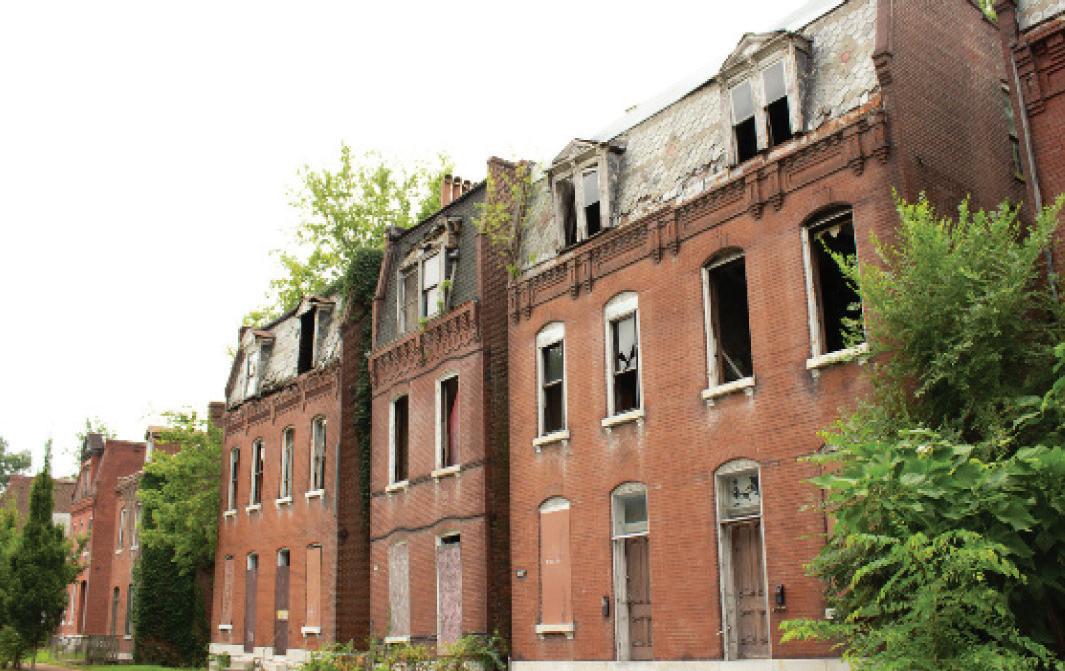
We will increase funding for the Healthy Home and Senior Minor Home repair programs
“This report was designed to inform policymakers, service providers, and the public on the status and needs of the Greater St. Louis senior population.”
According to the Seniors Count of Greater St. Louis Needs Assessment resources are important for helping seniors “age in place,” or stay in their own homes, which seniors today are increasingly opting for rather than moving to assisted living facilities.
The study’s findings indicate “that 56% of seniors fall below the economic security threshold as compared to the estimated 10% rate nationally. This figure is substantially higher than the other two study areas. This indicates that

a significant number of senior households in St. Louis City are likely faced with difficult decisions regarding
health care and everyday living. The study also shows that 40.2% of seniors in St. Louis City have a disability. Frequencies for vision difficulty, cognitive difficulty, self-care difficulty and independent living difficulty are all 20% higher than state averages.”
In addition, “as for most households, the economic security of seniors living independently is determined by the affordability of housing and reliability of income. While most senior households’ incomes are bolstered by public and private retirement savings, many seniors choose or need to remain in the workforce on a full- or part-time basis.”
Getting a seat at the table
Our Proposition provides that the Lessee will make a commitment to achieving long termimprovements in the areas of inclusion, diversity and equality for all and the utilizationof Minority Owned Business Enterprise and/or Women Owned Business Enterprise contractors, subcontractors and vendors attransformational levels in accordance with and beyond those described in any ordinance of the City or any state or federal law or regulation. In the fifth year of the lease and each ensuing year up, but not including the tenth year, the Lessee, its affiliates, or delegates total dollar spend on all contracts with minority and women businesses shall not be less than thirty percent (30%) with at least twenty-two point five percent (22.5%) with African American owned businesses, nine percent (9%) with women owned businesses, one percent (1%) with Latino owned businesses and one percent (1%) with other minority group owned businesses. In the tenth year and every ensuring year of the lease, the Airport Operator, its affiliate, or its delegate’s total dollar spend on all contracts with minority and women businesses shall not be less than forty-five percent (45%) with at least thirty percent (30%) with African American owned businesses, twelve percent (12%) with women owned businesses, two percent (2%) with Latino owned businesses and one percent (1%) with other minoritygroup owned businesses. If in the tenth year or in any ensuing year of thelease the requirements of this section are not met or exceeded, the Lessee shall pay the difference between the actual spend on minority and women owned businesses and the required targets of this section to the City.

It is important to note that the proposition provides that the lessee adhere to “any ordinance of the City or any
state or federal law or regulation” including Ordinance 707067 – that provides for monitoring and compliance.
In the history of the Airport there has only been one black concessionaire, the shoeshine stand
According to the Vendor Due Diligence Report prepared for St. Louis Lambert International Airport: Retail, food, and beverage is the third largest source of non-aeronautical revenue at the Airport, comprising 20 percent of total revenue. In 2019 this revenue total is $11.5 million. There are three Food & Beverage concessionaires at the Airport ( Host International, Inc., Taste, Inc., and OHM Concession Group, LLC) and the merchandise units are operated by HG-St. Luis JV II (Hudson Group). These main concessionaires operate a total of 77 units.
• Host International, Inc. is the prime concessionaire for food & beverage, operates 93 percent of the food & beverage units, and has 89 percent of the food & beverage sales at the airport.
• The Hudson Group operates 100 percent of the merchandise units at the Airport.
• OHM Concession Group, LLC operates a single casual dining unit in Terminal 2.
Car rental is the second largest source of non-aeronautical revenue at the Airport, comprising 22 percent of total revenue. In 2019 the total revenue was $12.5 million. Currently, three rental car companies operate eight brands at the Airport. These include the Hertz Corporation, which operates the Hertz and Dollar/Thrifty brands; Enterprise Holdings Incorporated, which operates the Enterprise, Alamo, and National brands; and the Avis Budget Group, which operates the Avis and Budget brands. It is important to note that under the Airport Concessions Disadvantaged Business Enterprise (ACDBE) Programs, rental concessions achieved only 1% in participation.
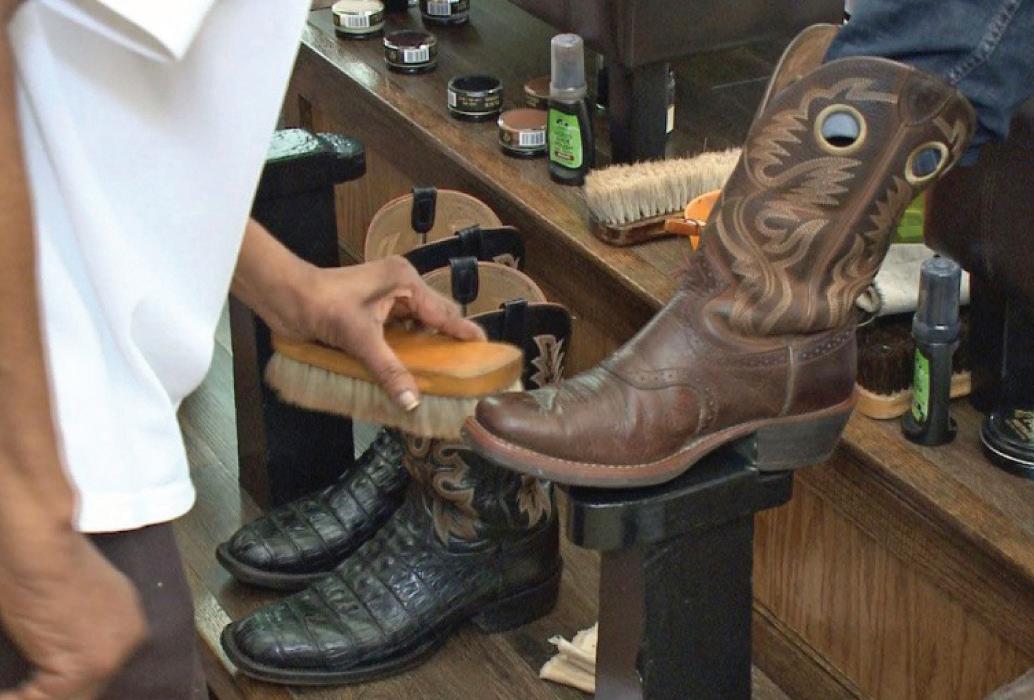
INFRASTRUCTURE CASE STUDY:
San Juan Airport

SUMMARY
PROJECT TYPEYEARDEAL STRUCTURE
Airport 2013 Long-term operating lease
TOTAL COST
$615millionpaidupfrontbyprivatepartner,plus$2.5millioneachyear for the first five years, 5 percent of revenue over the next 25 years, and 10 percent of revenue for the final ten years
FINANCING
Private equity and debt-financing investment-grade bonds
FUNDING
Airport parking, concessions, and fees
PUBLIC BENEFIT
Modernizationandrenovationsofairportfacilities,andjobcreation
Background
Luis Muñoz Marín International Airport in San Juan, Puerto Rico, was privatized in 2013 through the U.S. Federal Aviation Administration (FAA) Airport Privatization Pilot Program (APPP). The partners involved were the public airport owner, Puerto Rico Ports Authority, the Puerto Rico P3 Authority, and Aerostar—a 50-50 venture between Highstar Capital, an infrastructure investor, and Grupo Aeroportuario del Sureste SAB de DV, which operates nine airports in Mexico. The process took four years to complete and resulted in a 40-year lease under the Aerostar name.
Project Description
The Luis Muñoz Airport privatization was made possible by the APPP, 1997 FAA program. This originally allowed for five airports to apply for and begin the process of privatization, with one of them being a “large hub.”1
The program was expanded under the 2012 Reauthorization Act to include up to ten airports.2 Currently, there have been two successful privatizations out of ten applications. Stewart International in Newburgh, New Jersey, was the first to be privatized in 2000; however, the Port Authority of New York and New Jersey bought the airport in 2007. San Juan is the only other to successfully privatize. Chicago has filed and withdrawn an application for Chicago Midway International Airport.3
Operating under the Puerto Rico P3 Act of 2009, the Ports Authority, the owner of the airport at the time, applied to the APPP program in 2009. The next step was a desirability report to detail what could be gained from a P3. Puerto Rico’s P3 Authority, a government-owned corporation under the authority of the governor and tasked with negotiating and regulating P3s in the state, then studied the idea and released a report in 2010 advocating for a P3 agreement.4 The report said that the existing airport did not serve passenger needs well and needed reform in order to be financially stable.
The report also reasoned that this could be achieved by a private sector agent with experience in airport operations. After the release of the report, the P3 Authority issued a Request for Proposal in June 2011. In May 2012, it was announced that Aerostar and Grupo Aeroportua Avance were the two consortiums on the shortlist for the project. In July 2012, it was announced that the consortium under the name Aerostar had won the contract.5
As long as profitability holds, the partnership will come out with a win. Puerto Rico got $615 million in an upfront leasehold fee, followed by $2.5 million each year for the first five years, 5 percent of revenue over the next 25 years, and then 10 percent of revenue for the final ten years. The upfront lease payment was financed via $265 million of private equity (43 percent) and $350 million from debt financing of investment-grade bonds (57 percent).6 The airport (and the public it serves) received modernized facilities as an upfront investment around $400 million.7 This leaves most future profits with Aerostar.
The U.S. Government Accountability Office studied the APPP in November 2014 and found some key barriers to privatization: financing costs are higher for private entities, property tax exemptions may not carry over to the private owner, and the program has unclear rules and an intrusive federal presence that slows the process.8 However, as the report notes, privatization occurs across a spectrum, with a long-term lease or sale at the most extreme end. Many airports are finding more success with different levels of private involvement, ranging from simple service contracts, to management contracts (for example, specific facility management to airport-wide management), to developer financing/operation contracts (for example, specific facility development).
Benefits and Criticisms
The privatization of San Juan’s airport worked due to a unique set of factors. First, there was political will, despite some public opposition. There was some worry that the privatization could disenfranchise workers at the airport, but the U.S. transportation secretary guaranteed that approval of the plan would not go through if the collective bargaining agreement (CBA) was violated; furthermore, the CBA signed in 2012 guaranteed that any employee who did not stay in their position under privatization would be given another position within the Ports Authority under the same contract.9
Commissioner Pedro R. Pierluisi, delegate to the U.S. House of Representatives, said that the privatization process was in line with what Congress had intended with the creation of the APPP program and that, given the Puerto Rico Ports Authority’s bond status—one level above junk in 2009—it was clear that the Ports Authority could not provide the investment needed for a 21st-century airport.10
Takeaways
The privatization of San Juan’s Luis Muñoz International Airport is so far the only success story of the FAA’s APPP pilot program. Under the P3, the airport has seen considerable investment, with Terminal A reopening in 2012 and serving as a regional hub for Jet Blue, Terminal B reopening in 2014, and Terminal C renovations completed in March 2016. These renovations include an automated baggagescanning system, in use in only a few U.S. airports, and high-end retail stores, which have created 3,000 jobs.12
On the spectrum of P3s, San Juan Airport leans far toward privatization. Importantly, there was the political will to privatize a poorly managed airport, and there was profit to be made by private actors. This case study is representative of a situation where the public sector may want to privatize an unprofitable endeavor and private industry is in fact well suited to make important changes that recover profitability.
Endnotes
1. Federal Aviation Administration, 2013. http://www.faa.gov/news/fact_sheets/news_story.cfm?newsId=14174
2. Ibid.
3. Ibid.
4. Study of Desirability and Convenience for Luis Muñoz Marin International Airport, June 2010. http://www.app.gobierno.pr/wp-content/uploads/2010/10/ PuertoRicoAirport1.pdf and http://www.app.gobierno.pr/?page_id=960&lang=en.
5. Commonwealth of Puerto Rico, Puerto Rico Public-Private Partnership Authority. http://www.app.gobierno.pr/?page_id=960&lang=en
6. U.S. Government Accountability Office, Report to Congressional Addressees, 2014. http://www.gao.gov/assets/670/667076.pdf
7. Bob Sechler, “Puerto Rico Airport to Go Private,” The Wall Street Journal, 2013. http://www.wsj.com/articles/ SB10001424127887323699704578328583512502920?cb=logged0.869674347468345
8. U.S. Government Accountability Office, Report to Congressional Addressees, 2014. http://www.gao.gov/assets/670/667076.pdf
9. Federal Aviation Administration, “FAA response to comments regarding the participation of Luis Muñoz Marin International Airport,” 2013. http://www.app. gobierno.pr/wp-content/uploads/2013/02/U_S_DOT_FAA_-_Public_Comments_Summary.pdf.
10. Ibid.
11. News is my Business, “LMM Airport officials unveil new $55M Terminal C,” March 18, 2016. http://newsismybusiness.com/lmm-airport-officials-unveil-new55m-terminal-c/
12. Danica Coto, “Puerto Rico airport to unveil $200M in upgrades,” USA Today, 2014. http://www.usatoday.com/story/todayinthesky/2014/07/02/puerto-ricossan-juan-airport-to-unveil-200m-renovations/11943569/
THE FIGHT FOR FREEDOM:
Pruitt calls for revived NAACP St. Louis American Dec 16, 2010
Road to Missouri U.S. Senate seat runs through black pulpits MCT, From MCT Jul 19, 2010
NAACP battles at front line for social justice St. Louis American, Apr. 2012
NAACP offers MSD Community Benefits Agreement
St. Louis American, July 26, 2012
Tony Messenger and Adolphus PruittSt. Louis American, Jun 5, 2013
NAACP tackles achievement St. Louis American, Aug 1, 2013 Updated Aug 1, 2013
NAACP begins seven-day march Saturday from Ferguson to Jefferson City as response to grand jury decision
By Jiayue Huang for the MISSOURIAN Nov 30, 2014
‘It’s a problem everywhere’DW Aug 14, 2014
St. Louis To Expand Police Minority Recruitment Program
St. Louis Chinese American News, Nov 4, 2014
Adolphus Pruitt, Adrian Wright and Jeffrey MittmanSt. Louis American, Apr 29, 2015
STL city celebrates ‘Building Union Diversity’graduating class, launches site to connect to construction jobs
St. Louis American, Jun 1, 2015 Updated Jun 2, 2015

Kwame: MBE got 31.8 percent of Central Riverfront Project American staff, Feb 26, 2015 Updated Apr 13, 2016
Renovated riverfront reopens, had 32 percent MBE participation St. Louis American, Jun 9, 2016
KEA breaks ground in STL -
St. Louis American, Jul 2, 2014 Updated Apr 13, 2016
Regional leaders start loan fund for minority and women contractors
St. Louis American, Jun 4, 2015 Updated Apr 13, 2016
Public School District, NAACP claim state withholding desegregation funds KMOV-TV, June 15, 2016
Credit union opens Gateway Branch St. Louis American, Mar 3, 2016 Updated Mar 3, 2016
St. Louis NAACP says girl, 13, accused of shooting couple at beauty supply store is ‘not a monster’ St. Louis Post Dispatch, Oct 5, 2016
Girl, 13, who shot couple at Bellefontaine Neighbors beauty supply store pleads guilty St. Louis Post Dispatch, December 6, 2016
TIF Commission approves $42M for central corridor projects, projects include three new hotels
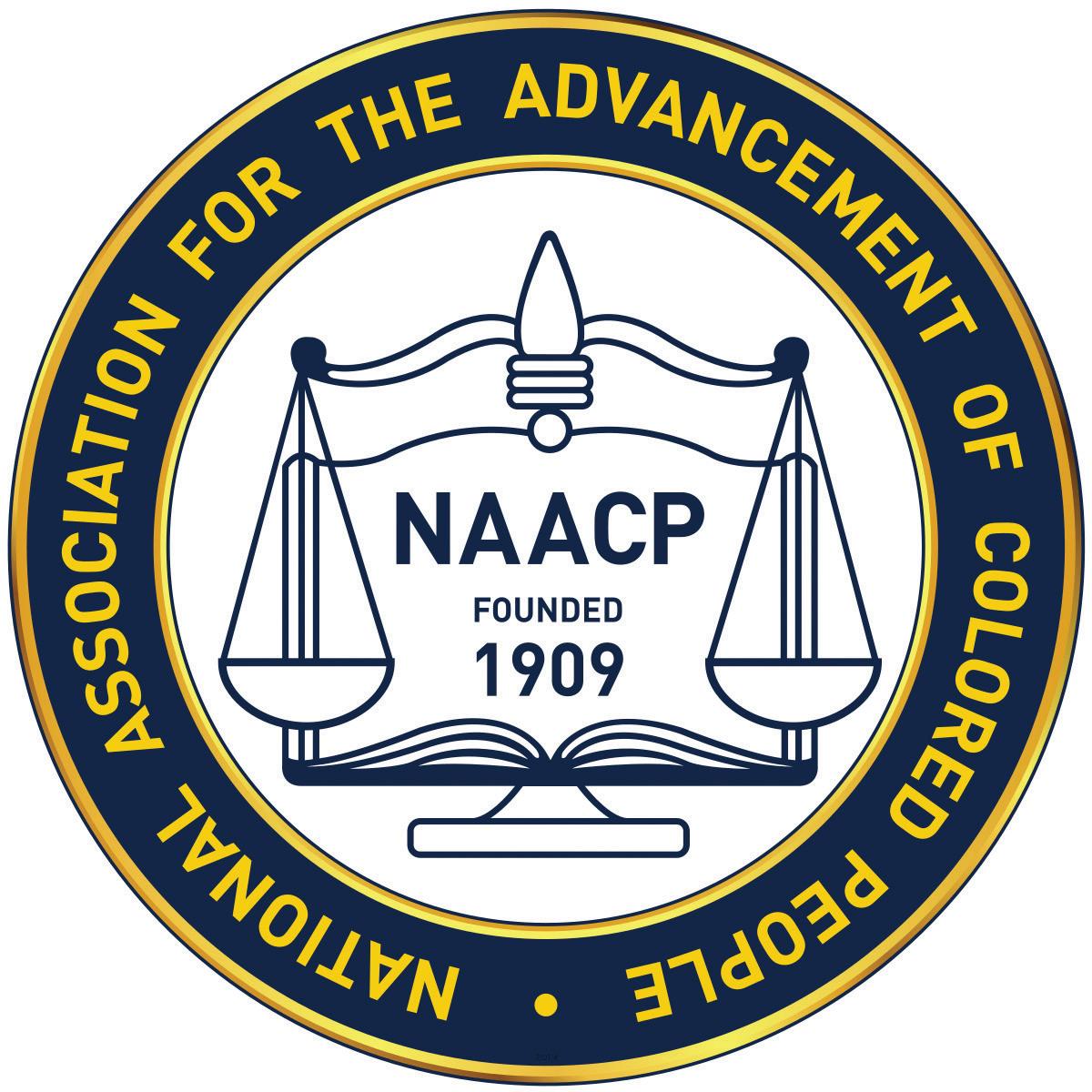
and a pharmacy in the Delmar Loop St. Louis American, Jan 5, 2017 Updated Feb 22, 2017
Pruitt vows the NAACP will monitor privatization process at St. Louis airport
The St. Louis American, Jun 29, 2017
NAACP reports claims of discriminatory work environment at Southwest Airlines in St. Louis St. Louis Business Journal Jun 27, 2017,
Nordstrom Rack apologizes to teens wrongly accused of shoplifting at Brentwood store, president flies St. Louis to meet with teens and families
St. Louis American, May 8, 2018
St. Louis Airport Employees Face ‘Civil Rights Crisis,’ NAACP Says RFT, Nov 14, 2018
America’s Center $175-million expansion stalls out at St. Louis County Council St. Louis American, Mar 20, 2019
America’s Center plan has a cherry on top for north St. Louis County St. Louis Post Dispatch, Apr 15, 2019
St. Louis NAACP Head Seeks Investigation Into Minority Hiring Under Stenger, St. Louis Public Radio, September 17, 2019
Metropolitan St. Louis Sewer District settles challenge to workforce diversity agreement St. Louis Post Dispatch Jan 25, 2018
Youth at St. Louis’Juvenile Detention Center poisoned by lead for years, study says St. Louis Post Dispatch, Jul 21, 2020
